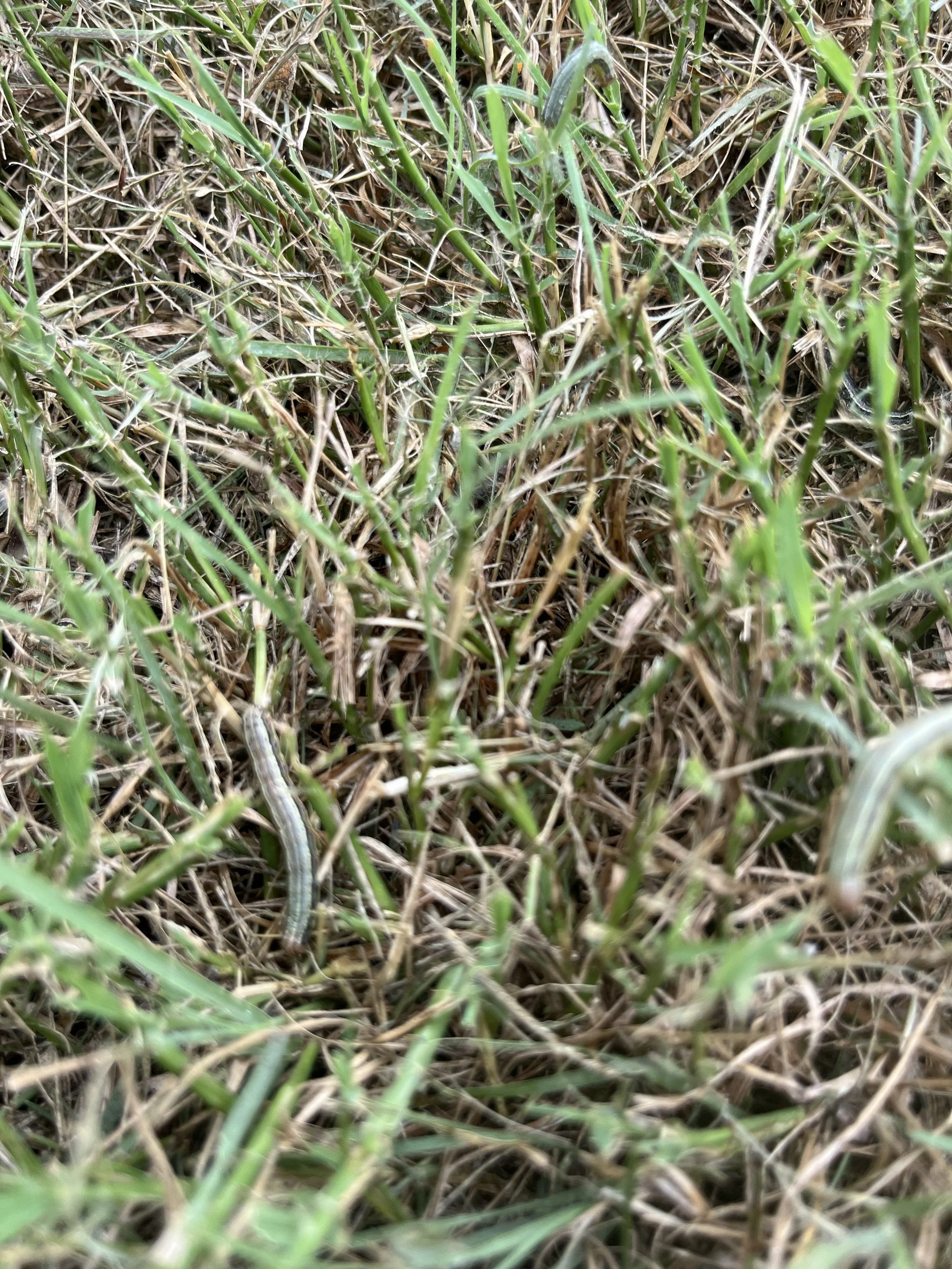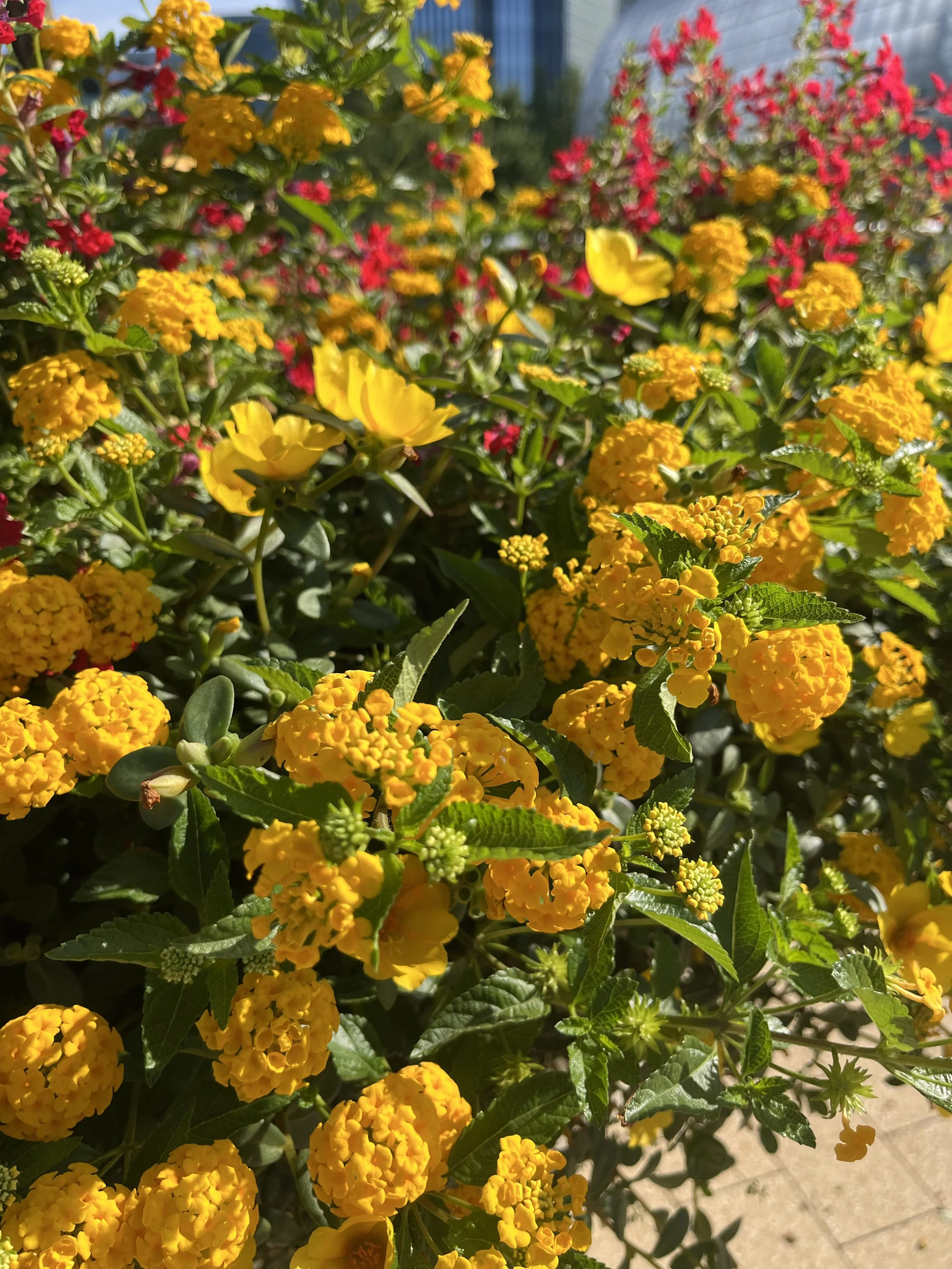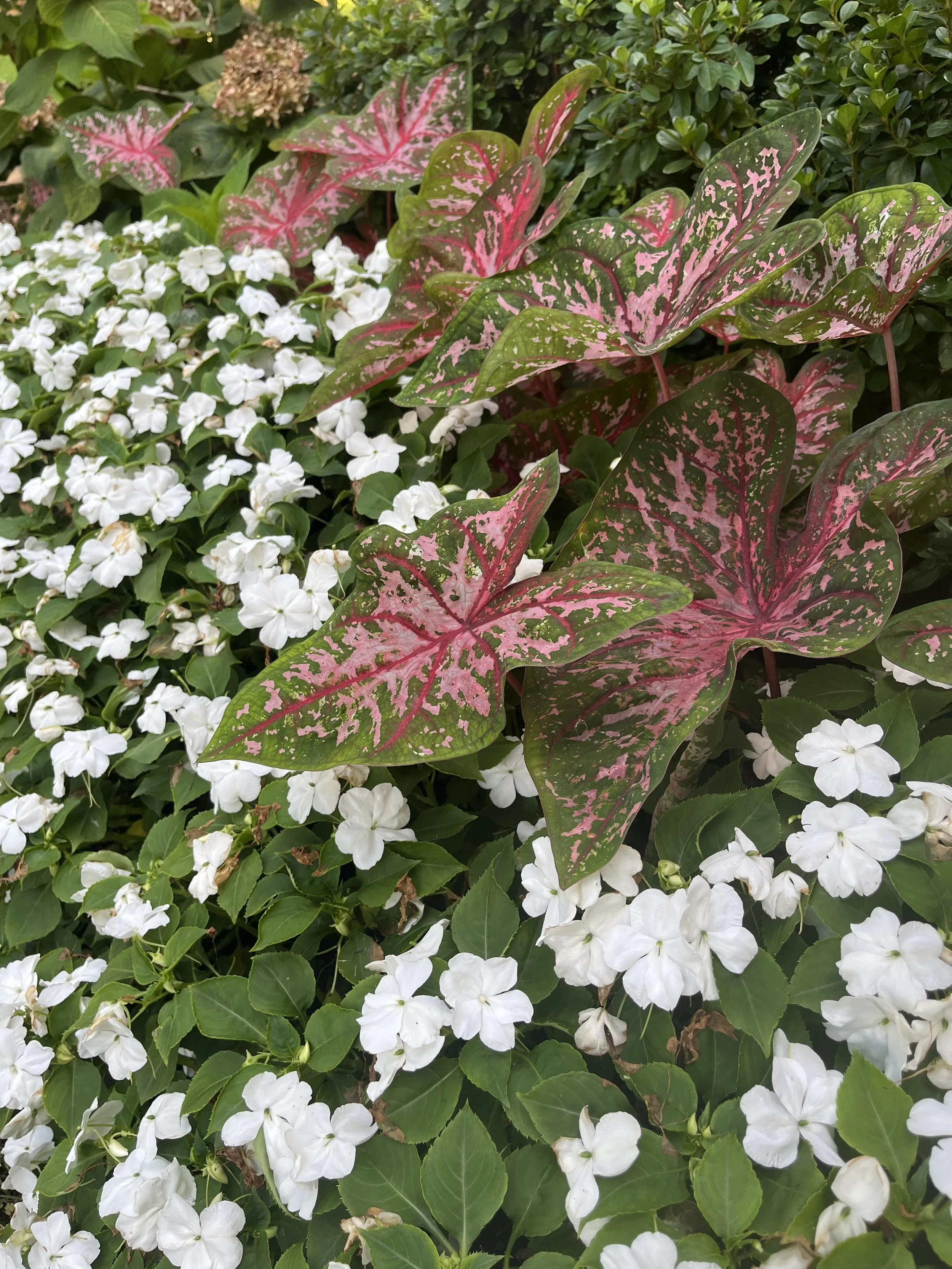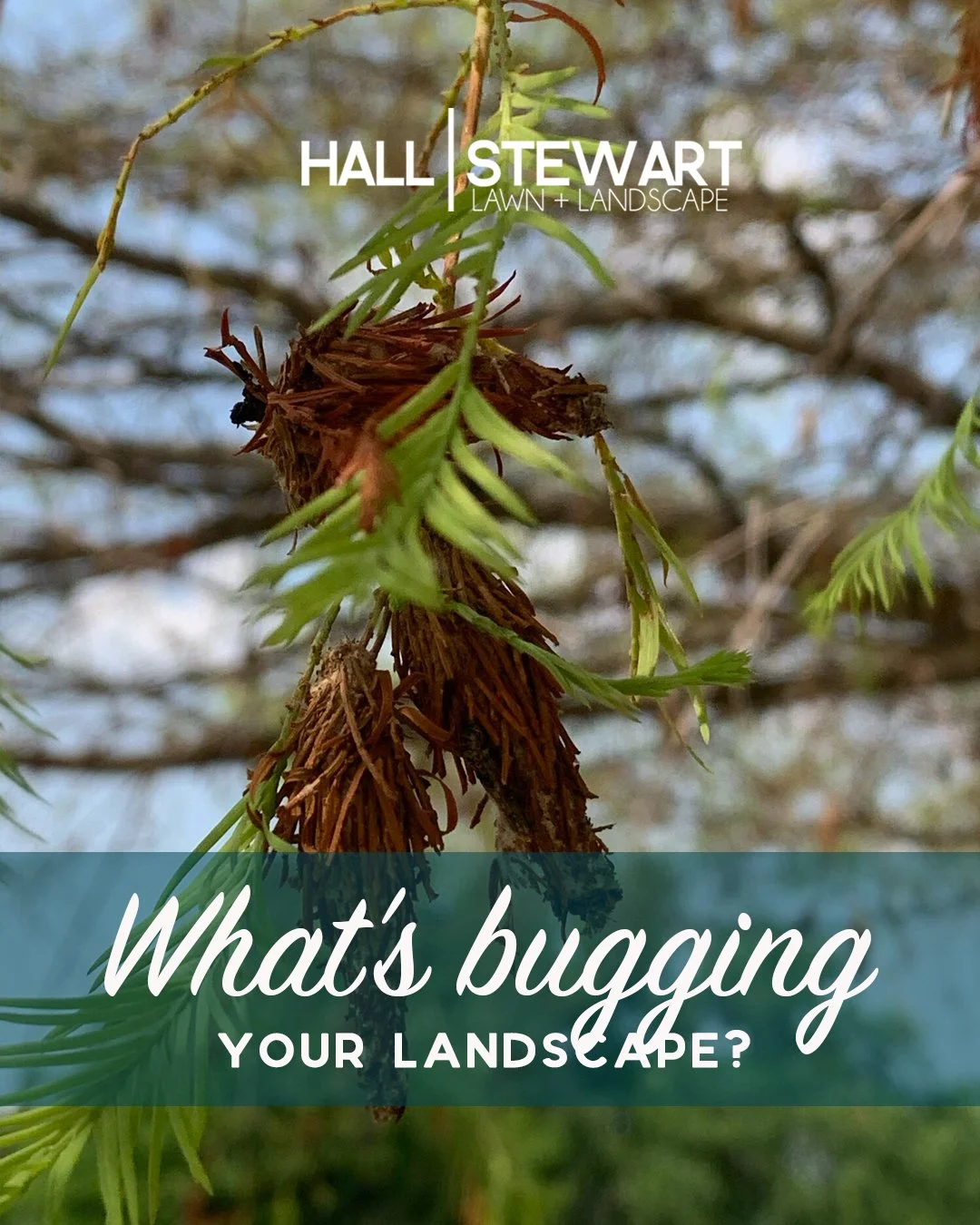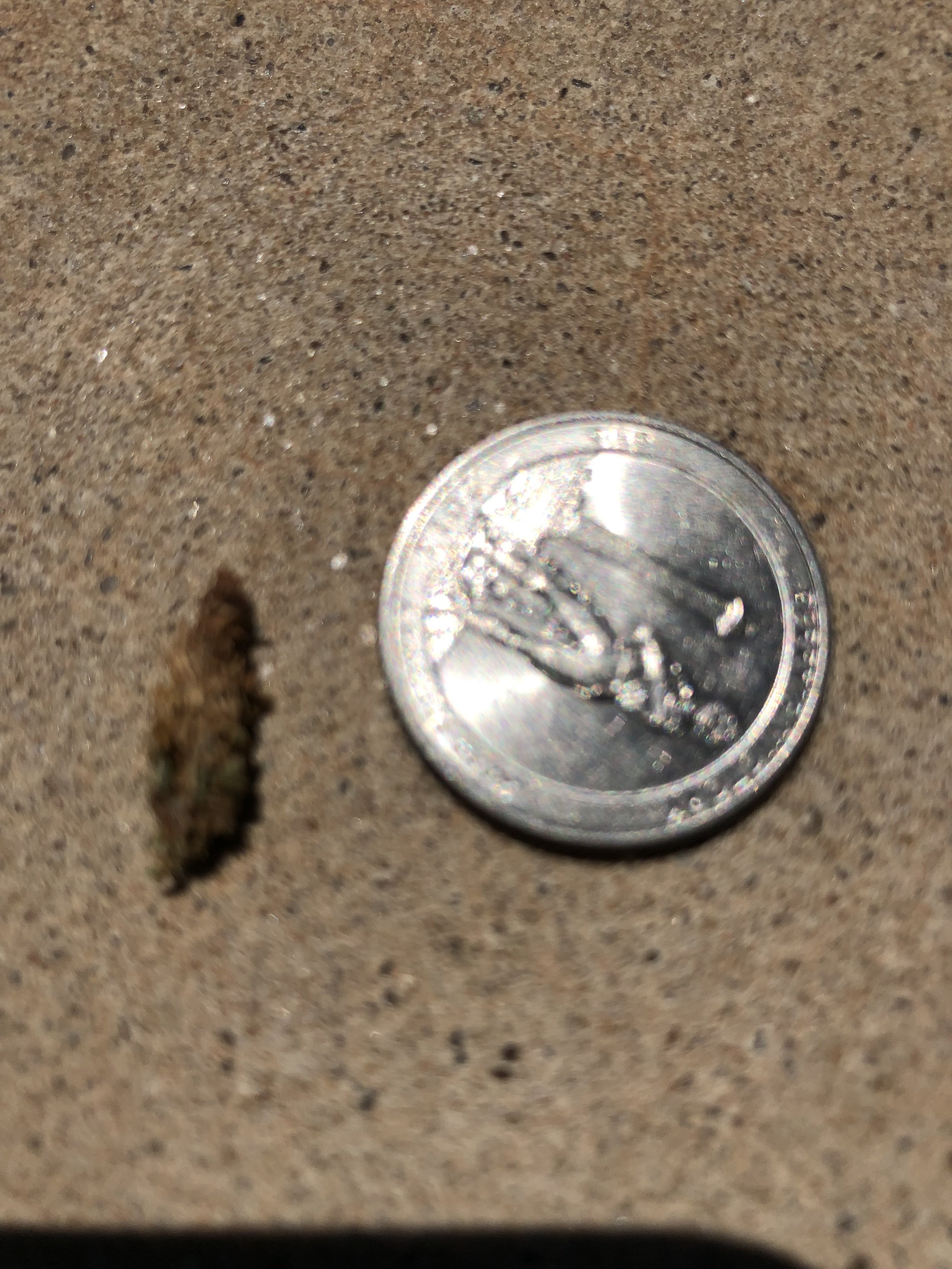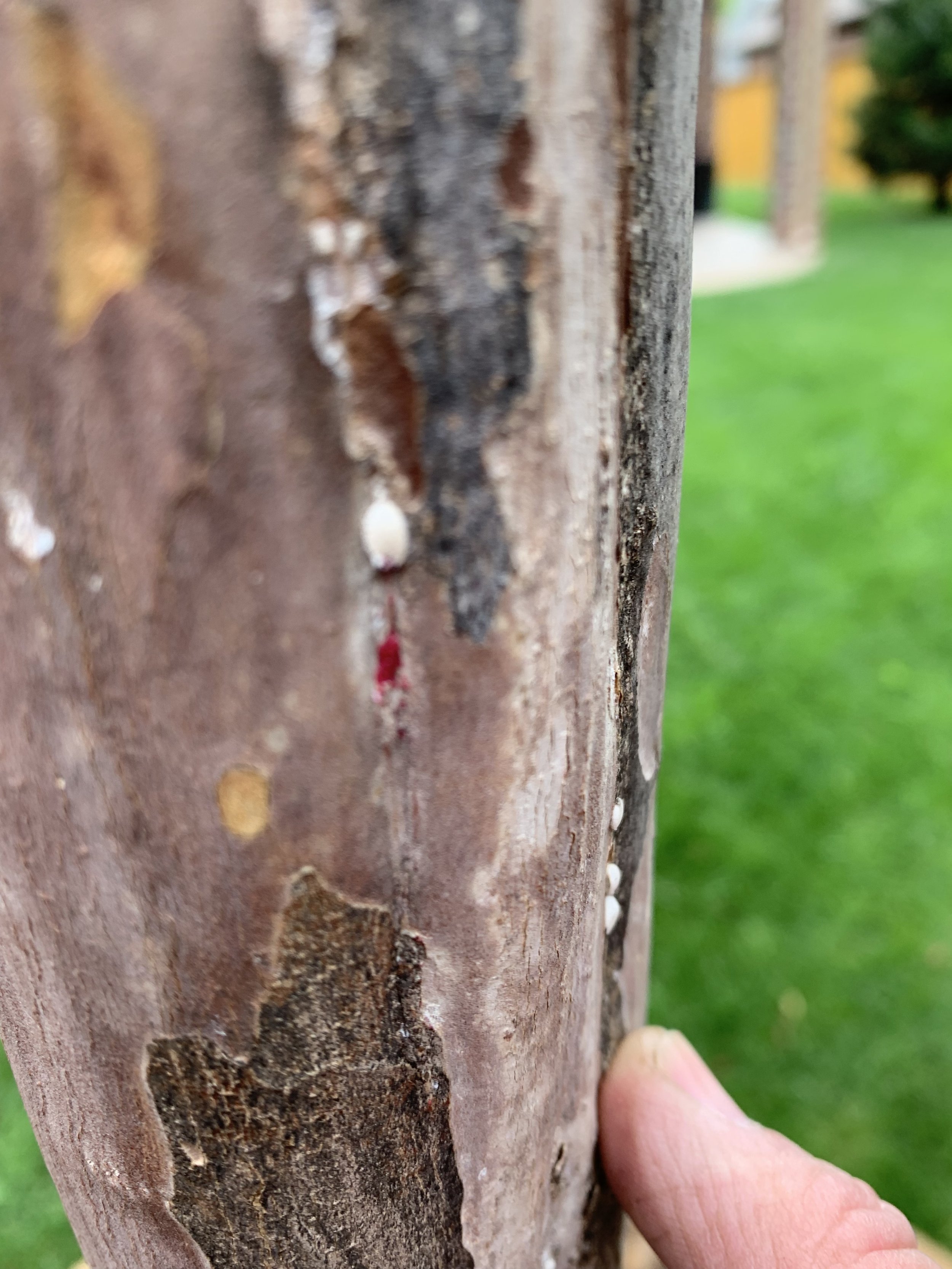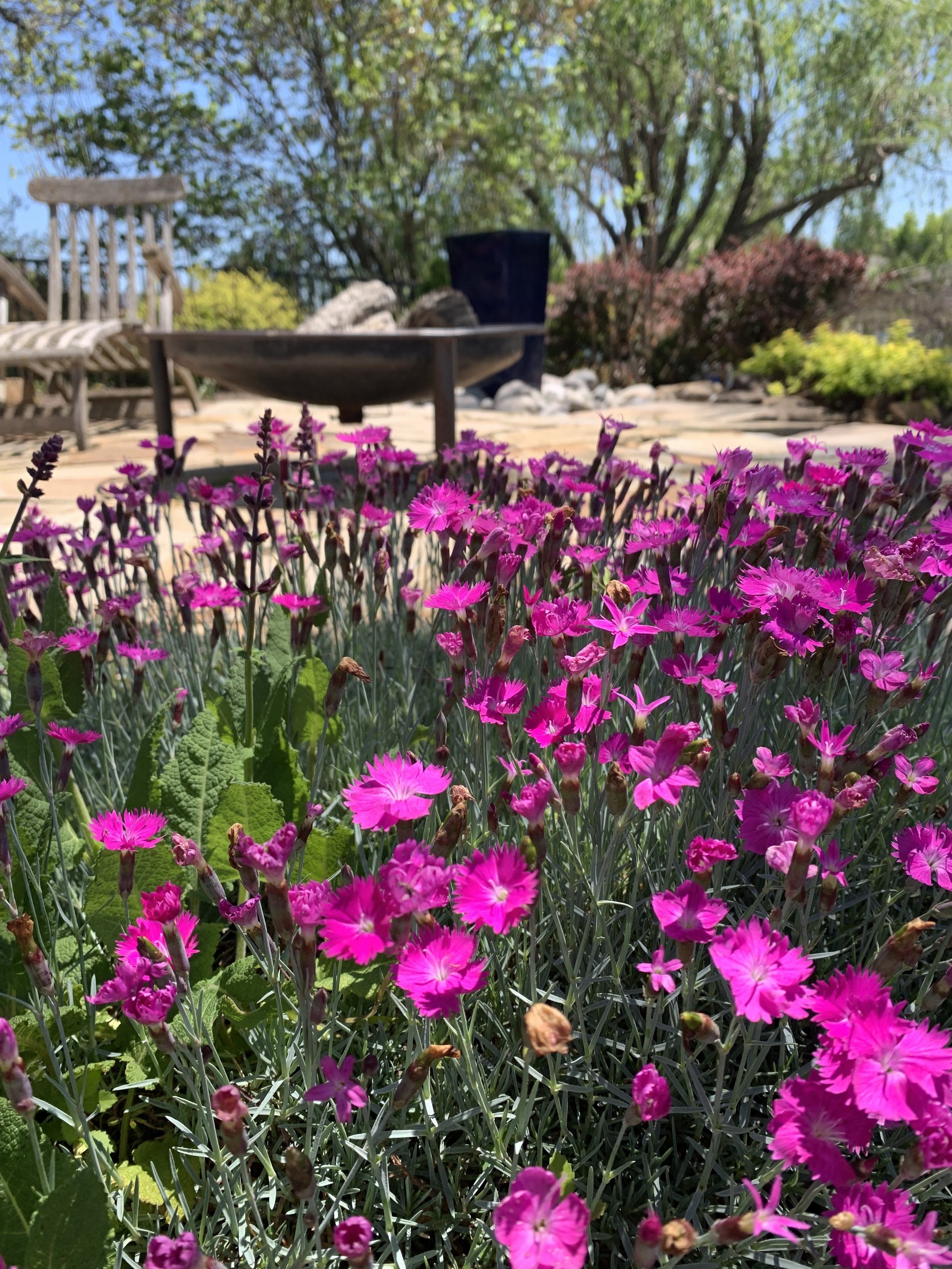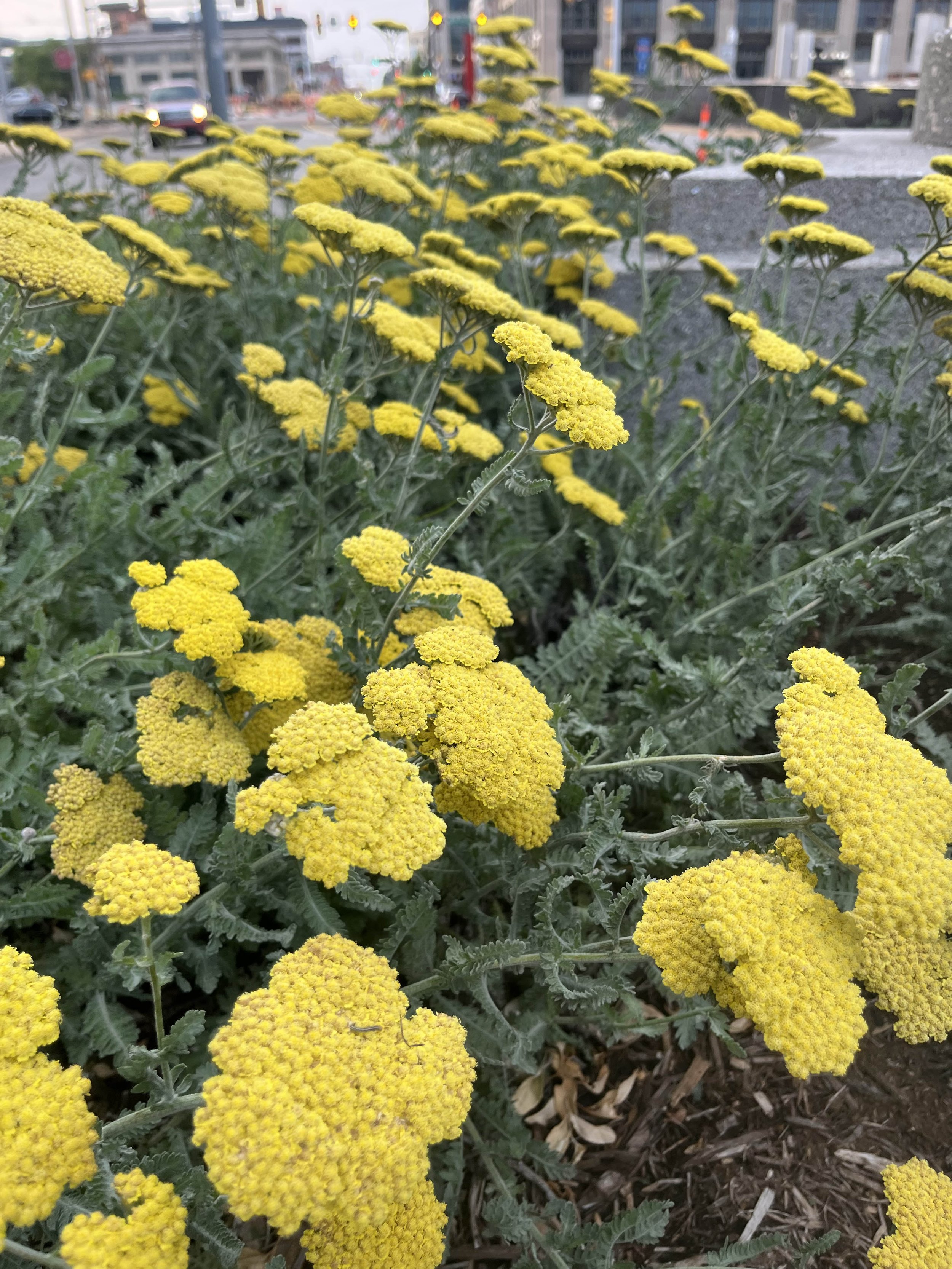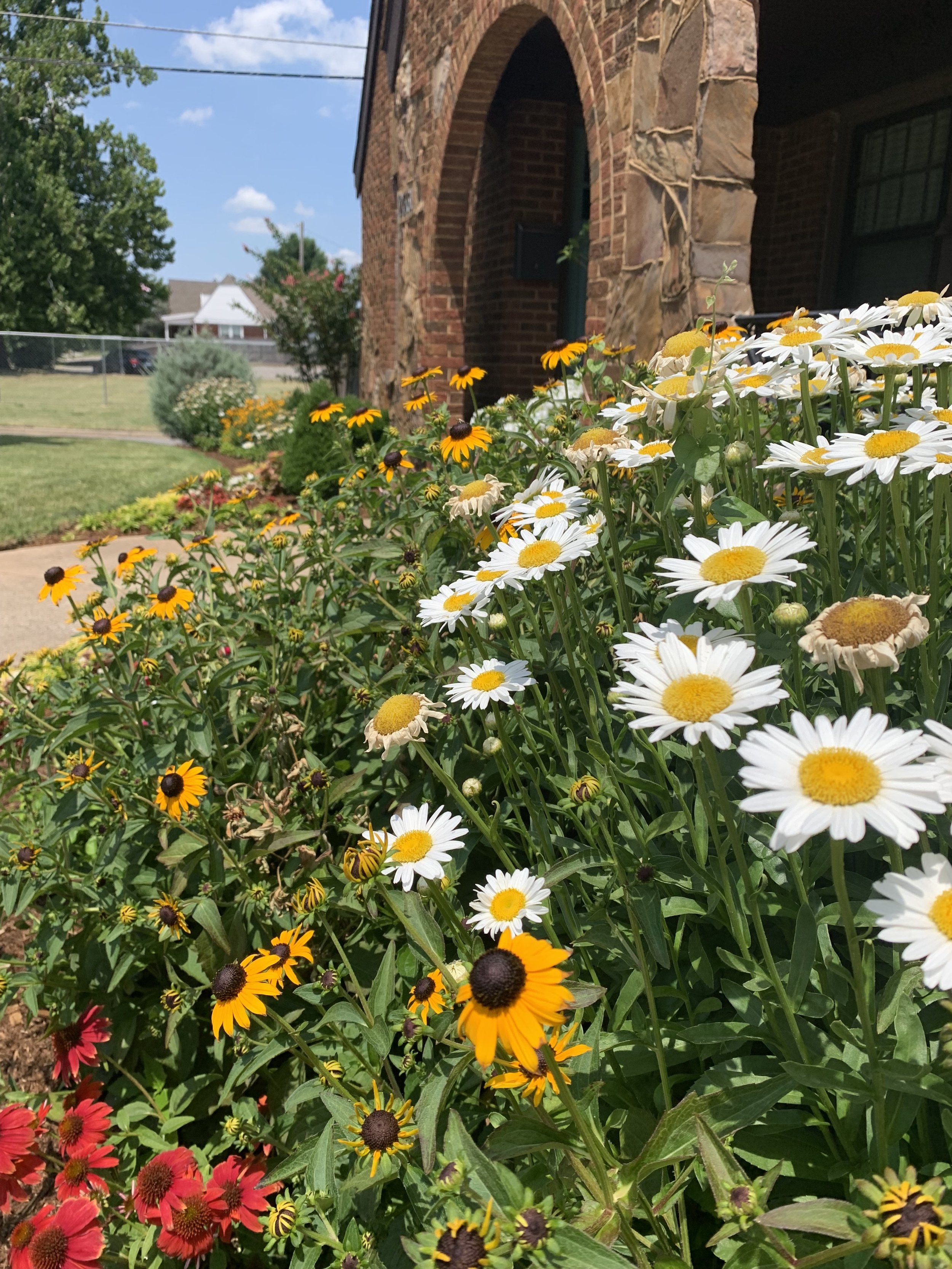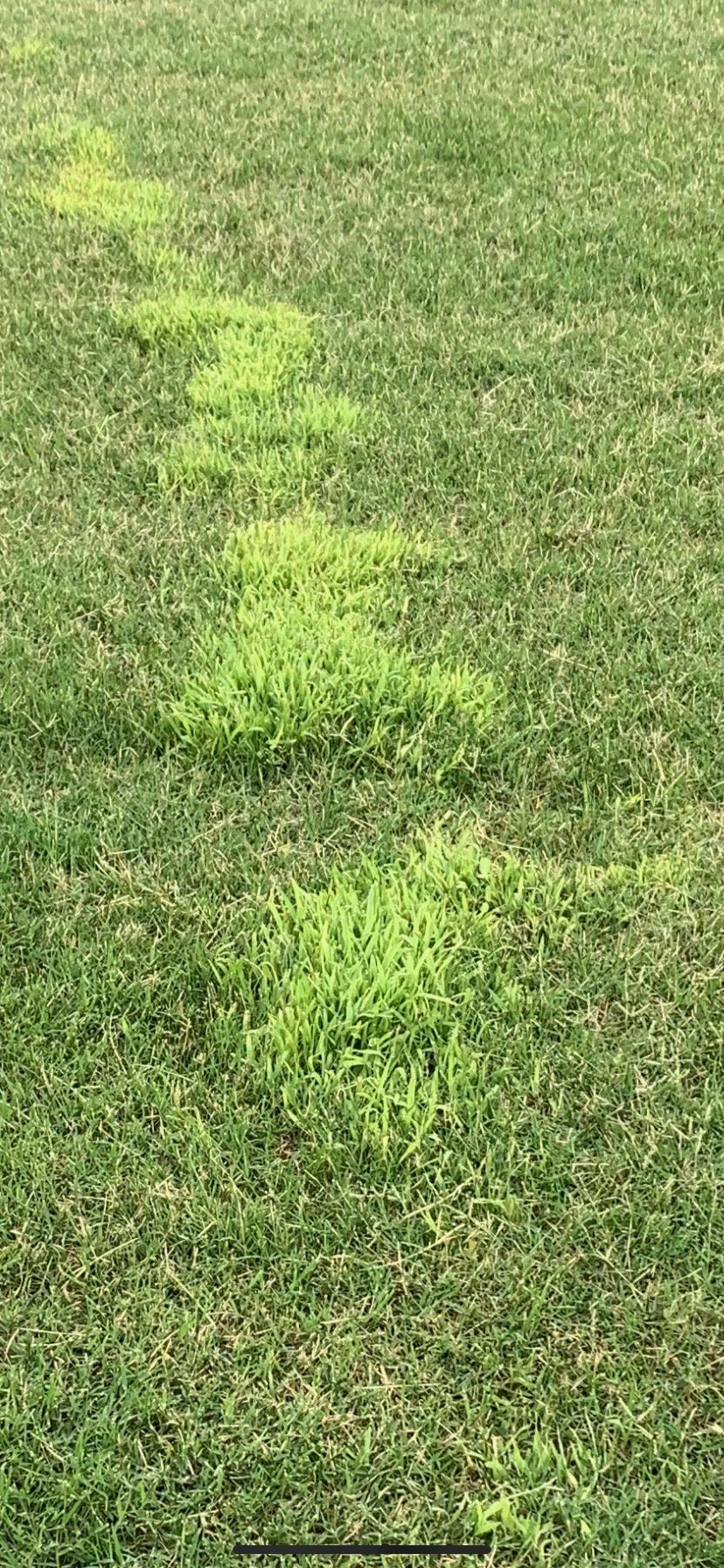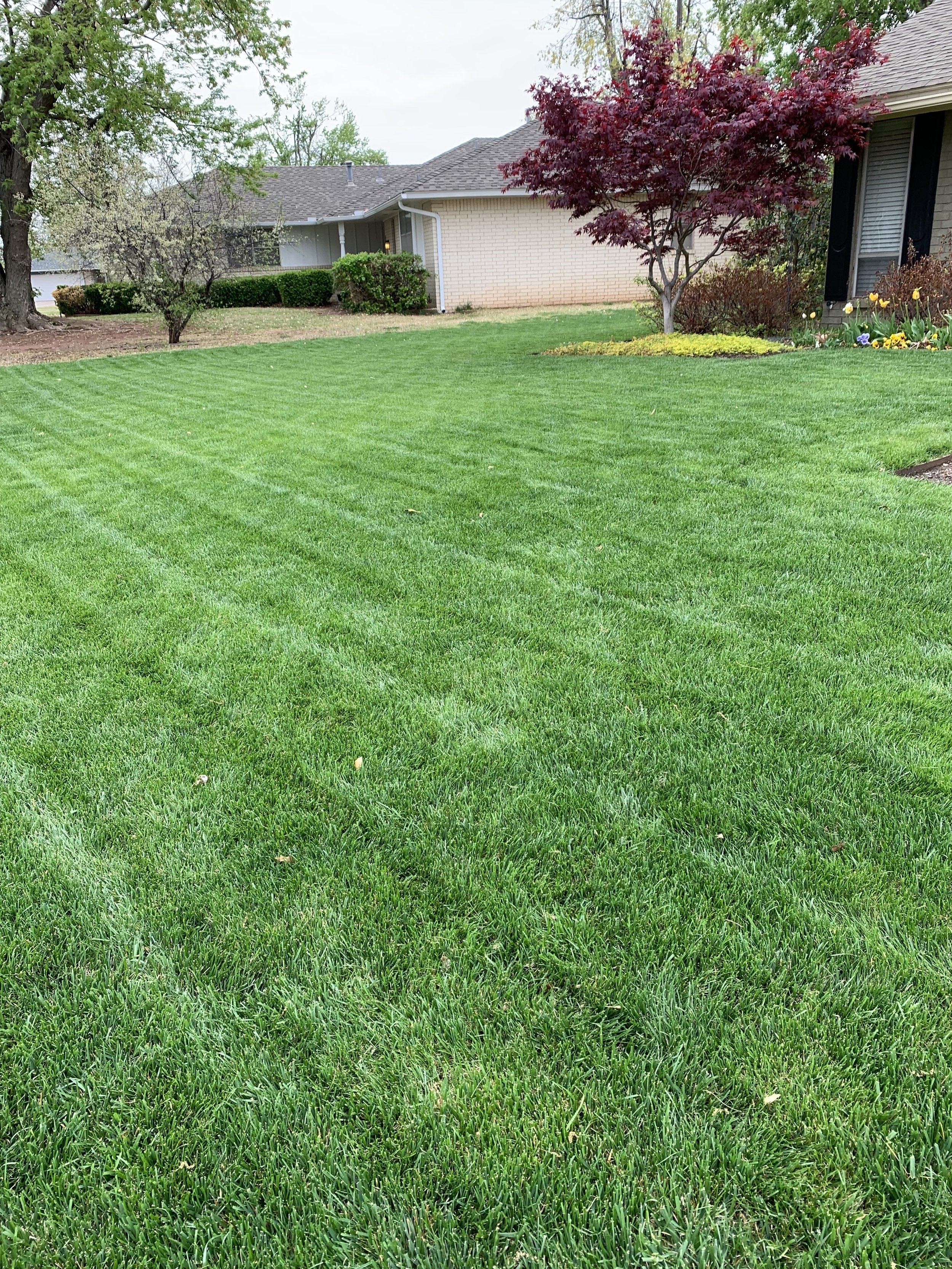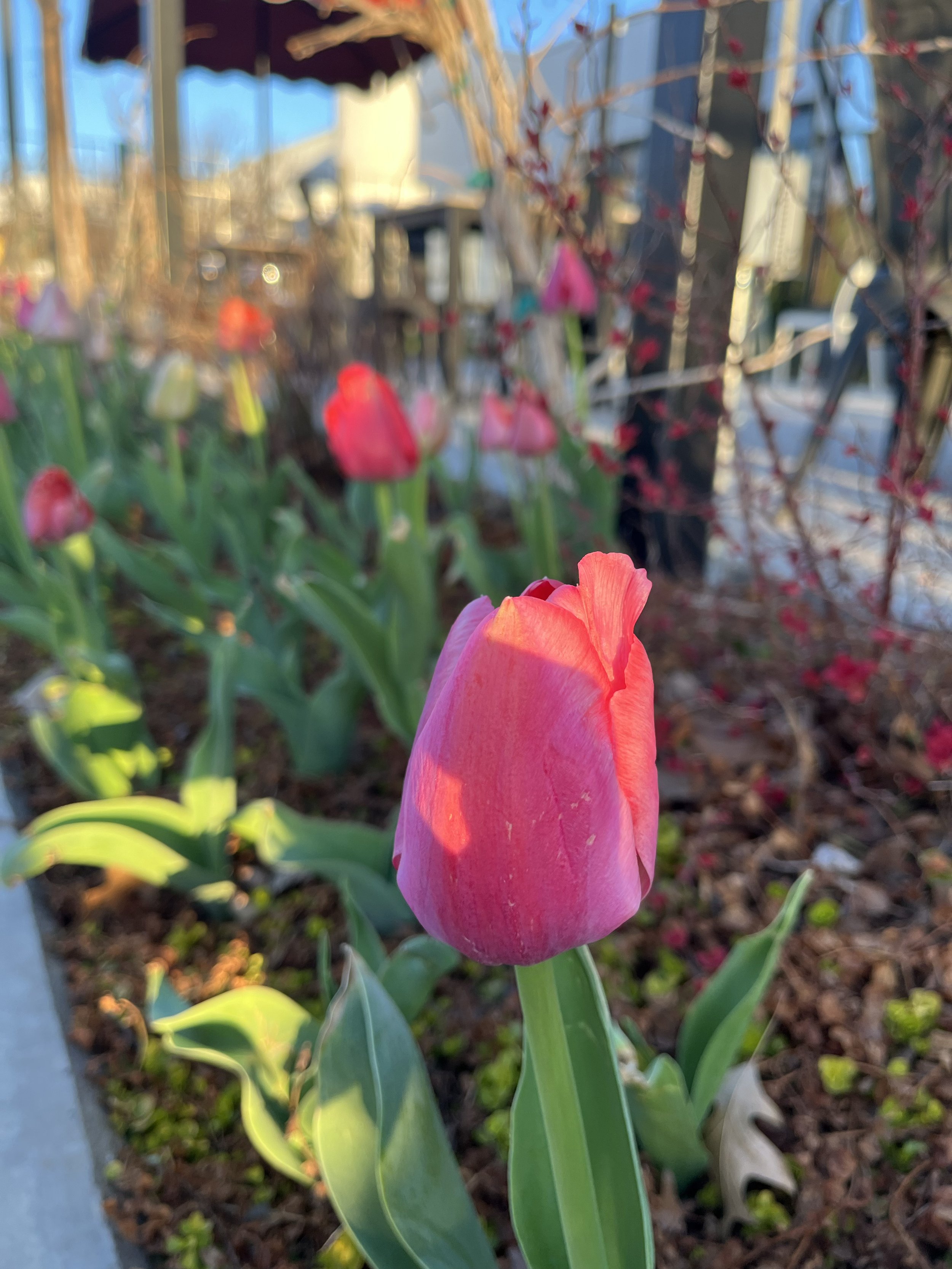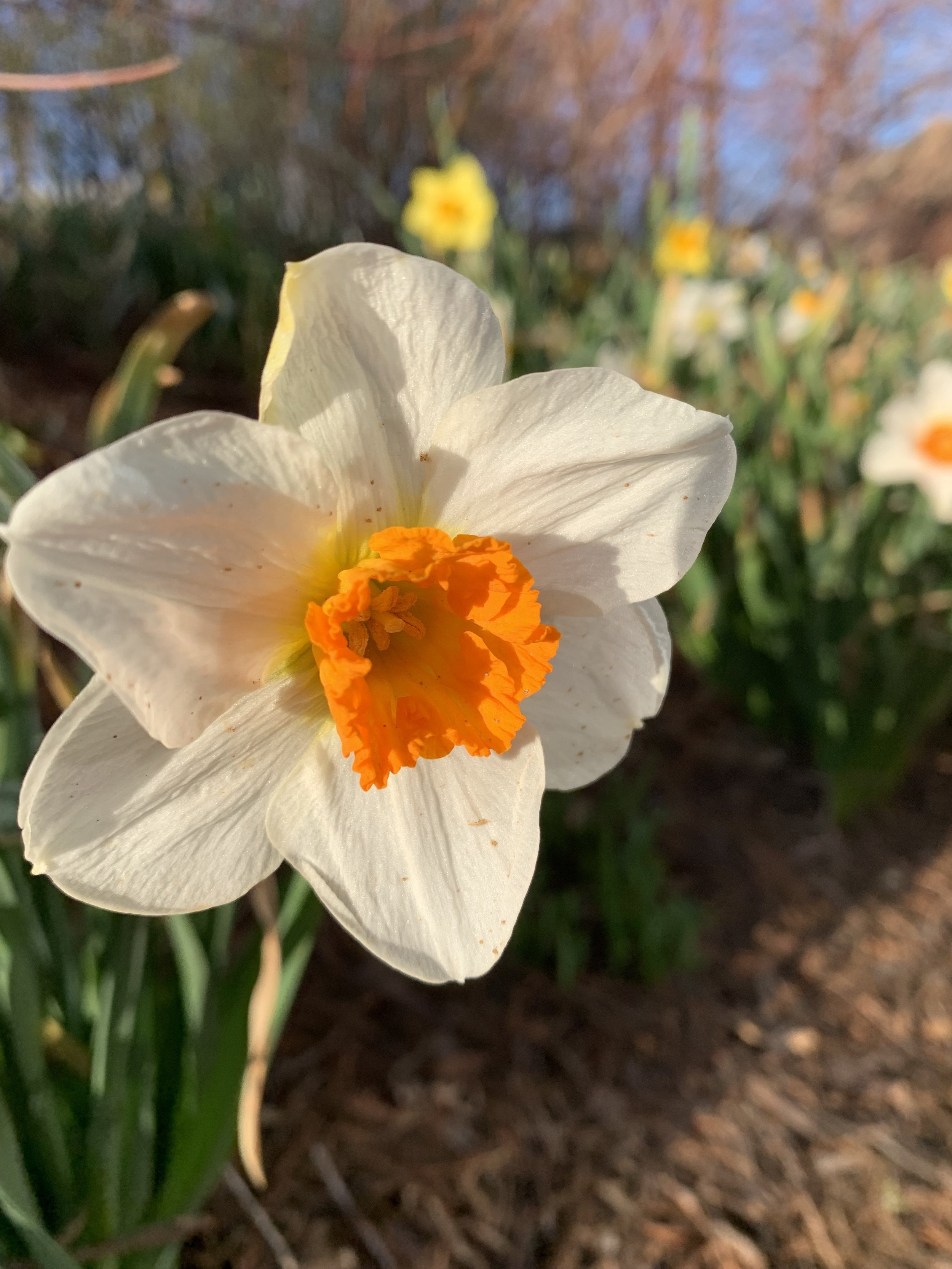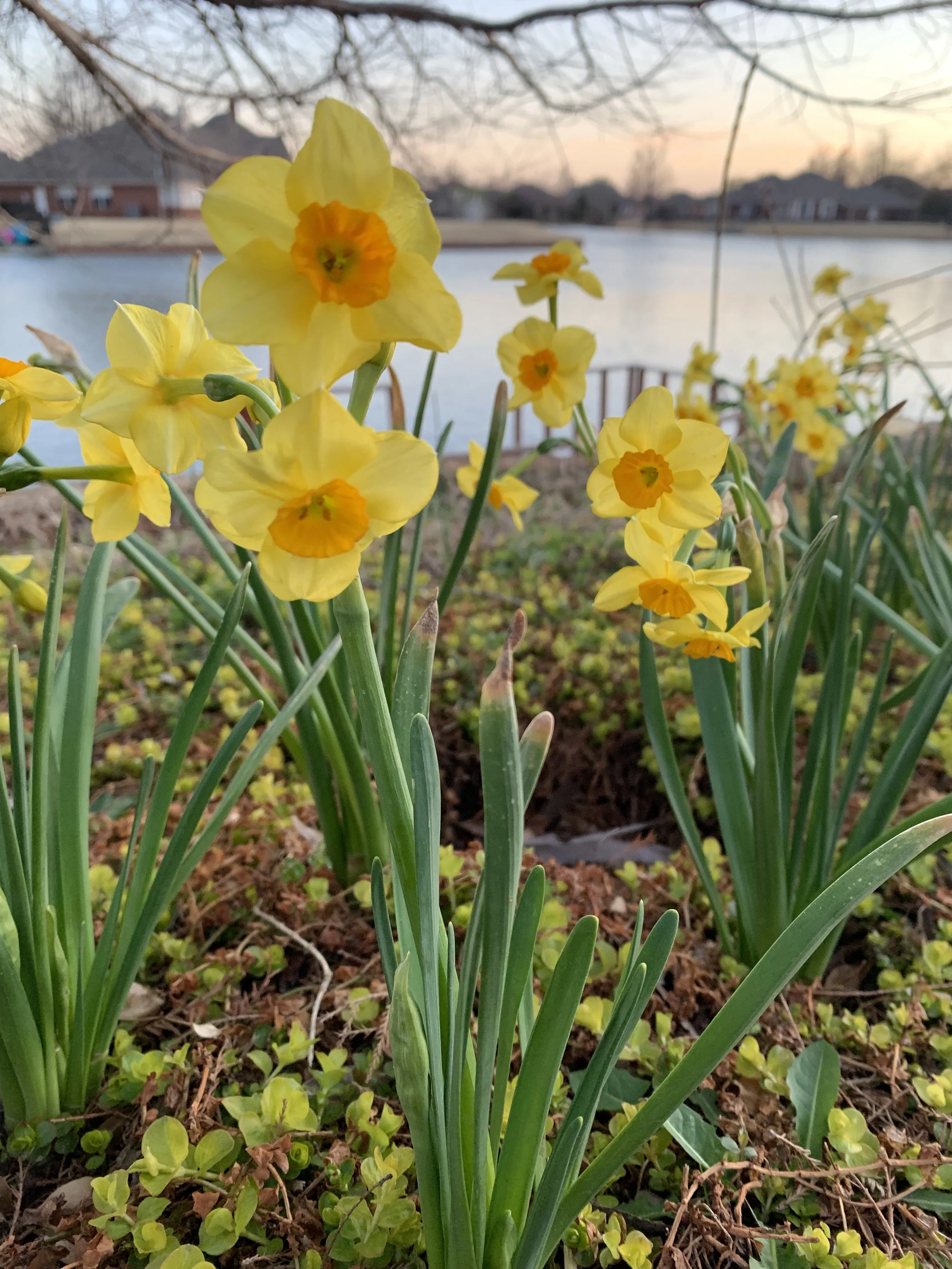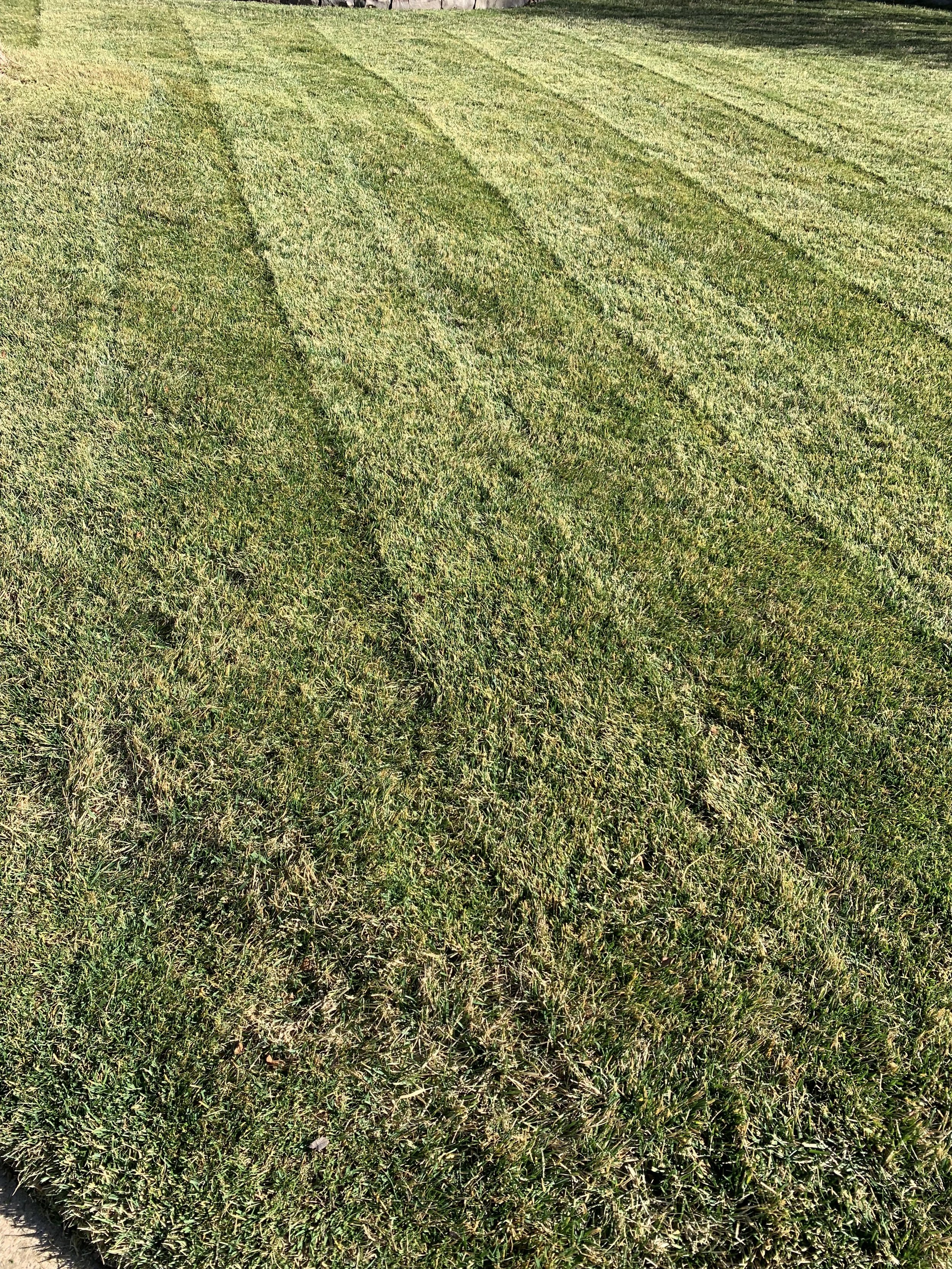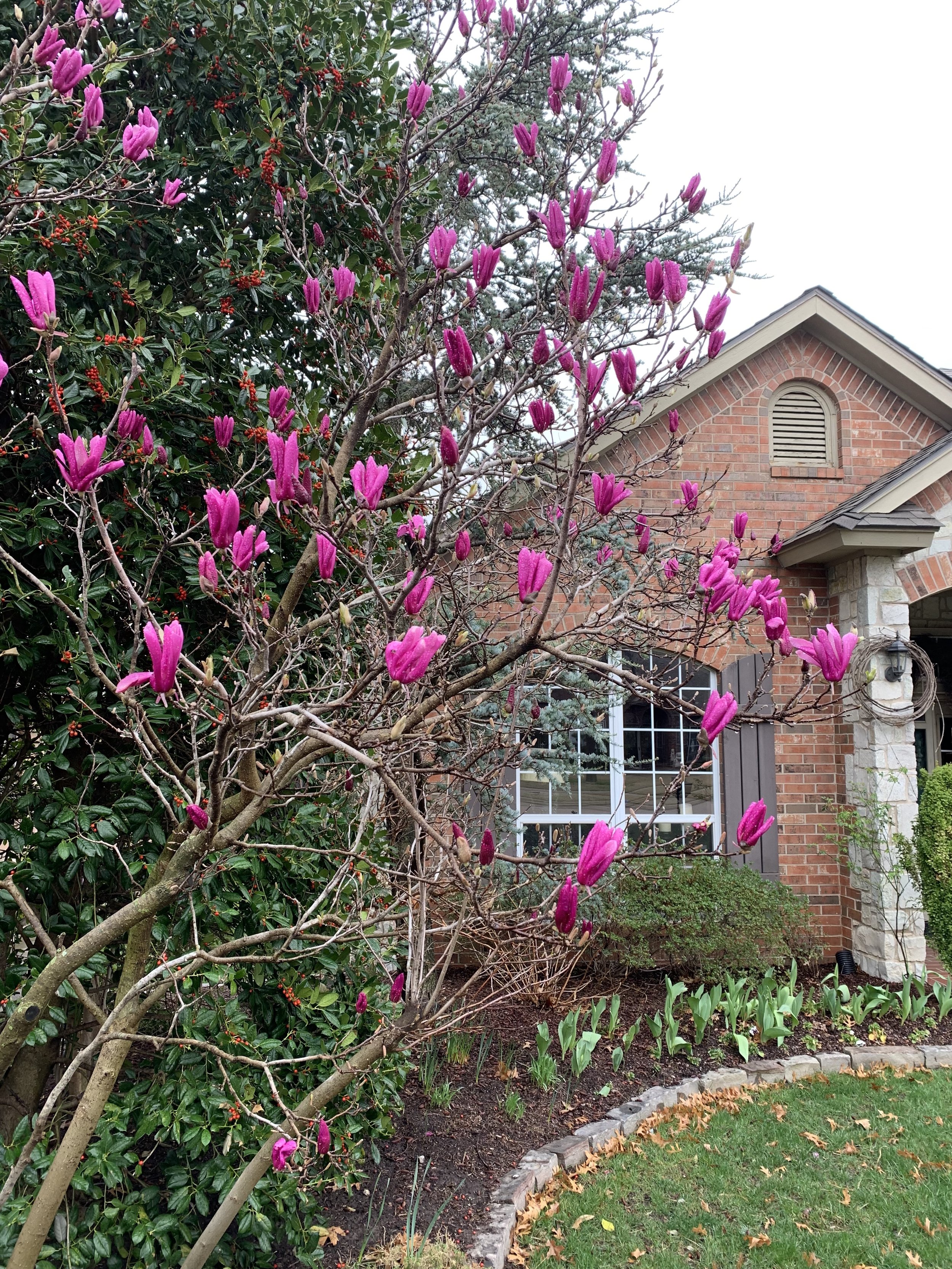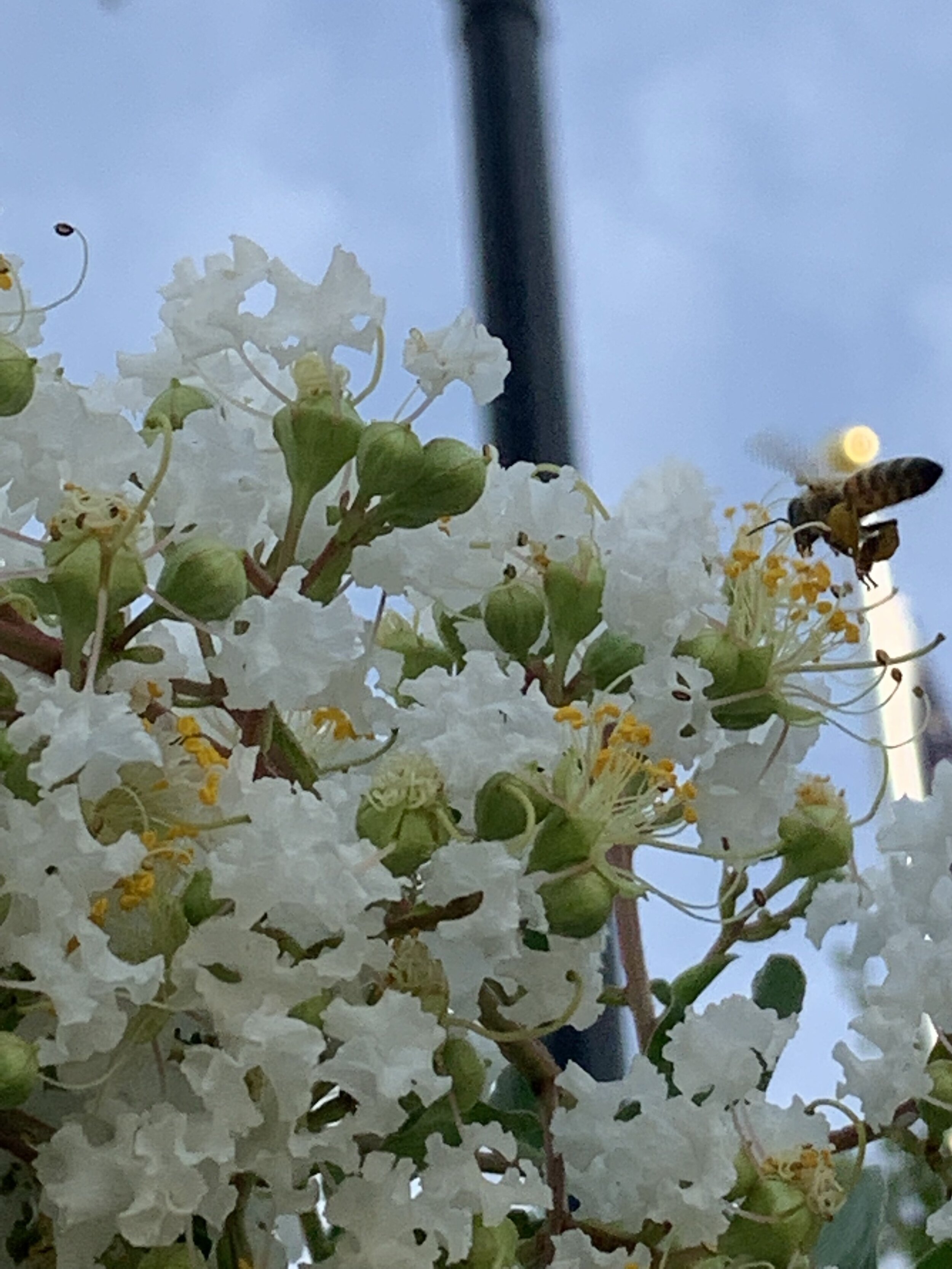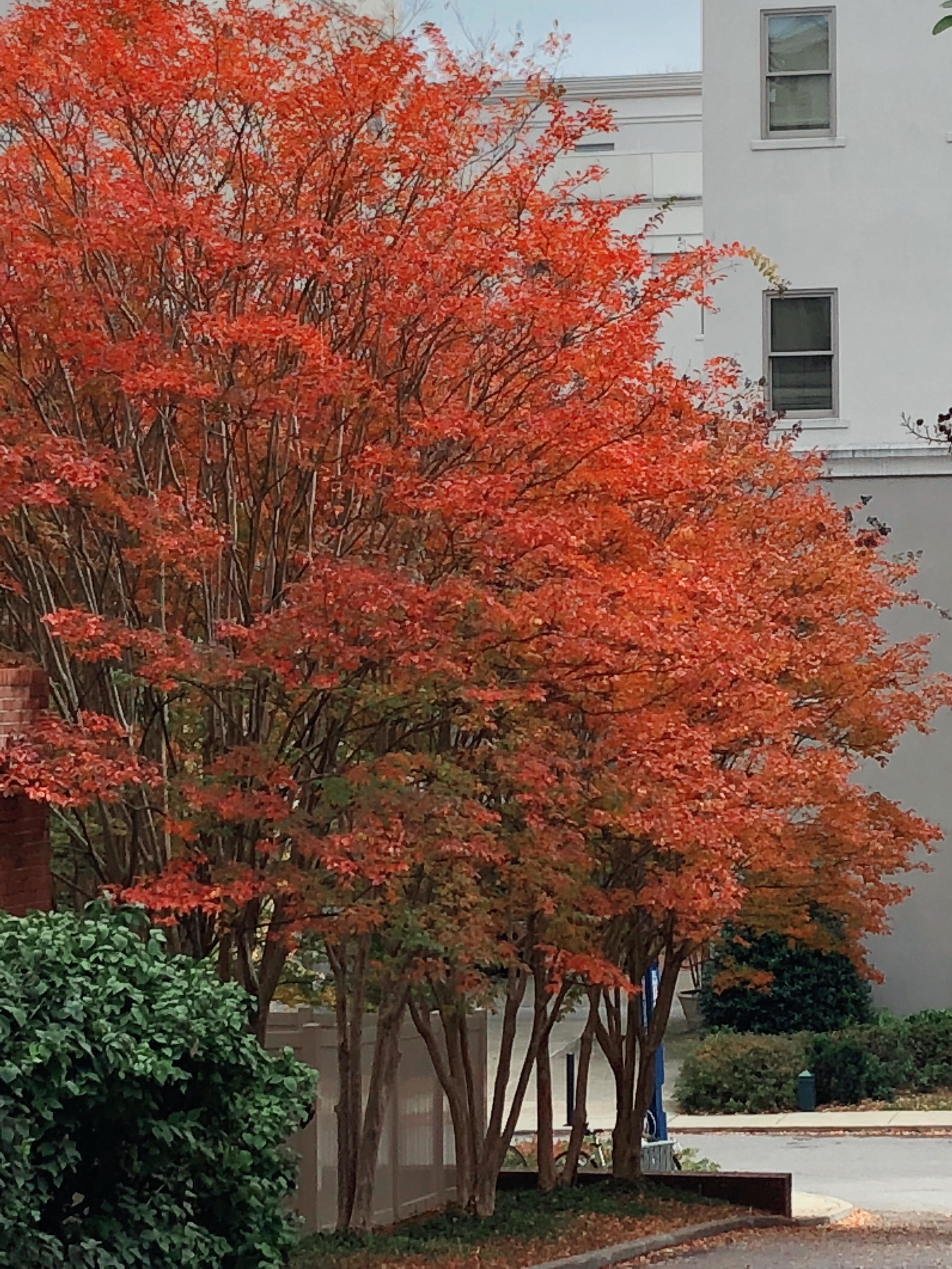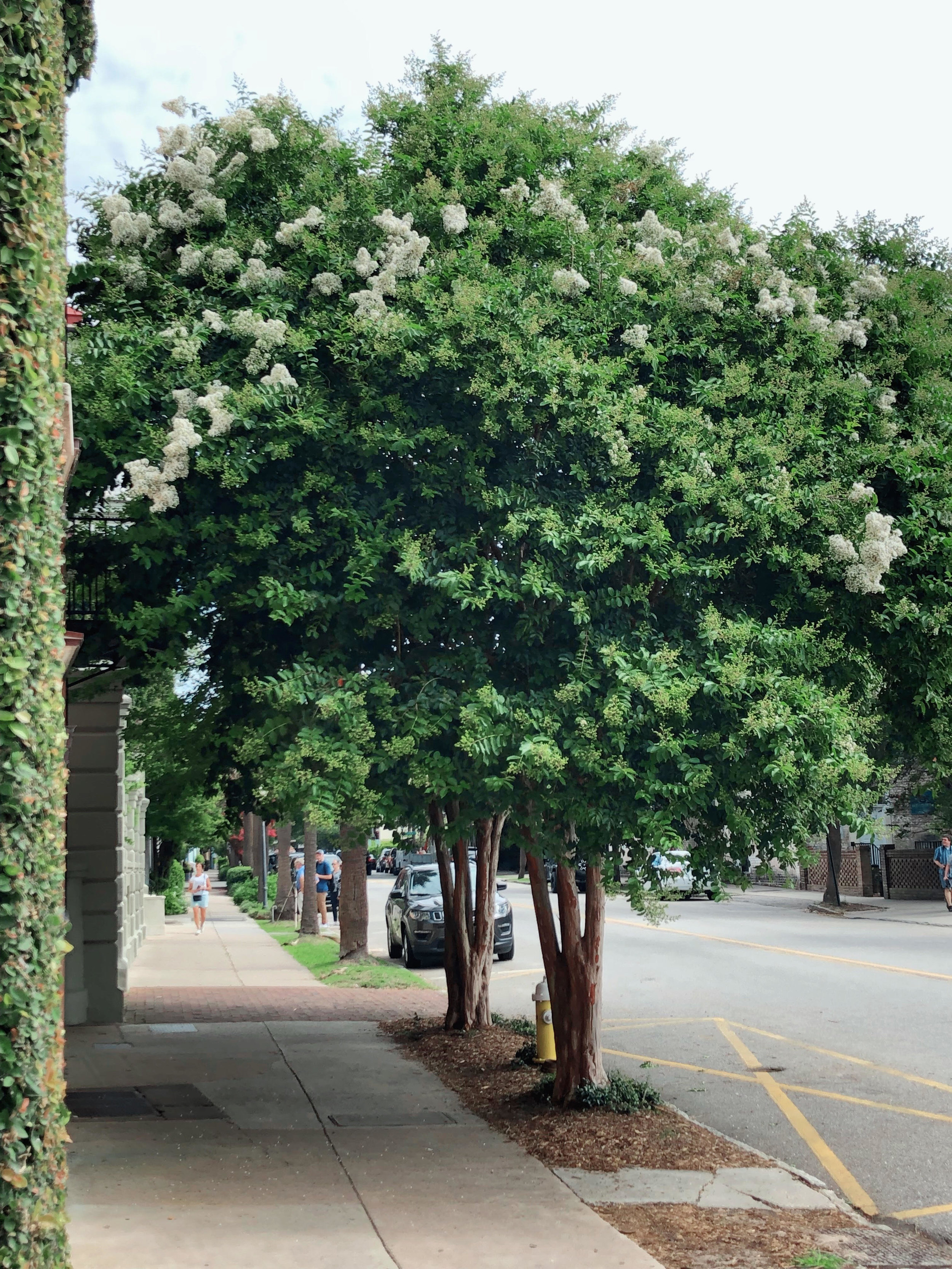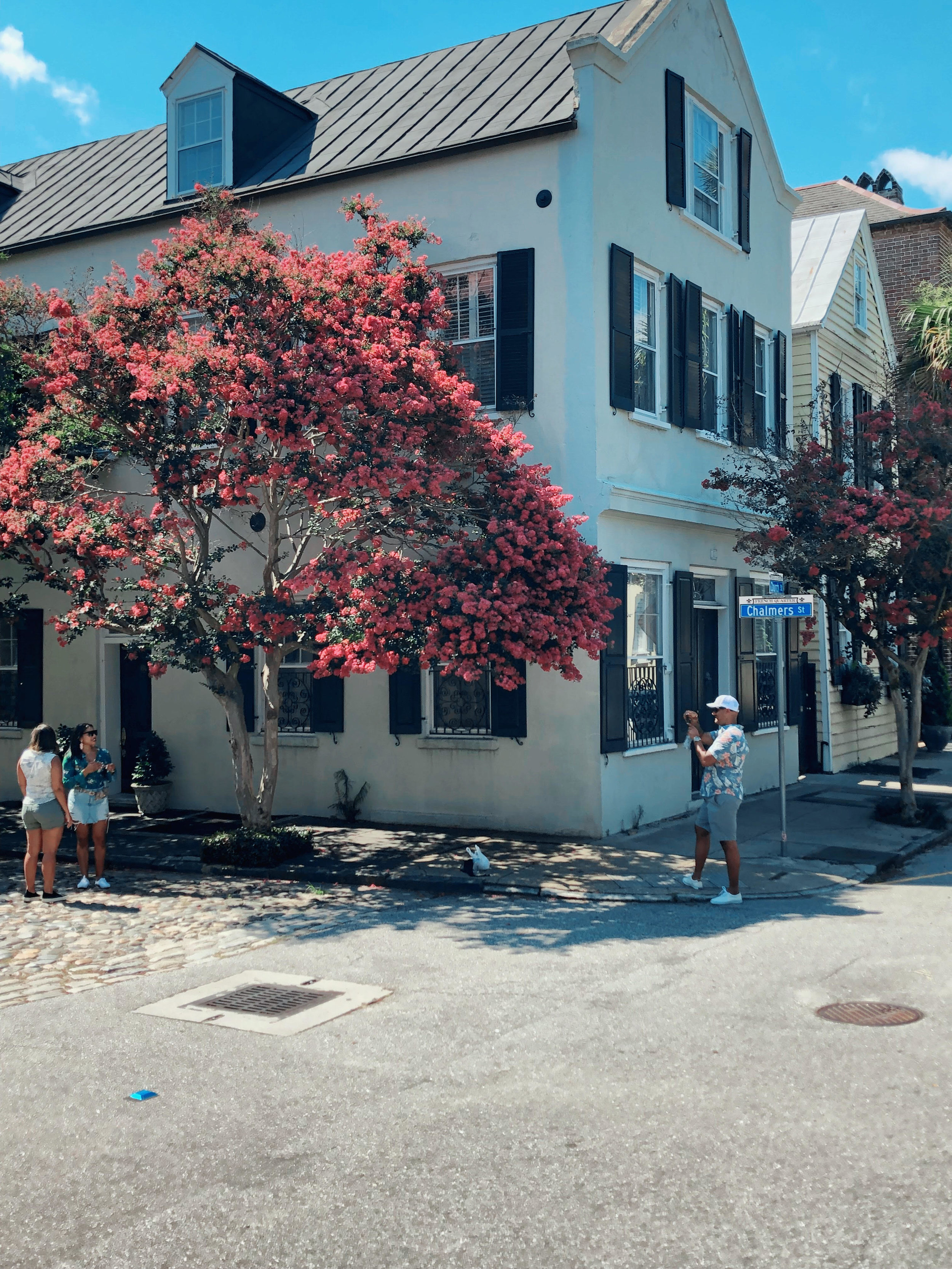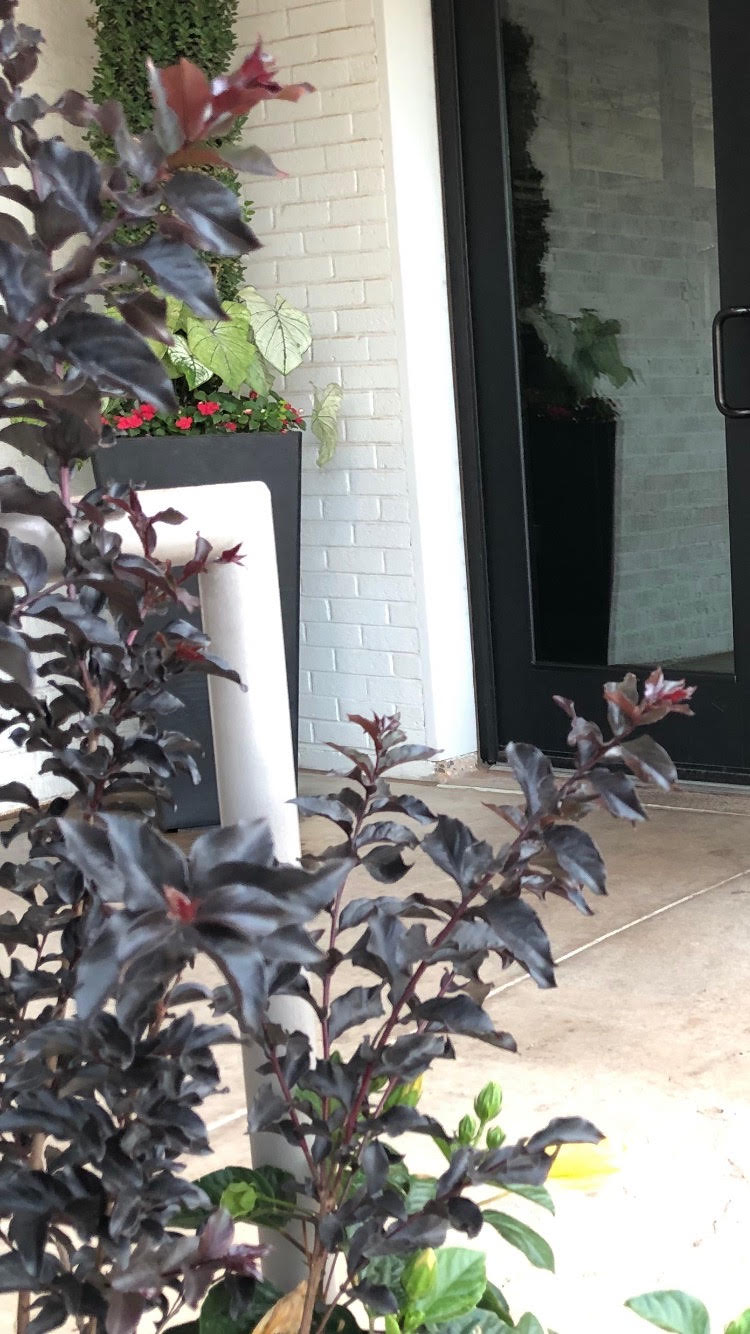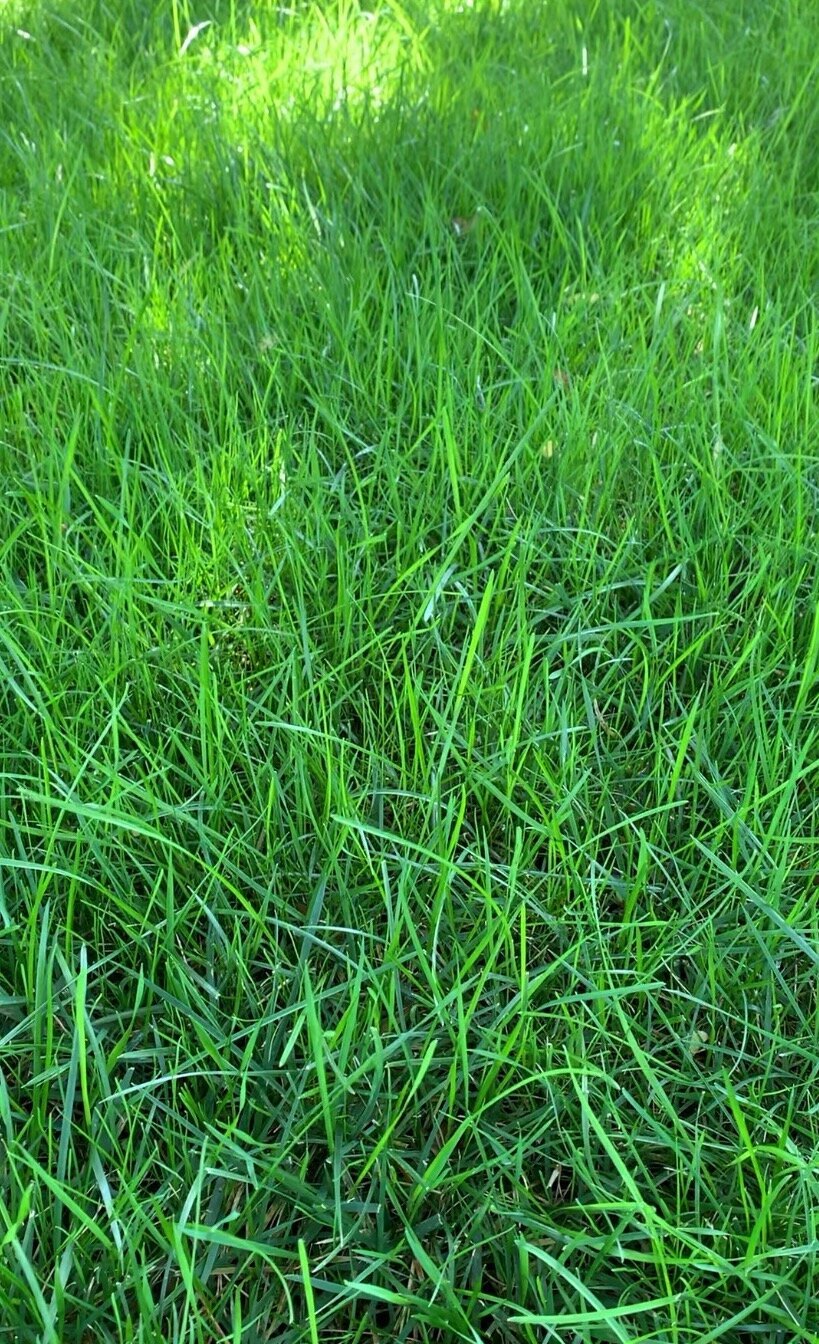
August Lawn & Landscape Tips
We have arrived at the hottest, driest point of the season…the last 10 days of July and the first 10 days of August when Oklahoma City’s average daily temperature reaches its peak.
The key to surviving the hottest period of the season is best practices. It's not just during times of high stress that these habits matter, but rather it's best practices all the time that make the real difference.
After getting way ahead on rainfall from mid-April through early July, the rainy pattern shut off three weeks ago. Hopefully, the chance of a good rainfall today will materialize and break the 21-day streak of no rainfall we currently have going.
Lack of moisture is the current biggest issue we are seeing. This week alone, we visited a lot of lawns and landscapes that were desperately needing moisture, with irrigation controllers still set as if we were getting occasional rainfall.
To finish the summer strong and keep your lawn healthy, here are a few best practices to focus on, the first being watering:
Watering
The abundant soil moisture from the early summer quickly disappeared the past two weeks. The best-looking lawns and landscapes are those that are receiving 1 ½” of water per week.
To learn how long and how often you need to water for your landscape to receive 1 ½” of moisture, place your Hall | Stewart Rain Gauge or cans around your lawn. Water using your normal cycle and then check the cups. Adjust watering times and frequency accordingly to insure 1 ½” is applied each week. Remember your landscape prefers deep soaking, infrequent watering over shallow, frequent watering. Even in the heat, lawns and landscapes are at their best when they are watered deeply as needed and not every day.
Healthy lawns have deep root systems. Roots will grow to the moisture. If your watering pattern is short, shallow, frequent watering resulting in moisture only in the top 1-2”, you will have a shallow rooted lawn dependent upon daily water. Deep soaking results in a root system with grass roots 6” to 2’ deep that is not dependent upon frequent watering and is drought resistant.
Remember, trees planted in the last two years need supplemental watering during the summer heat and extended dry periods. A good rule of thumb is to give them 10 gallons of water every week.
Best Watering Practice for August – Know how long you need to water to get 1 ½” water on your lawn each week. Practice deep soaking, infrequent watering.
If you are unsure about your watering practices, let us help. We can schedule an Irrigation Audit/Check to make sure your system is operating at its peak efficiency during the summer heat.
Take time to check your irrigation and fine tune it. A leaning head often is the culprit for dry spots in the lawn.
I am currently mowing my fescue lawn at 3 1/2". More leaf space results in better heat and drought tolerance.
Mowing
Both warm season turf (Bermuda and Zoyia) and cool season turf (Fescue) should be mowed at the highest level this month, warm season 2-2.5” and cool season up to 3-3.5”. At the higher level the lawn will have more leaf space resulting in better heat and drought tolerance. Continue to mow often enough that you are removing only 1/3 of the grass each time you cut. If you are cutting frequently enough to pass the 1/3 test, don’t catch the clippings. Allowing the clippings to decompose on the lawn will return moisture and nitrogen to the soil. Give no bagging a try. You will be surprised at how much more color your lawn will retain even in the heat. When you bag your clippings, you are tossing out nitrogen and moisture your lawn could really use this month.
Best Mowing Practice for August – Mow high, mow often, and don’t bag your clippings.
Bermuda lawns perform their best in the heat. Mow often and don’t bag the clippings. Grass clippings are mostly nitrogen and moisture. Your lawn will thank you for giving them back.
After mulch mowing, use your blower to distribute any noticeable clippings.
Well maintained Bermuda lawns can’t be beat in August. This Bermuda lawn is the result of best practices this summer: well timed lawn care applications, aeration in June, deep infrequent watering, and mulch mowing.
Fertilizer
Apply fertilizer to warm season turf this month. This time of the year, Bermuda and Zoysia benefit from a high nitrogen fertilizer that is low in phosphorus and potassium.
DO NOT fertilize cool season lawns until we reach the cooler temperatures of September.
Warm and cool season turfs require different fertilizer schedules. Don’t make the mistake of trying to treat them the same when it comes to fertilizing.
Best Fertilizer Practice for August – Fertilize bermudagrass, don’t fertilize fescue. Important - Follow watering instructions after fertilizer is applied.
August is the month to be less aggressive on weed control. Because a thick turf is the most important part of good weed control, you want to avoid weakening the turf going into the fall.
Weed Control
Spring pre-emergent herbicides are reaching the end of their effectiveness in your soils. Should an occasional weed show up in your turf this month, it is best to go easy on weed control. We have reached the time of the year that damaged turf may not have a chance to fully recover before fall. Great weed control is at least 75% the result of thick turf. August is the month to focus on turf development going into the fall.
Later this month is the best time to start applying the first fall pre-emergent herbicide application. The first fall weed to germinate is poa annua (annual bluegrass). Poa annua has become more and more of a problem to control in lawns worldwide as it has developed resistance to current herbicide chemistry. For the best prevention, it is important to put a pre-emergent on your lawn between late August and the end of September followed by a second pre-emergent, using a different herbicide, in October or November.
Best Weed Control Practice for August – Don’t cause turf damage by overtreating weeds. Better to go into the fall with a thick turf than one with herbicide damaged thin areas.
Bermuda vs Fescue in August
Bermuda (warm season turf) loves the summer heat. Fescue (cool season turf) prefers nights below 70 and days below 90. Healthy bermuda lawns look their best in the heat of the summer. Healthy fescue will retain color, although not as much as in early summer, and growth will slow.
Fescue where there is plenty of air circulation and dabbled sunlight typically looks best in the warm weather. Fescue lawns with heavy shade and little air circulation tend to thin from brown patch disease. Brown patch occurs in fescue lawns anytime the grass stays wet for 5 hours or more at a time and nighttime temperatures are in the 70s. During the hottest and driest time of the season, brown patch is often self-inflicted by watering your fescue in the morning and evening, a common incorrect watering habit on fescue lawns in July and August.
Brown Patch develops in fescue lawns that have an area of low air circulation or heavy shade during the summer if the area stays wet for more than 5 hours at a time. Don't create Brown Patch with your watering practices. Allow your fescue time to dry between waterings.
Inspect Shady Lawn Areas
September through October is the best time of the year to establish fescue. Now is the time to assess the areas of the lawn where bermuda has become thin due to increasing shade (Bermuda needs at least 6 hours of direct sunlight to be thick), areas of the lawn where fescue did not perform well because of very dense shade (Fescue needs at least some dappled sun), and areas of fescue that have been damaged by brown patch this summer. Because fescue does not spread, you should plan on adding some seed every fall.
Best Fescue Lawn Practice for August – Inspect and evaluate your turf. Check shade patterns and make a plan for overseeding low light areas with fescue this fall.
Need Help Evaluating Your Shady Areas?
We would be happy to evaluate your shade and make a recommendation.
Just give us a call at (405)367-3873 or respond to this email.
Insect Watch
If Grubs have been a problem in your lawn, August is the time to apply an insecticide. Remember, the insecticide will kill desirable insects also. Only treat for grubs if there is evidence of a problem.
Keep on the lookout for Army Worms. We continue to find active army worms causing damage in isolated areas of the metro. There are 4 to 5 generations between July and November with each generation increasing in numbers, so early control is best. Early caterpillars are green and very small. As they grow to 1 to 1 ½” they turn browner with reddish brown stripes on each side of the body and small back spots on the top. Their distinctive mark is an inverted “Y” on the front of the head. Army worms will feed on any leafy, soft plant with plenty of moisture in the leaf. Typically, in August they will feed mostly on bermuda because of an abundance of healthy leaf blades and less on fescue because it is not flourishing as much in August. Watch for areas of the lawn that appear to have drought stress should not be. Test the area with a soap flush. Mix 1 teaspoon of dish soap with 1 gallon of water and pour over the surface. If you have army worms, they will come to the surface. Treatment with a systemic insecticide when the worms are small before they become heavy feeders is best. Need more information on Army Worms, check out our article from July 13th.
Continue to inspect shrubs for Aphids and treat as needed. A common host plant is the Crape Myrtle.
Inspect your trees and shrubs for active Bagworms. If you need help controlling bagworms, give us a call. When possible, remove and throw away bagworms. Don’t toss them on the ground because they will crawl back onto your plants.
Watch for Webworms in your trees this month. The later generations of webworm are the ones that cause damage. If noticed early when the webbing is small, simply cutting the branch out is the best control. If spraying is required, you must penetrate the webbing to gain control.
Best Insect Control Practice for August – Spend a few minutes inspecting your lawn and landscape for insect activity. Treat as needed.
A common problem on Hackberry trees in the summer is nipple gall. Unfortunately little can be done to control gall-making insects.
When you remove bagworms please dispose of them. This little guy is slowly climbing back up a tree to do more destruction.
Summer annual color mixture of Joseph Coat, Sunpatien, Angelonia, Penta, Coleus, and Lantana.
This summer’s Crape Myrtle colors have been brilliant.
Lantana
Shady summer annual color mixture of Impatiens and Caladium.
Limelight Hydrangeas can’t be beat for colorful summer shrub. This is a ‘Little Lime’ and is great for smaller areas.
Landscape Color
How has the color been in your landscape this season? Sometime this month take pictures and make notes of the plants that are doing the best in your landscape.
Black-eyed Susan’s are the perfect perennial to add color to the landscape during July and August.
Crape Myrtles are loving the warm days and rewarding us with abundant summer color this year.
Limelight Hydrangeas continue to brighten the landscape even on the hottest of days.
Lantana, Penta, and Periwinkle are just a few summer annuals that are at their best now.
What is adding great color to your landscape right now? We want to know. Send pictures please.
Lantana is one of the best heat-loving annuals and with so many varieties, there is a right one for every landscape.
Angelonia is becoming a favorite summer annual. It has profile spikes of color and is available in white and shades of pinks and purples.
Crape Myrtle and Black-eyed Susan’s are a great color combination for late summer color.
Limelight Hydrangeas continue to add large white blossoms to the summer landscape.
Coleus is a great summer annual with big colorful leaves that at interest to the summer landscape.
Black-eyed Susan’s add a splash of bright color to the hot summer landscape.
Lantana is one of the best annual color plants for a summer filled with above average temperatures.
Brake Light Yucca are a fun addition to the summer landscape.
Shasta Daisies are nearing the end of their summer color show.
The best perennial plantings are the ones that have something blooming spring to fall. I challenge you to find another perennial that puts on a better color show in August than Black-eyed Susans.
Periwinkle is a lover of the summer heat.
Keep faded blooms pruned off and you will extend their bloom time a few more weeks.
August is a great time to evaluate your summer annual color and make notes on what worked and what didn’t. This planting of Sunpatien, Begonia, Penta, Joseph Coat, and Melampodium started the summer looking great. But over the last few weeks the Melampodium has over powered the rest of the color. Note: “If using Melampodium plant it in the back.”
Endless Summer Hydrangeas will add more blooms this month.

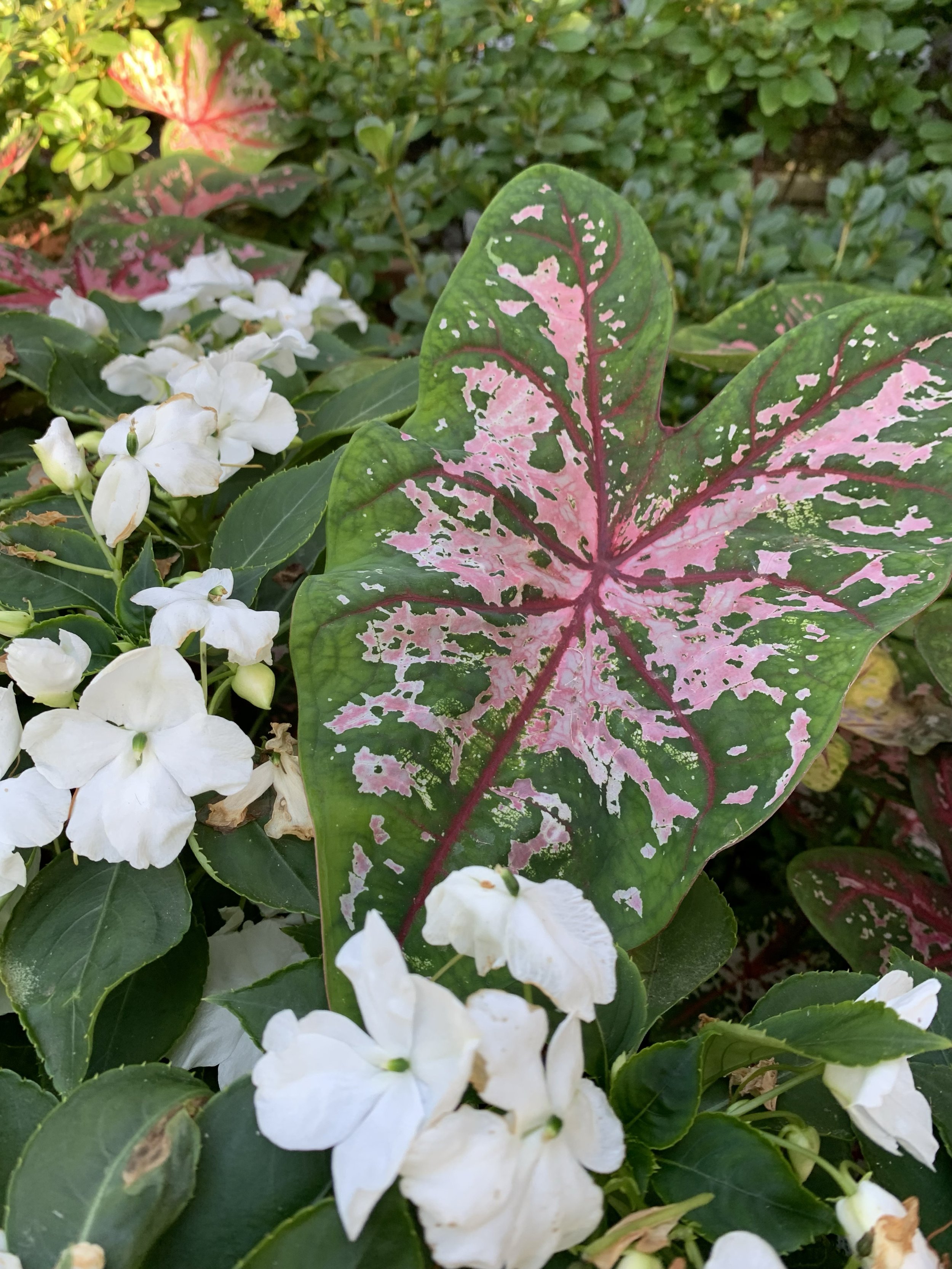
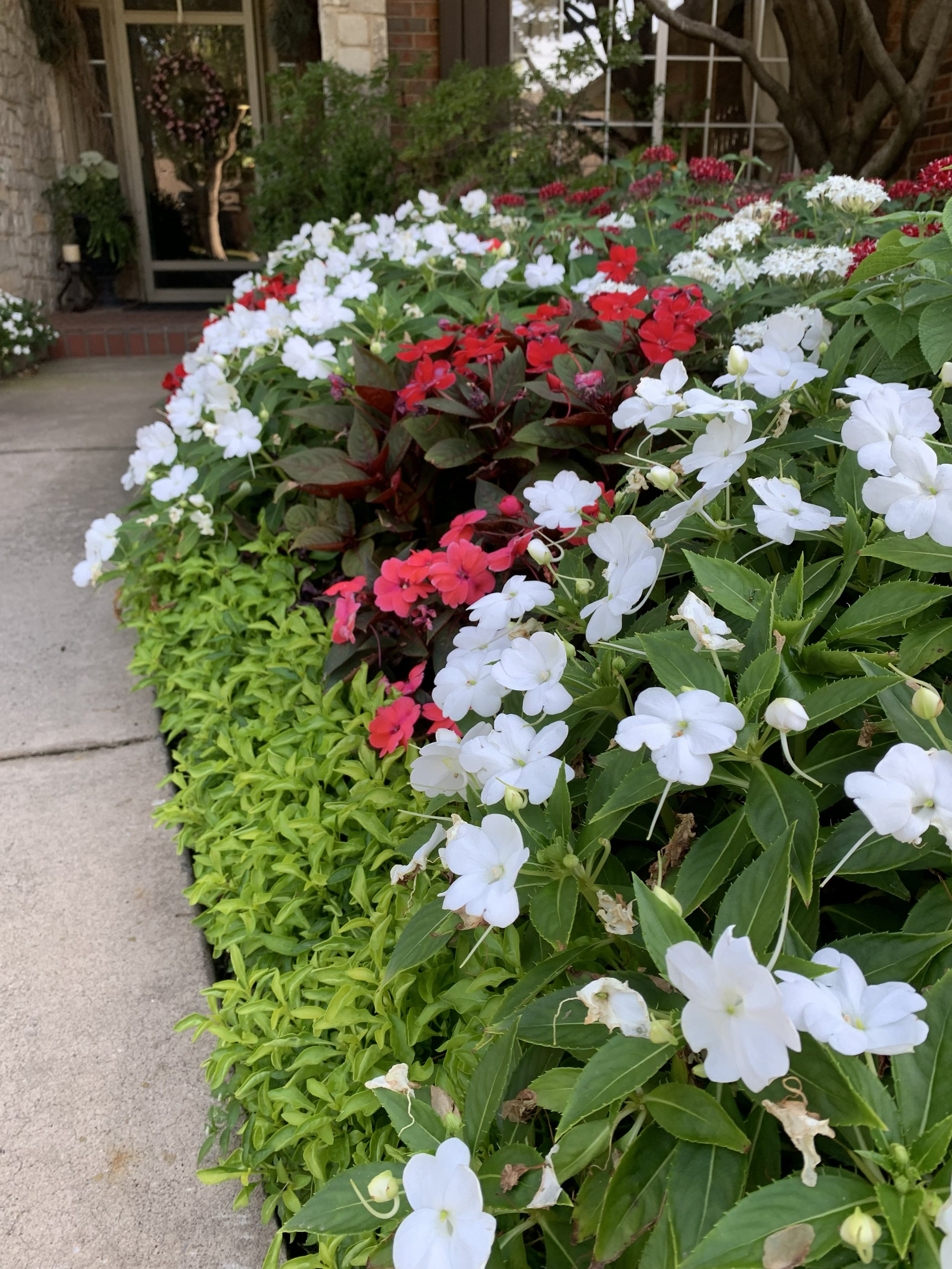
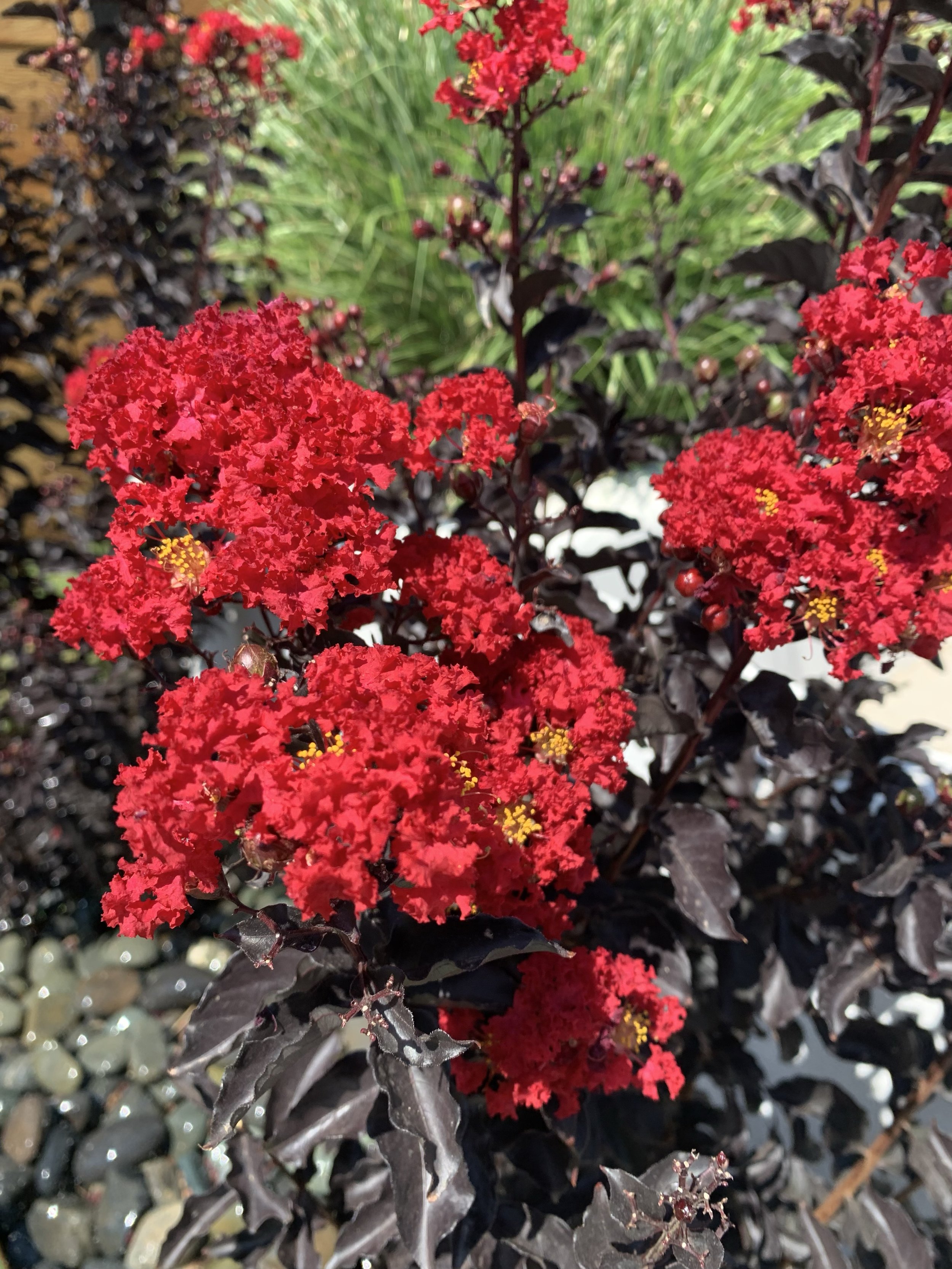
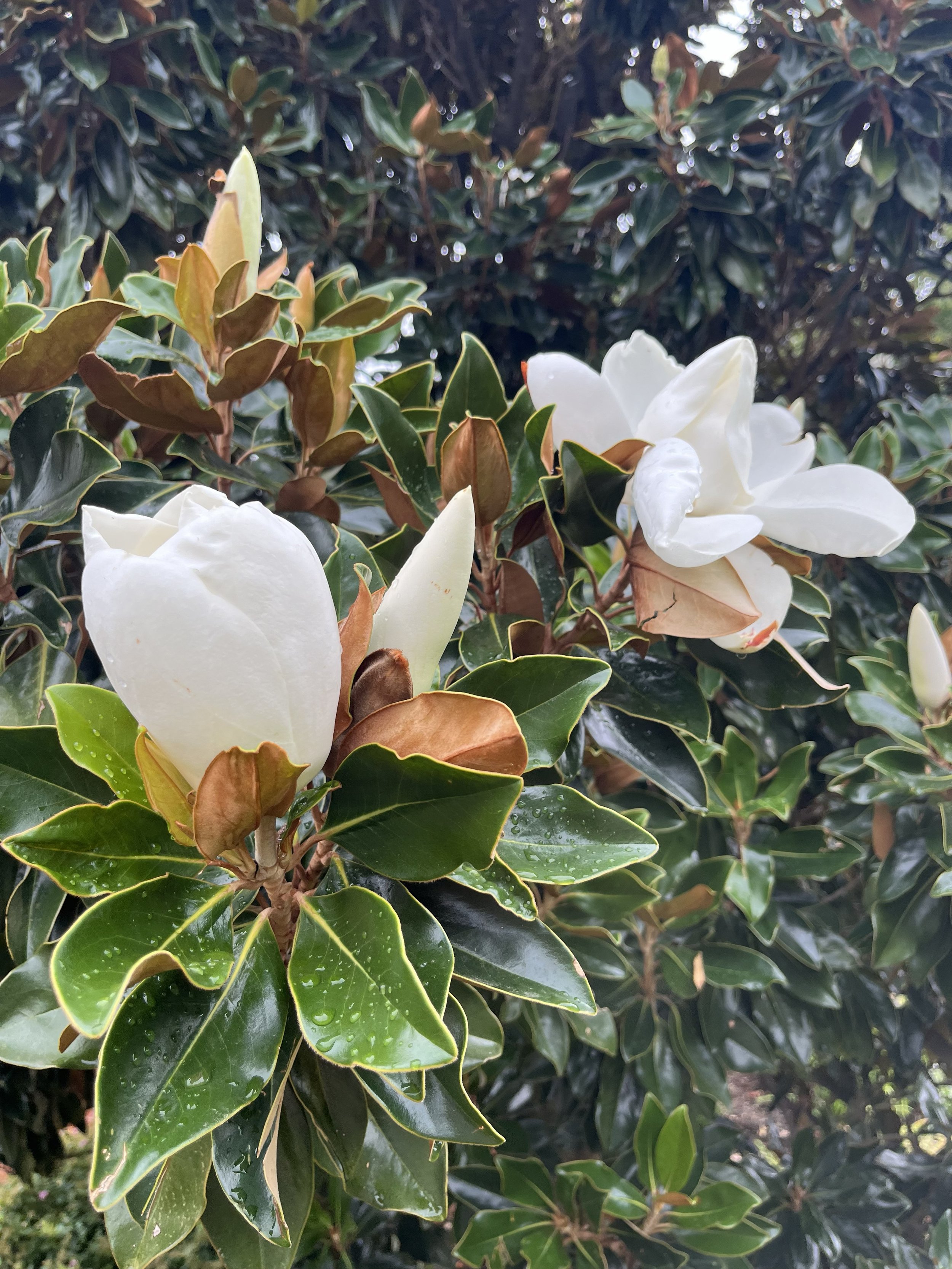

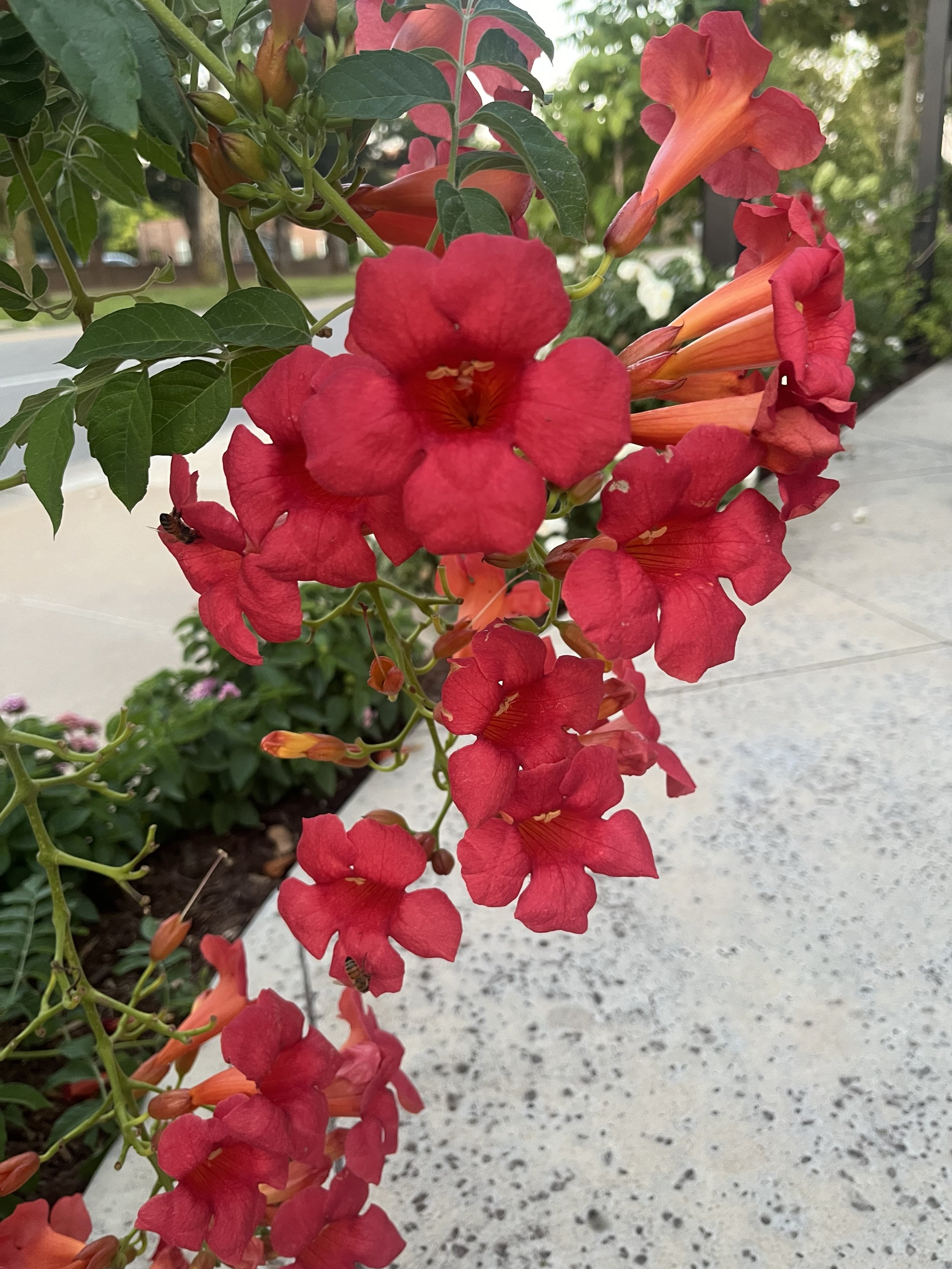
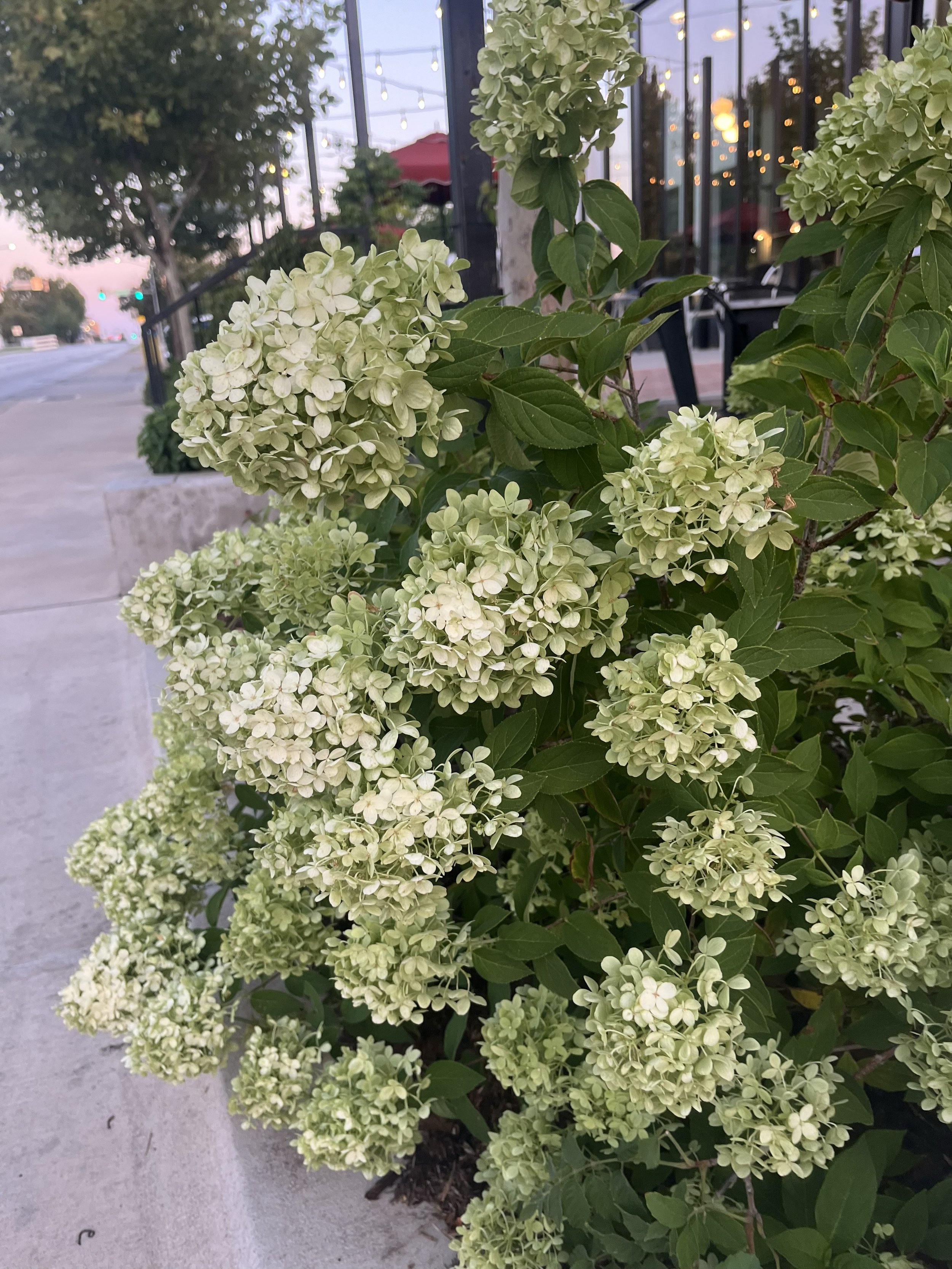
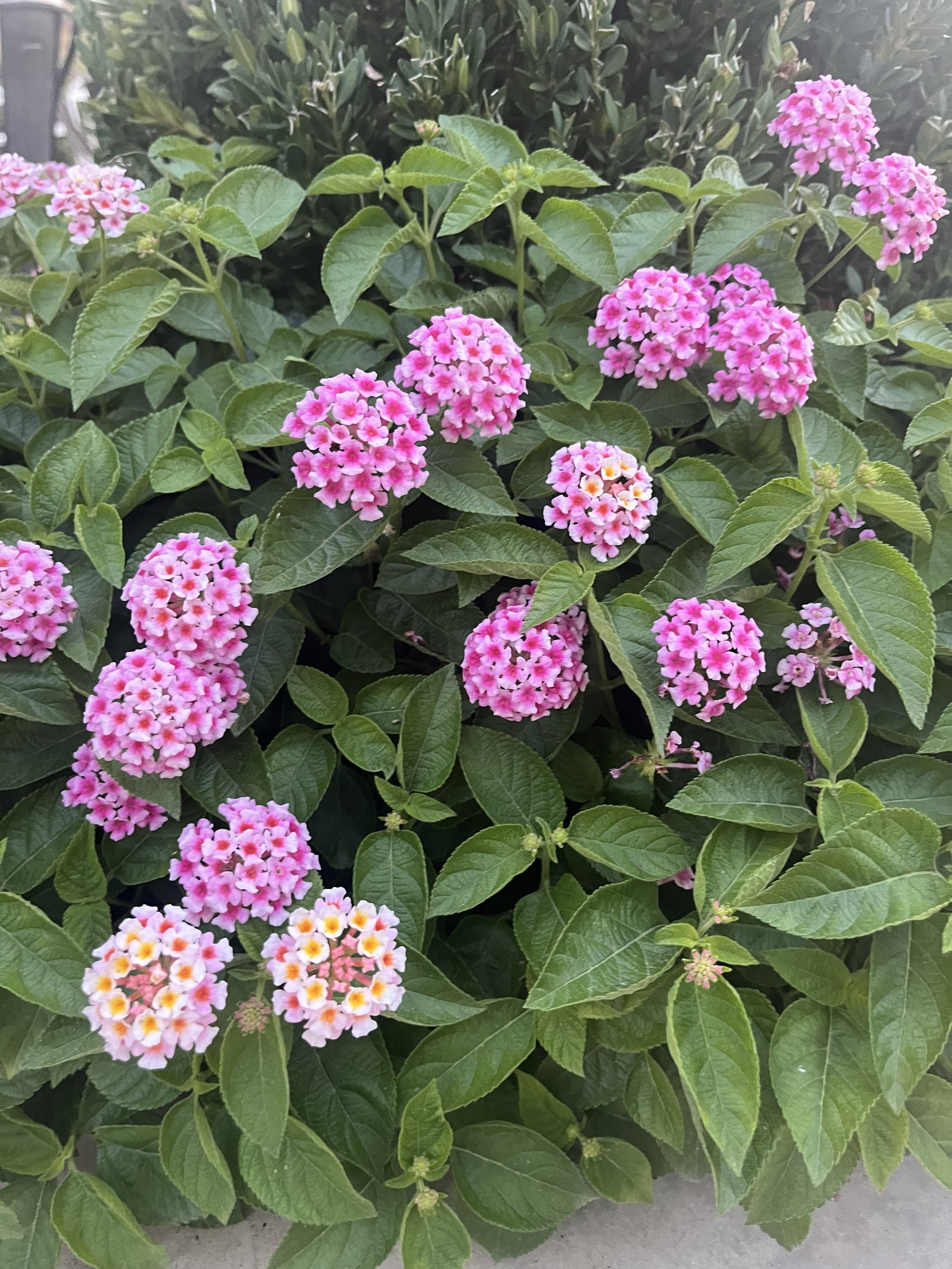
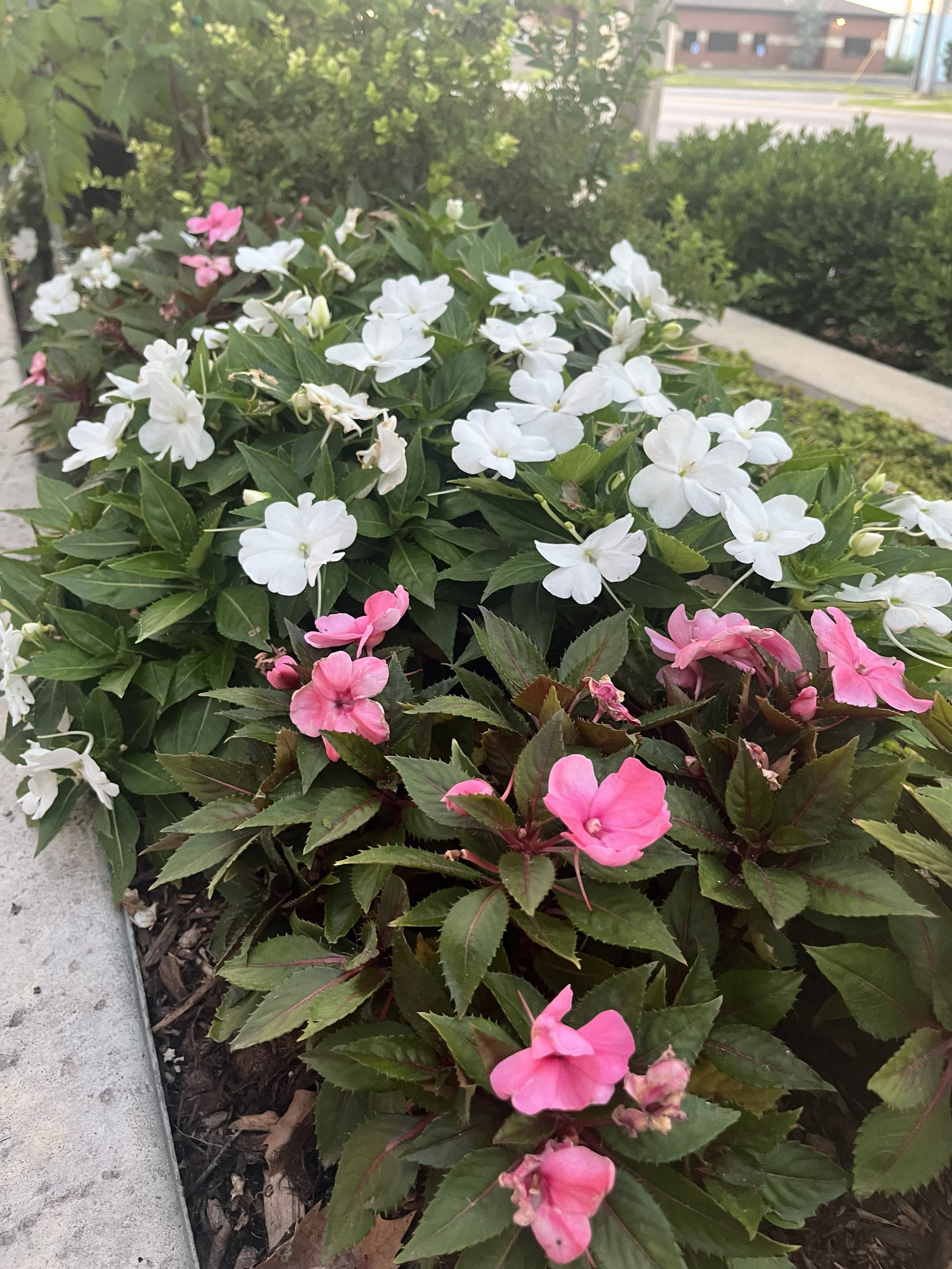
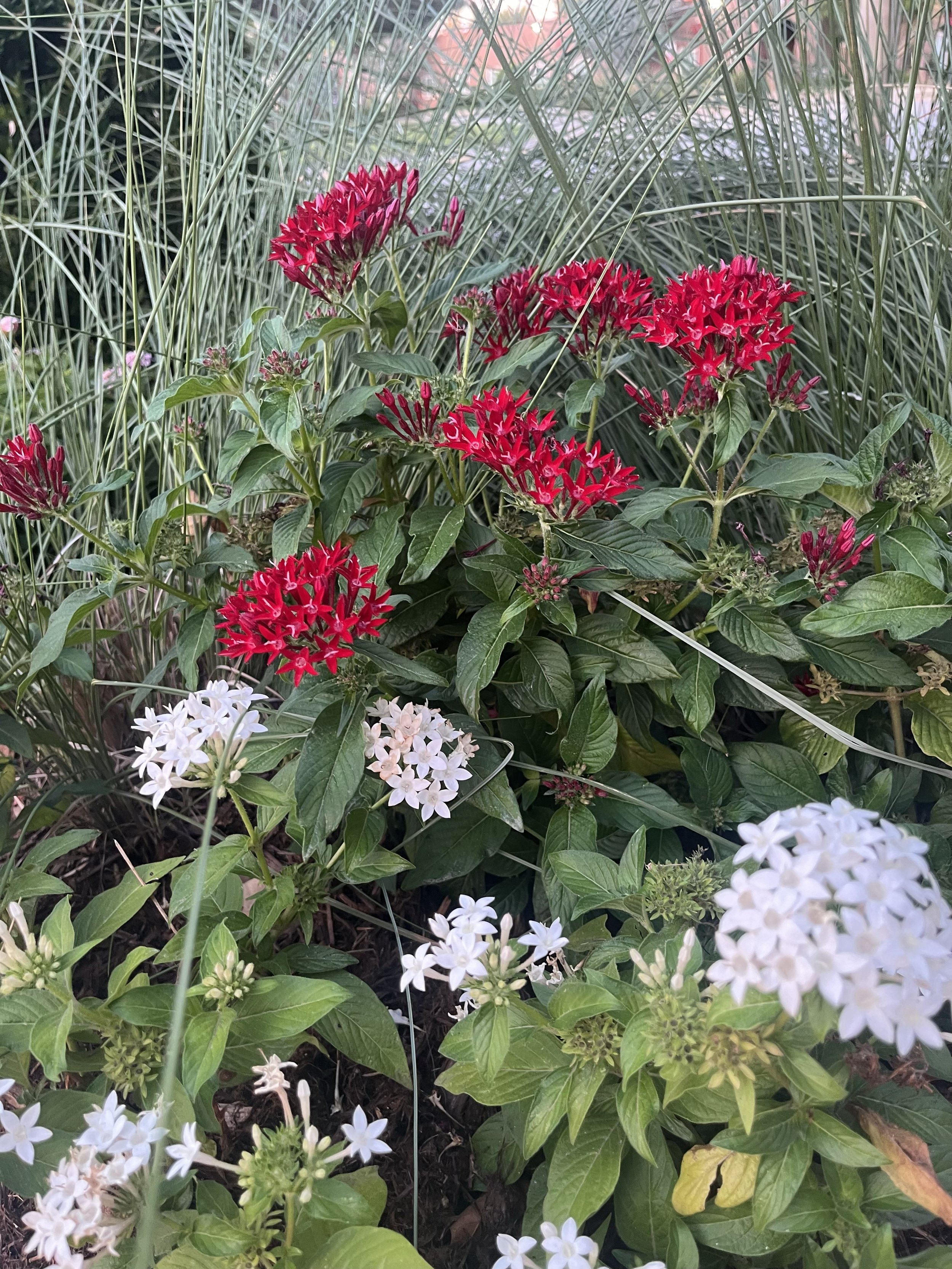
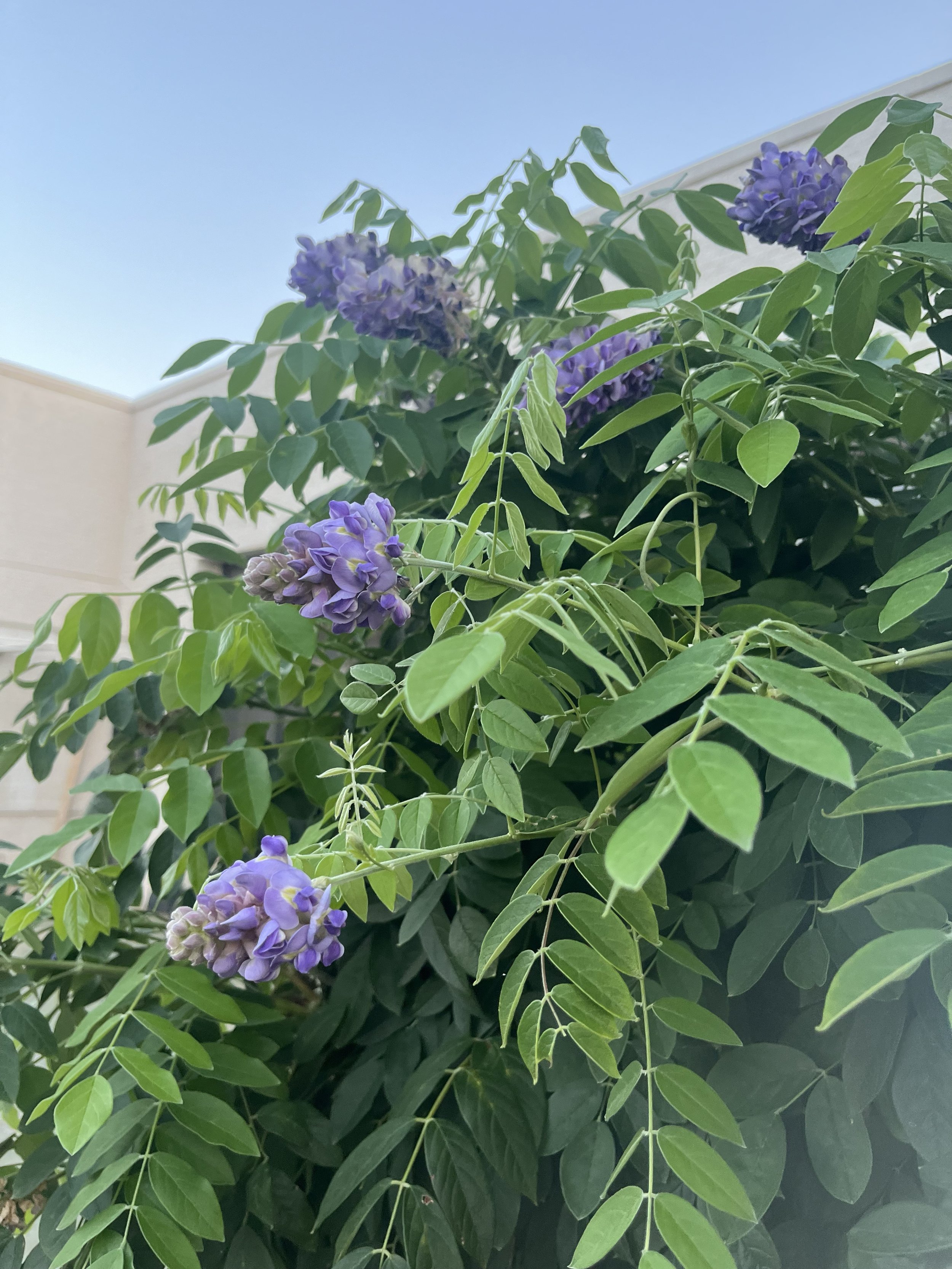
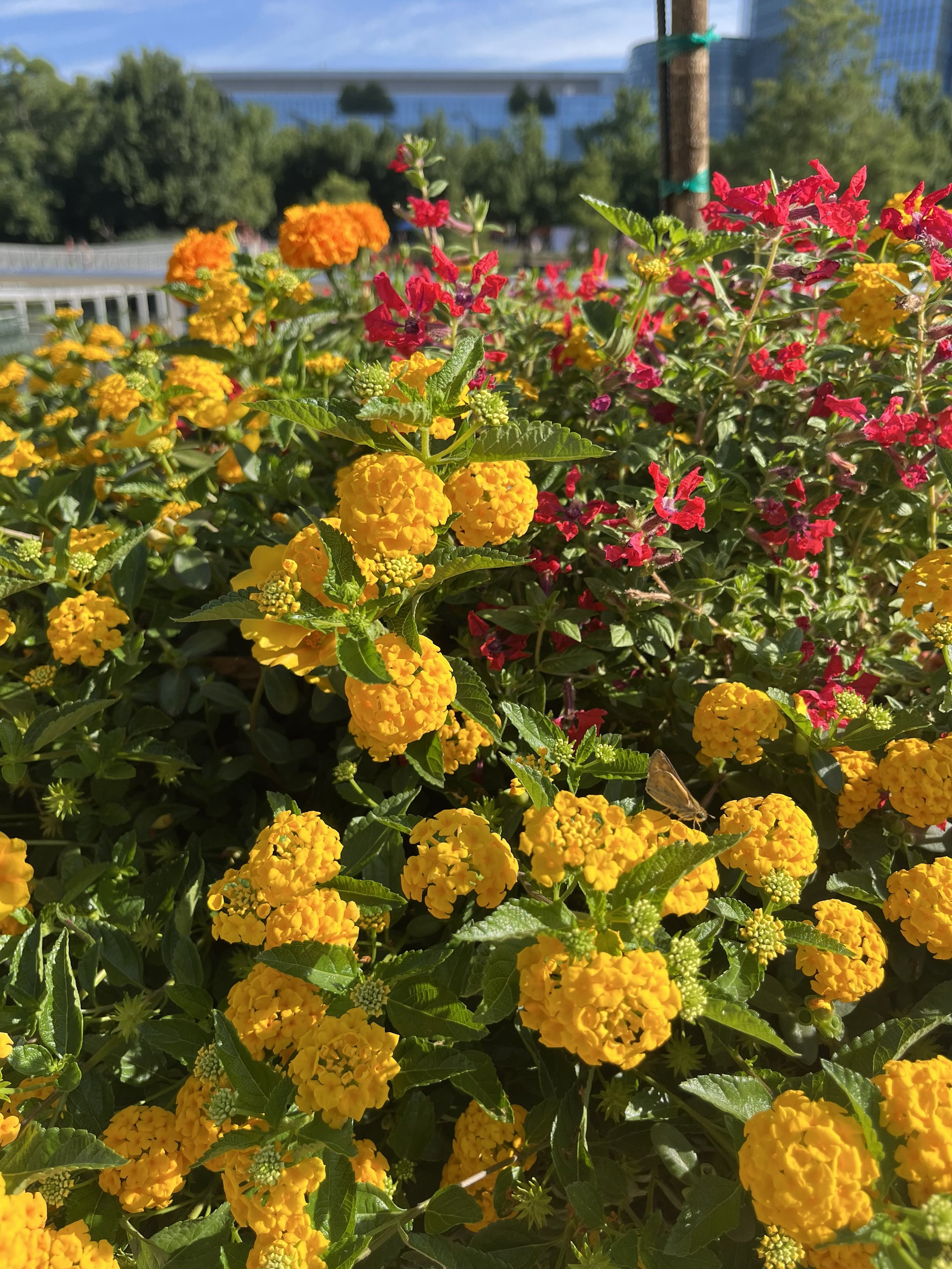
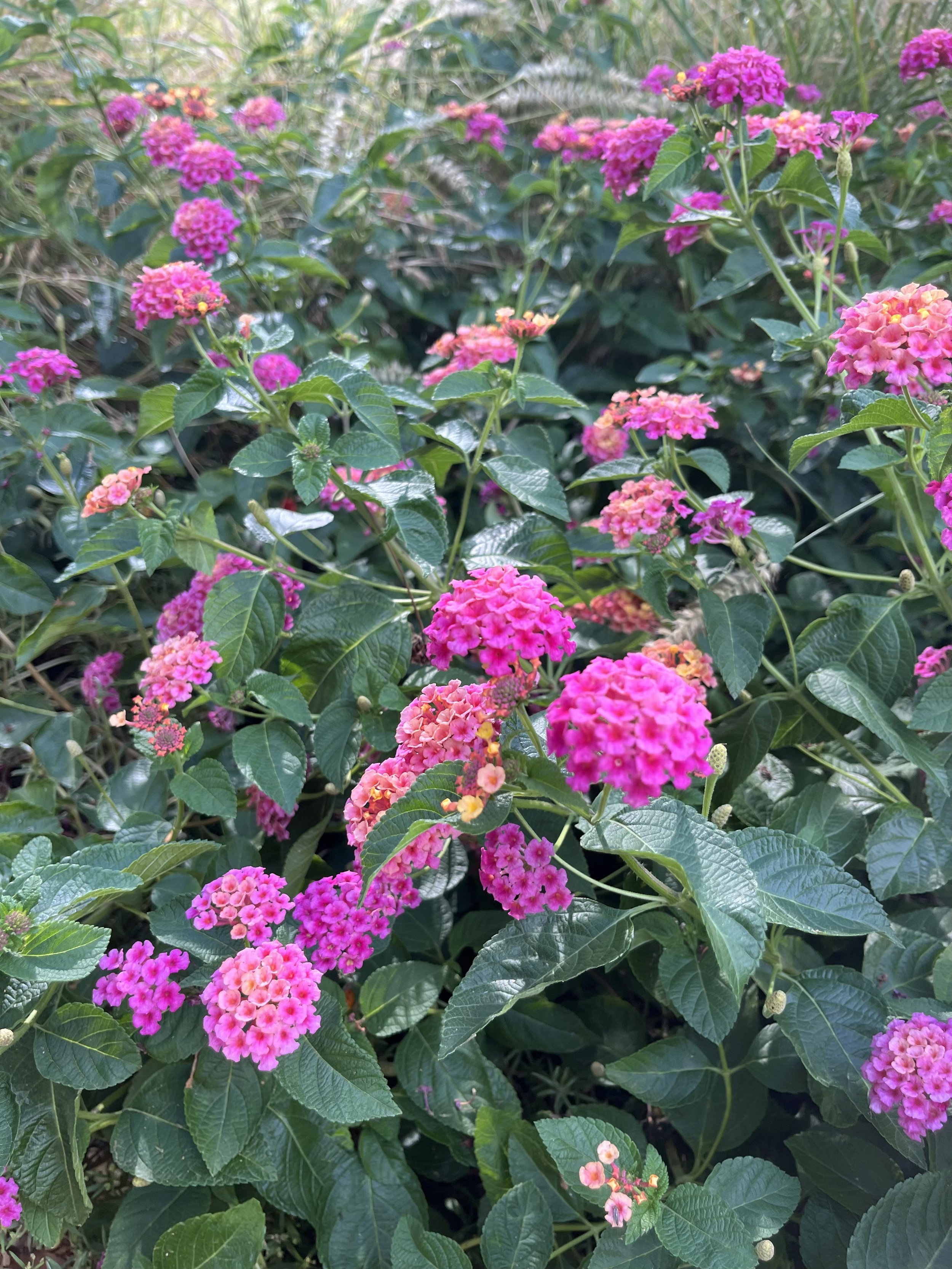
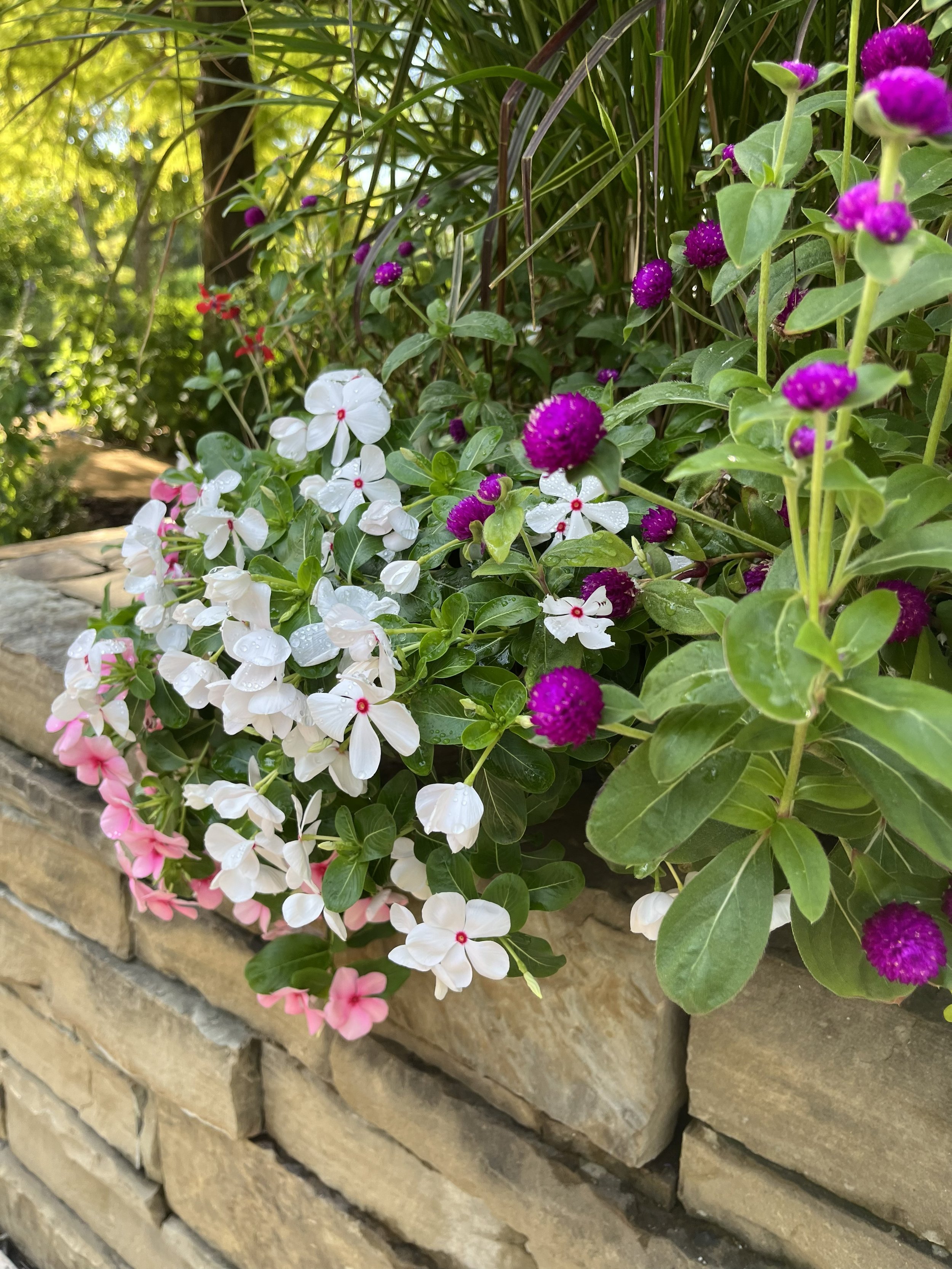
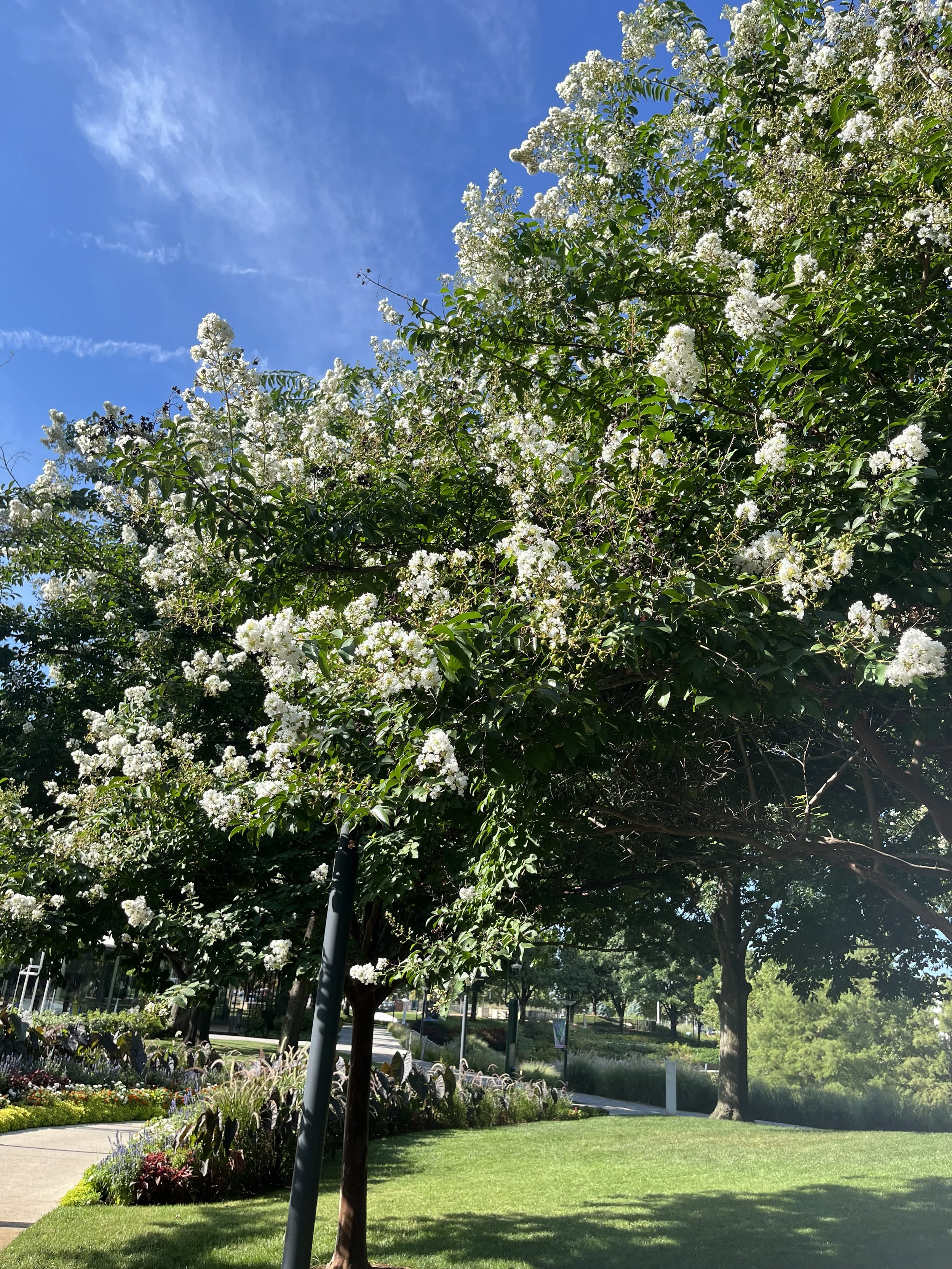
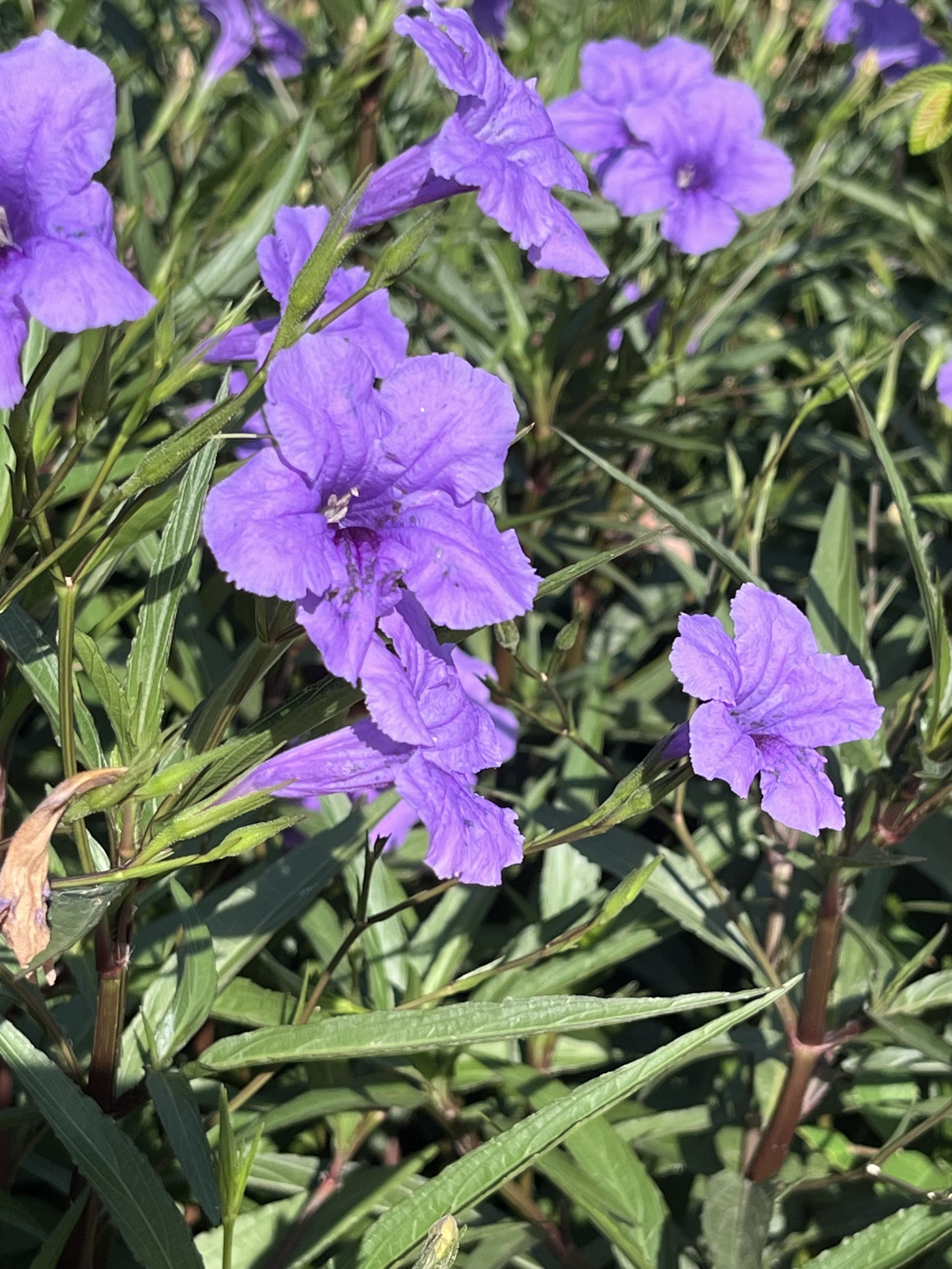
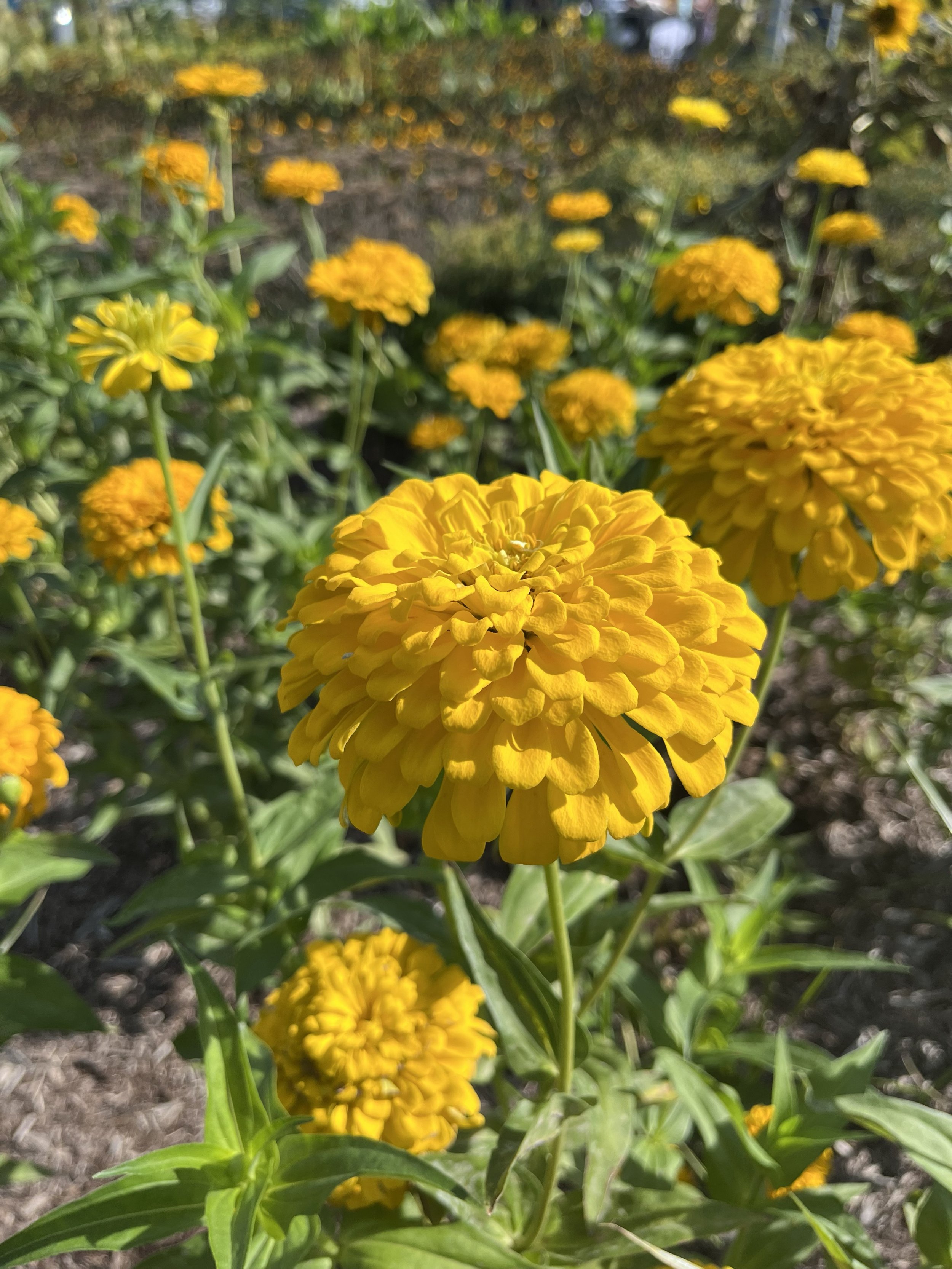
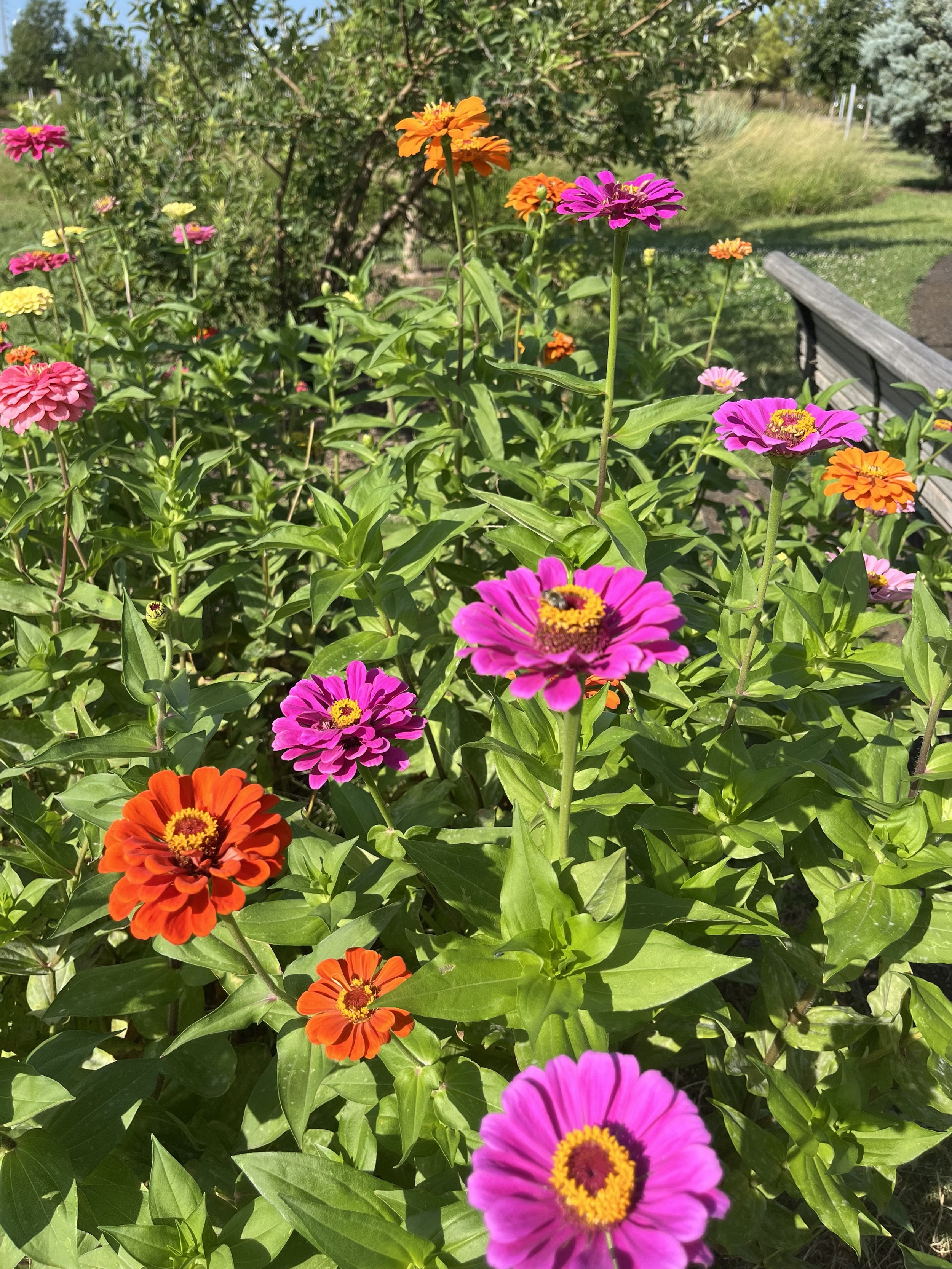
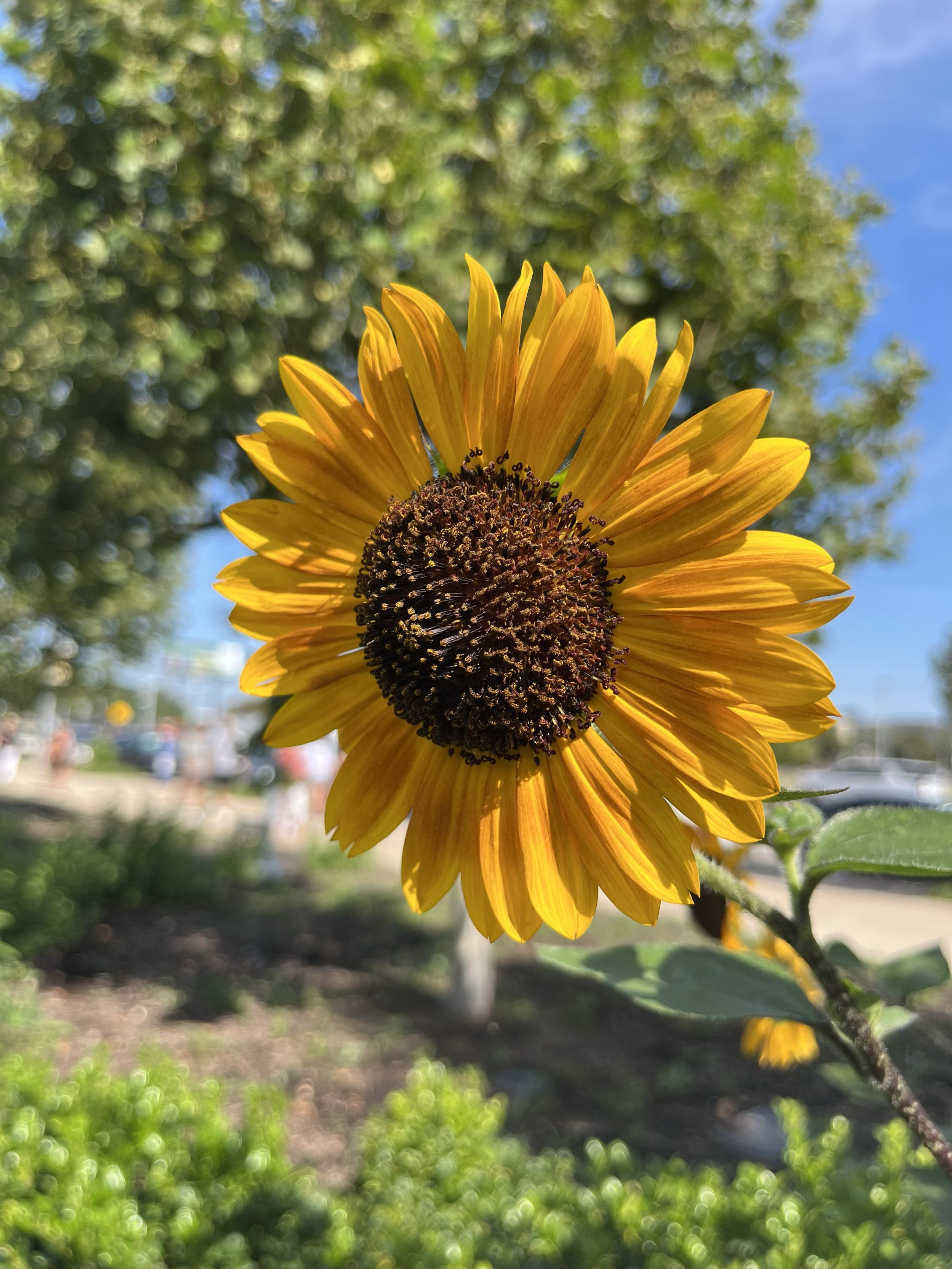
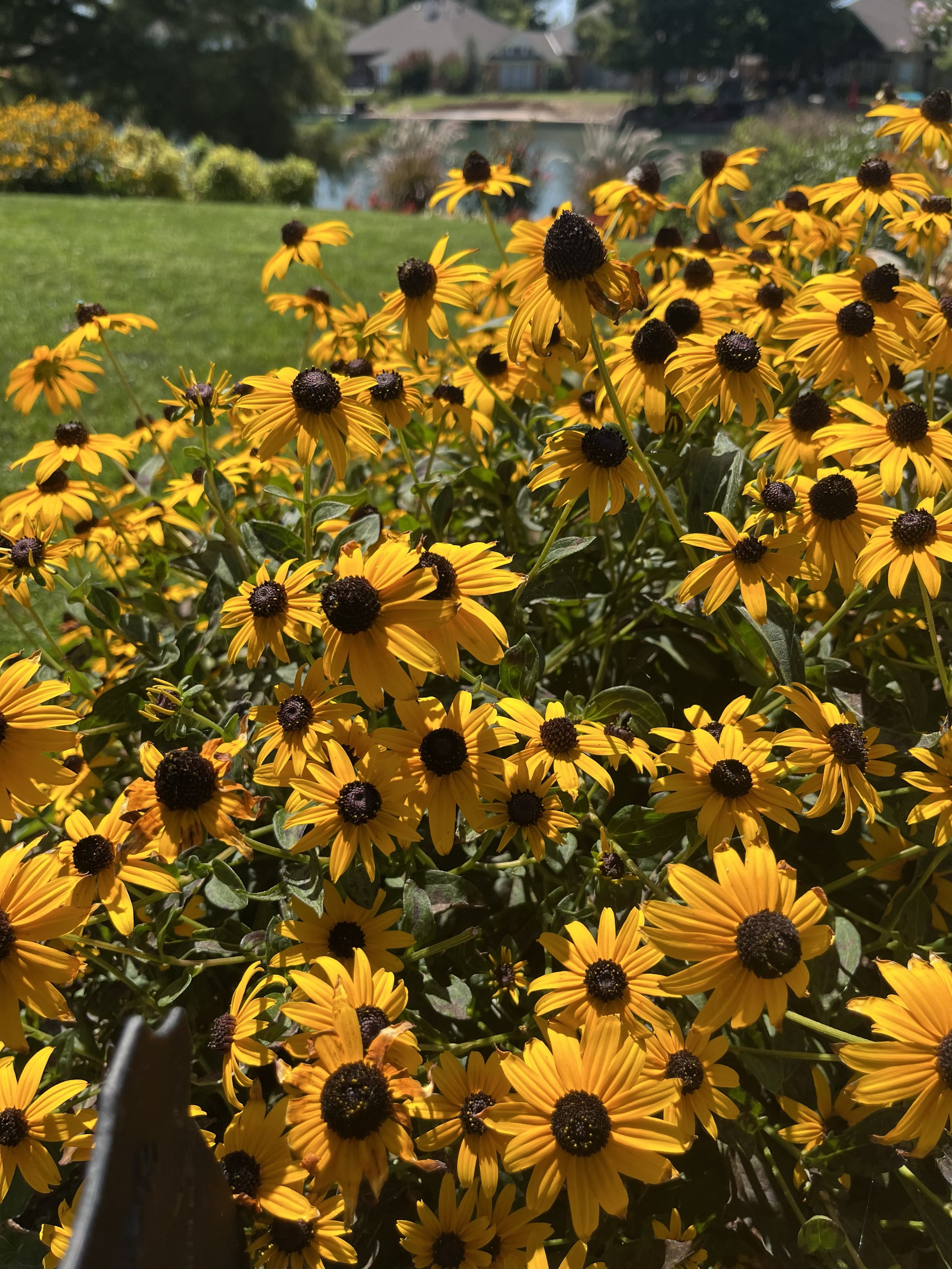
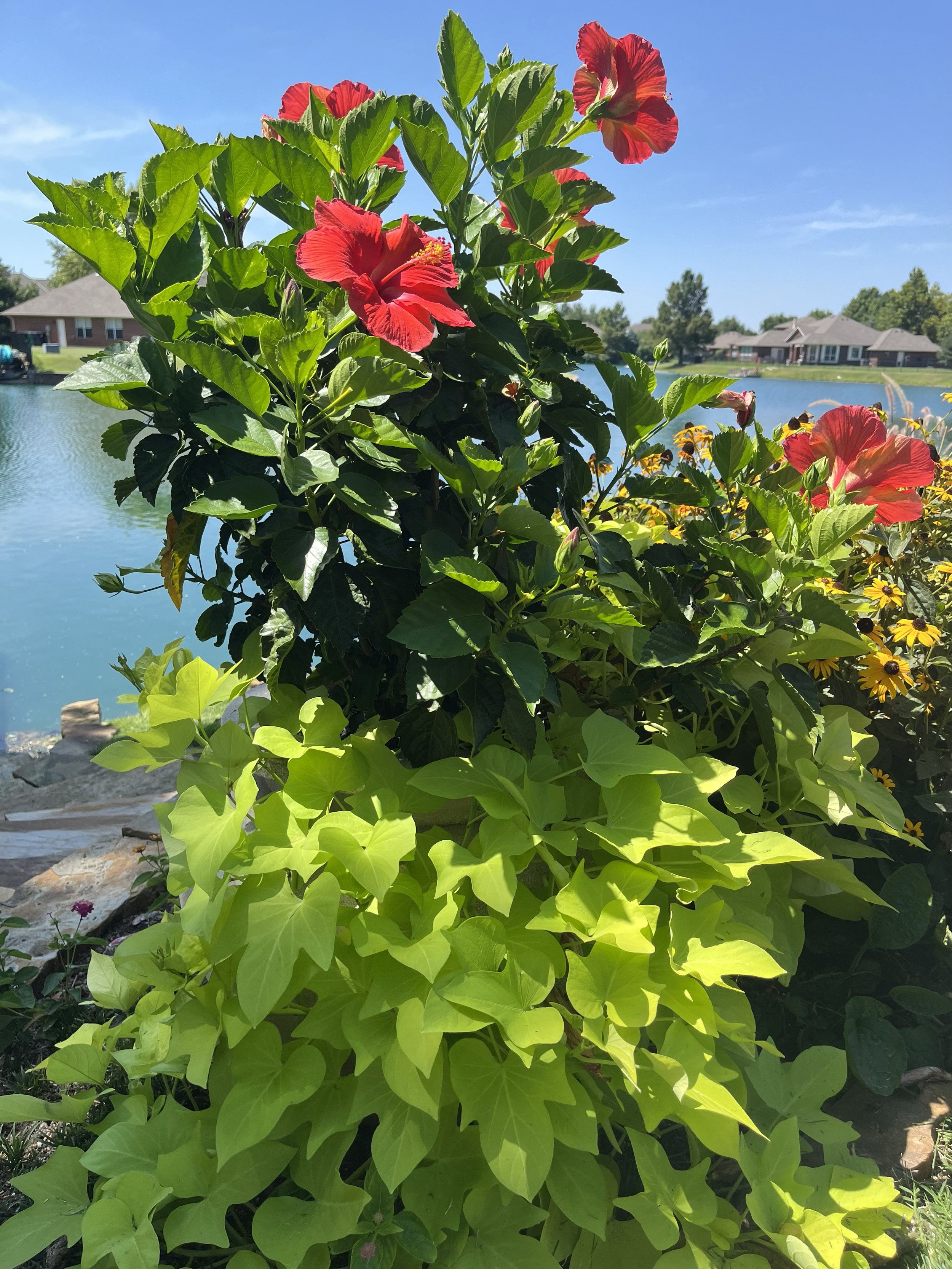
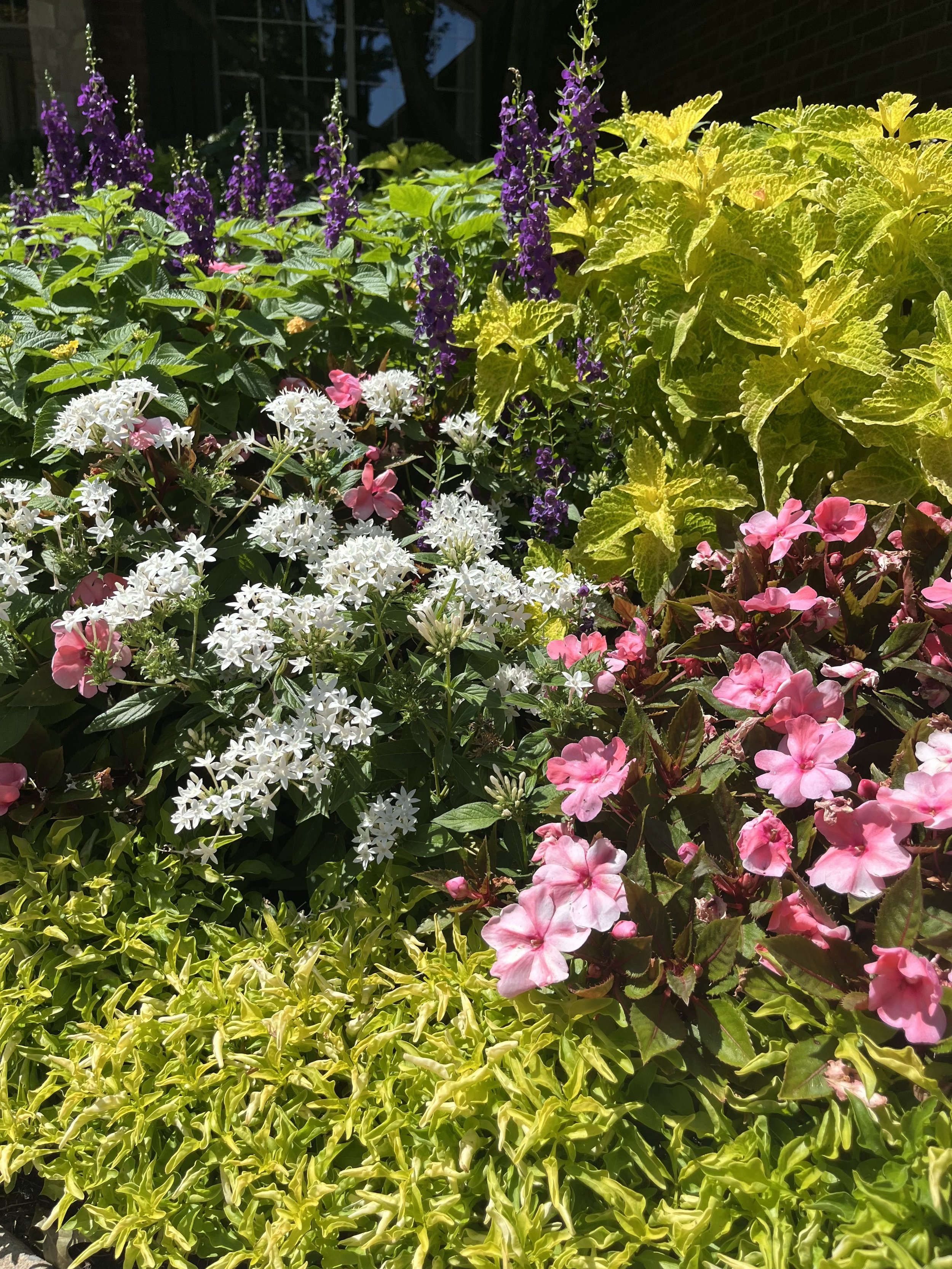
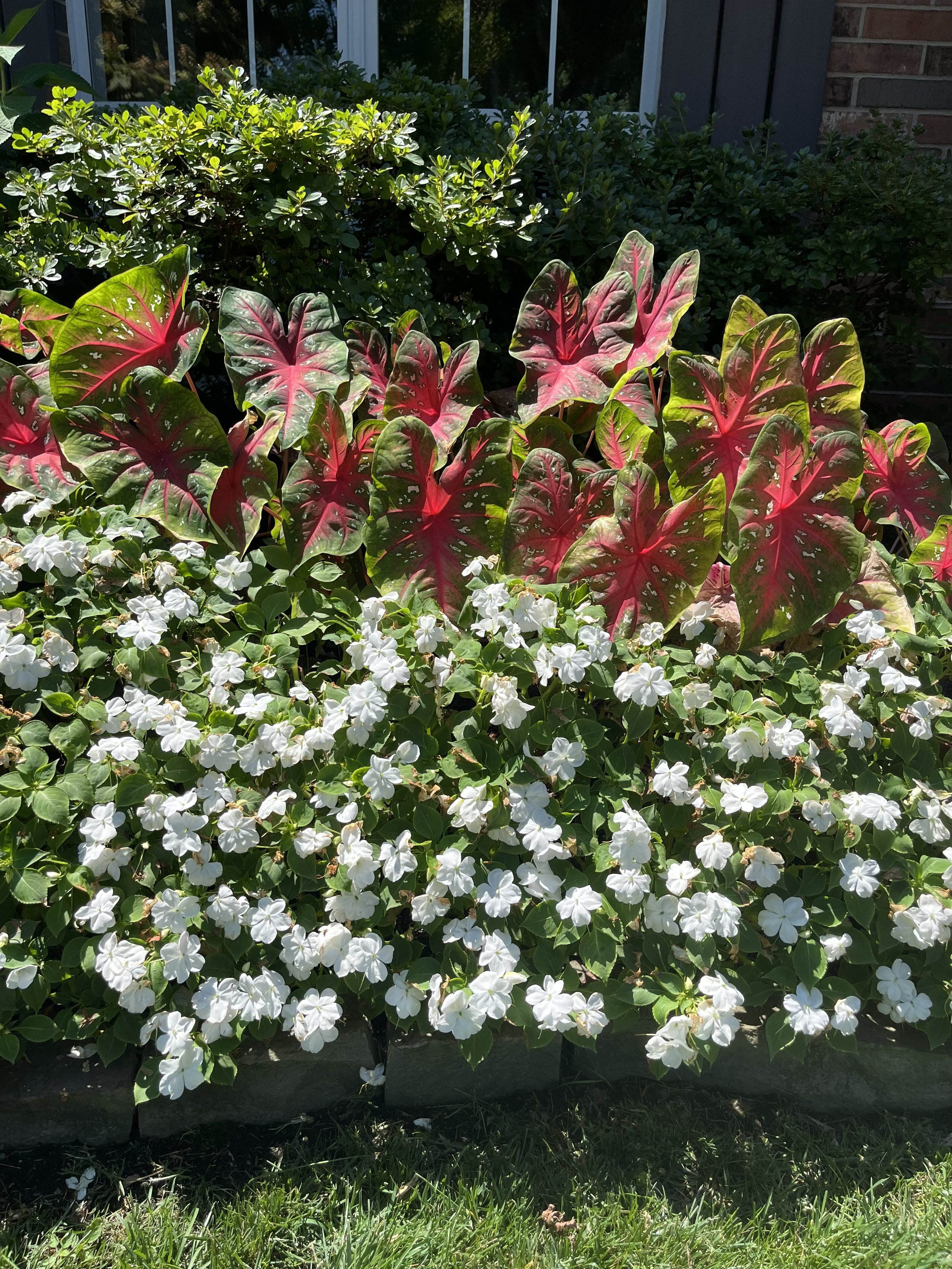
Having a great lawn and landscape through the heat of the summer is a result of good maintenance practices year after year.
A great lawn and landscape are not the result of one season, or even a full year of focus.
A great environment is the result of discovering and developing great practices and then repeating them season after season, year after year.
If you need assistance in developing great practices or have questions concerning your lawn and landscape, give us a call.
Lorne Hall
Hall | Stewart Lawn + Landscape
(405) 367-3873
What’s bugging your landscape?
In last week’s July Lawn & Landscape Tips, we touched briefly on common insect issues at this time of the summer. This week lets dive in a little deeper.
Healthy landscapes are a result of an Integrated Pest Management program.
The first step of an IPM approach is maintaining healthy plant material with proper watering, feeding and pruning. Insect activity increases on plant material that is already stressed.
The second step is simply monitoring your plants. Weekly observation is critically important. Does the overall plant color look healthy? How do the leaves look?
Our landscapes represent large investments in both time and money. They add curb appeal and provide enormous benefits to the environment.
It is important that we do all we can to keep them healthy and growing.
Here are a few of the problems that we are either currently seeing in landscapes, or we have on our watch list:
Be on the lookout for any plants that don’t look their best. Notice the slight color difference between these two Taylor Junipers? After close inspection, bagworms were found feeding on the one on the left.
Bagworms
Timing - Eggs hatch in May and they remain active through September.
½-2” long spindle shaped bag wrapped in the foliage of the host plant. Young bagworms are very hard to spot.
Favorite host plants are juniper, arborvitae, spruce, pine and cedar. But they can attach themselves to deciduous shrubs and trees and we are seeing a lot of bagworms on deciduous trees this year!
Females lay eggs in bags left on plants over the winter. One female bagworm will lay as many as 500 eggs. The eggs hatch in the late spring and tiny larva crawl out and start feeding. As they feed, they use silk and plant materials to protect and camouflage themselves. Bagworms can strip a plant of foliage.
Heavy infestations, particularly on the same plant year after year, can completely defoliate a plant. Defoliation of needle evergreens, such as junipers and cedars, usually results in plant death. Broadleaf evergreens and deciduous plants typically are not killed but a weakened and more susceptible to other insect and disease problems.
When there are only a few, control is best by hand picking. If you have a large population an insecticide treatment should be made as soon as they are noticed. Try to remove any bags left on plant material in the fall. Bags left on the plant will serve as cocoons for females to lay more eggs. When removing bags, destroy them. Do not pick and toss on the ground as the worm will crawl back to a plant.
Bagworms produce silk threads to move locations.
Bagworms use the leaves of the host plant to protect themselves while they feed. This bagworm came off an elm tree, not a typical host plant for the caterpillar.
Bagworms can strip a mature Bald Cypress of its leaves quicker than you would expect.
Although not as common bagworms will feed on deciduous trees. If you notice skeletonized leaves, look close, most likely there are bagworms attacking the tree.
Young bagworms are small and can be hard to see. They wrap themselves in the plant needles making them hard to notice.
If you notice a juniper or cedar starting to loose color, inspect for bagworms.
Left untreated, large, heavy infestations of bagworms will kill mature trees and shrubs.
If there are not too many, the best way to control bagworms is to simply pull them off and throw them away. Don’t throw them on the ground, if you do they will crawl back onto the tree.
APHIDS
Timing – Species start producing in April and increase rapidly as temperatures increase.
A small, soft-bodied insect that is nearly invisible to the naked eye. The honeydew, sticky substance they excrete is the easiest way to know aphids are active. Colonies develop on the underside of the leaf and often are not noticed until the sticky substance starts to show.
They feed on the leaves, stems and buds of a wide variety of plants throughout the growing season. Usually, they attack the succulent new growth.
Aphids generally do not cause serious harm to mature plants, although they can be harmful to young plants. Heavy populations can cause wilt and yellowing of leaves as the sap is removed. Blooming trees and shrubs will see a reduction in flowers. Aphids can promote sooty mold, a fungal disease, and spread viruses.
Early detection is the key. Aphids mature in 7-10 days and can produce 40-60 offspring resulting in population explosions in the thousands within a few weeks.
When populations are small, a high-pressure blast of water can be used to wash the insects off the leaves. Wiping the leaves with a soapy solution is also effective with early detection. In most cases, once you notice the honeydew, it is best to treat with an insecticide. A dormant oil application in the winter is helpful in reducing populations the following season. Lady bugs can be used as a beneficial insect control when populations are small.
Aphids are small and often go unnoticed but the sticky substance they leave behind is easy to spot.
Aphids feed on the underside of the leaf and become noticeable as the leaf becomes covered with the sticky substance they excrete.
SPIDER MITES
Timing – They are active from early summer through fall. The hotter and drier the weather, the more severe the problem will become.
Very small (1/60 of an inch) that live on the underside of leaves and survive by sucking on the cell content of the leaves. First shows up as stippling of light dots on the leaves. Leaves then turn from bronze, to yellow, and then fall off.
They get their name from the small silk protective webs they create.
Because spider mite damage can look like many other plant problems, the best way to determine if it is spider mite is to shake the plant leaves over a white sheet of paper. Spider mites will look like tiny moving black dots on the paper.
Spider mites reproduce rapidly when conditions are perfect. Spider mites can hatch in as little as 3 days and become mature within 5 days. One female can lay up to 20 eggs per day during their 2-4 week life span.
The best control results from making two applications 7-10 days apart.
Adequate plant moisture during the hottest time of the year helps prevent population explosions.
Early signs of spider mites.
To know if you have spider mites shake leaves over a white sheet of paper.
Spider mites will look like tiny moving black dots.
Silk protective webbing formed by the spider mite.
CRAPE MYRTLE SCALE
Timing – Females lay eggs from May through September. Crawlers emerge within a day or two and spread to new areas of the plant.
The scale is white to gray and exudes a pink blood-like liquid when crushed. Initially you will notice a black sooty mold on the twigs and trunks of crape myrtles.
Bark scale is difficult to control without the use of a systemic insecticide to kill the sucking pests.
Inspect new plants for scale before purchasing.
Scrubbing the bark with a soft brush and mild solution of dishwashing soap and water will remove many of the females and eggs as well as remove the black sooty mold.
A dormant oil application in the late winter to early spring is an effective way to reduce scale populations.
This 25 year old Crape Myrtle was suffering from Crape Myrtle Scale last year. One year after trunk injections of a systemic insecticide and the mature tree is once again healthy and insect free.
White scale attacks Crape Myrtles leaving a black sooty substance on the bark.
SOFT OAK SCALE
Timing – One generation per year. Crawlers emerge in June, feeding and spreading on the branches.
They are convex in shape resembling a helmet, brown and ¼” in size. Crawlers are small and pale in color.
Scale feeds on the fluids in the vascular system.
They produce honeydew which is a source for attracting ants and other insects.
They rarely kill the tree but open up wounds that provide entry for other damaging pathogens.
When populations are allowed to increase canopy damage may occur along with discoloration of the leaves.
Application of an insecticide via spraying needs to occur in June when the crawlers are active. Annual spray applications in June are required until the populations are under control.
An alternative treatment is trunk injections of a systemic insecticide. Trunk injections allow the insecticide to be readily distributed throughout the plant’s vascular system to the fluids the scales feed on.
Soft Scale are small brown convex shaped insects on oak tree branches.
WEBWORM
Timing – The first-generation spin webs in July and later generations create webs in September to October.
Caterpillars weave a loose web around tree branches while they are munching on the leaves.
Favorite trees include hickory, mulberry, oak, pecan, popular, redbud, sweetgum, and willow. But you can find them on most ornamental shade trees when populations are heavy.
Early generations won’t cause long-lasting damage. They are just unsightly. The last generation can cause damage when the branch tries to rebud just before a killing frost. When this occurs, you can expect the affected branch to die.
The best control is to cut out any affected branches in the early generations when the webbing is small. Completely dispose of the branch as the worms will exit the webbing and return to a tree. If the web is too high or if the population has increased to the point that pruning is not possible, an insecticide application will be needed. The spray must penetrate the webbing to gain control of the caterpillars. Dormant oil applications are a good idea as worms overwinter in tree bark.
Even though early populations do not cause damage, early control is important. When left untreated, typically later generations’ populations increase.
Webworm caterpillars loosely weave webbing around branches to protect them while stripping a branch of leaves. When spraying, you mush have enough pressure to penetrate the webbing to gain control.
The webworm caterpillar weaves a loose web around tree branches to protect themselves while they are destroying your tree’s leaves.
The first generation of webworm started to show up in trees this week. Inspect your trees this weekend. The best control is to cut the branch out when they are small.
ARMY WORMS
Timing – Moths migrate from the Gulf Coast in June, lay eggs and the first-generation caterpillars start feeding in July. With a 28-day life cycle there can be 4 or 5 generations between July and November.
Army worms are always present in our summer lawns and landscapes. When populations are normal you may never know they are there. But, when conditions are right, as they were in 2021, we can see an explosion and experience turf damage.
Early caterpillars are green and very small. As they grow to 1 to 1 ½” they turn browner with reddish brown stripes on each side of the body and small back spots on the top. Their distinctive mark is an inverted “Y” on the front of the head.
Army worms will feed on any leafy, soft plant with plenty of moisture in the leaf. In 2021 they feasted primarily on fescue lawns because growing conditions were perfect for fescue. In previous outbreaks, army worms picked bermuda over fescue. If army worms are high in populations this summer, you can expect them to choose bermuda over fescue because the early summer heat has kept fescue from flourishing.
Watch for areas of the lawn that appear to have drought stress should not be. Test the area with a soap flush. Mix 1 teaspoon of dish soap with 1 gallon of water and pour over the surface. If you have army worms, they will come to the surface.
Treatment with a systemic insecticide when the worms are small before they become heavy feeders is best.
Can you count the number of army worms in this picture from August ‘21?
If you have areas in your lawn that are turning brown you can test for army worms by drenching the area with soapy water. If there are army worms present they will immediately come to the surface.
Army worms are present every year but in numbers that don’t usually cause turf damage. August ‘21 army worm populations were high enough they devastated areas of lawns in just a couple of days.
The best way you can protect your investment is to take a few minutes each week to inspect your lawn, shrubs, trees and flowers.
Hall | Stewart offers a Tree & Shrub Care Program based on an Integrated Pest Management approach focused on plant health. The program includes dormant oils to smother overwintering insects in the late winter, systemic insecticides in the early spring, inspection and treatment as needed in the summer, and fertilizer applications in both the spring and fall.
Complete control is much easier when insects are noticed early, and populations are small.
Please let us know if you have any questions or concerns about your lawn and landscape.
Lorne Hall
Hall | Stewart Lawn + Landscape
(405)367-3873
More perennials, please!
Over the years, I have become more and more fond of using perennials in the landscape.
In the early days of my love for landscapes, I was slow to add perennials because they don’t add color all season and often their foliage is unattractive after the blooms faded. When I did add a few, they always found their home in an out of the way, background location of the landscape.
I still believe annual color is the best choice close to the front door, along the front walks, and key areas around outdoor living spaces. Annual color is the best way to create a bright, welcome and season long statement in the landscape. But, more and more, I find myself adding perennials to landscapes.
What is the difference between annuals and perennials?
Perennial plants regrow every spring.
Annual plants live for only one growing season and then die.
Perennials usually have a shorter blooming period compared to annuals.
Great landscapes use a combination of both plants.
There are so many perennial choices. Every year, growers introduce new varieties of the old tried and true perennials. Every year, I enjoy trying a perennial I haven’t used in a landscape before.
I have my favorites. Favorites that have found a home in my landscape, and although none of them add color the entire season, it is fun to discover something new blooming in the landscape as we pass through the seasons.
Creeping Phlox (Phlox stolonifera).
The first to welcome spring each year. Creeping phlox produces a spring-like carpet in pastel hues of white, lavender, red and pink. Creeping phlox is a moderate grower that can spread up to 2’ but only reaches 4-6” in height. It prefers full sun but will tolerate some shade each day. Borders, walls, and around boulders are where it looks best. In my garden, you will find it cascading over a rock retaining wall. It tolerates most soils as long as it is well drained. The plant requires little maintenance. Mites are about the only insect problem it will have.
Creeping Phlox
Creeping phlox cascading over any landscape wall is a great way to say “hello” to spring.
Dianthus
Dianthus and Salvia planted along a flagstone walkway.
A must have perennial for cut flowers is Peony. With sturdy stems and spectacular blooms they not make April to early May pretty outside, but inside too.
Creeping Phlox
Creeping Phlox
Dianthus (Dianthus).
It works well as a border, in small groupings, around boulders or as a single plant reaching 10-15” tall with a spread of 12-24”. They bloom in late spring to early summer in rose, pink, white, red. They prefer areas where they will receive at least 6 hours of full sun each day but will tolerate some dappled shade or afternoon shade. Just like creeping phlox, they are a cool season lover. They will grow in most soils, prefer alkaline soils, but waterlogged soil will cause crown and root rot. Heavy mulching near the crown of the plant can be detrimental. Late March through April and into May is the peak bloom time. Light feeding in the spring with a complete fertilizer of phosphorus, potassium and low nitrogen is recommended. Other than an occasional aphid or powdery mildew issue, they do not have many problems. There are more than 300 varieties of dianthus to choose from. My all-time favorite is ‘Firewitch’. It has silver-green foliage and a vibrant pink bloom. One short coming – it is not uncommon for them to thrive for a few years and then gradually decline, so you may need to replant every 3-4 years. I have found this true with the dianthus planted in my front landscape, but at the same time, I have a planting of dianthus in my back landscape that has over performed for at least 10 years running.
Dianthus
Peony (disambiguation) –
Easily one of the most old fashioned, coveted perennials. With sturdy stems and spectacular blooms, a peony is a mut have in your landscape just for cut flowers in late April to early May. Peonies are a large, 2-3’ tall, bushy shape with deeply lobed leaves that make a great back drop for a border of groundcover, smaller plants or spring bulbs.
‘May Night’ Salvia (Salvia x sylvestris).
Sage type flower spikes of deep bluish-purple that will add color in April, May and early June. The best flower show will be in full sun, but it will tolerate a little dappled shade each day. The plant grows 12-18” tall with flower spikes reaching 24”. The plant looks great in the middle of the garden planted behind creeping phlox or dianthus, and in front of Shasta daisy or Black-eyed Susan. The leaves often become tattered later in the summer. Keep faded blooms removed to maximize bloom period and pruning the plants after blooming may result in a few fall blooms. In the early spring, before new growth emerges, remove the dormant foliage. Salvia tolerates clay soils but will struggle with root rot if the soil stays saturated.
With nearly 1,000 species new varieties and colors of salvia arrive every year. For the latest information on salvia introductions, visit Proven Winners https://www.provenwinners.com/learn/how-plant/salvia
Cutting Salvia back after it has finished blooming for the season.
From April through early June you can count on May Night Salvia adding deep blue to purple spikes of color to the landscape.
Pink Dianthus, May Night Salvia with Gold Moneywort ground cover.
Yarrow
Daylily
Daylily (Hemerocallis).
There are over 80,000 varieties of daylily. They come in nearly every color and shade of color you can imagine, ranging 10-36” tall and 12-24” wide. Depending on the variety, blooms start in early summer and extend into late summer with a successive blooming habit that lasts 4-6 weeks. They also are one of the most adaptable plants. They are very cold hardy and very heat tolerant. They are happy in almost every soil condition, clay, loam, dry, wet, low nutrient. They prefer full sun but will bloom in partial shade. With a clump type growth, they are dynamic planted in a mass grouping. Leave dormant foliage until new foliage emerges in the spring. Fertilize in early spring and again in early summer. Clumps can be divided every 3-5 years in the fall. Remove spent flower stocks to encourage more blooms. The most common yellow daylily is ‘Stella de’ Oro’. ‘Pardon Me’ is a great red daylily. Planting daylilies behind liriope (monkey grass) will help cover up the unattractive foliage as it begins to fade in late summer. Look around, daylilies started putting on their early summer show this week.
‘May Night’ Salvia
Dianthus and Salvia make a great combination to your May landscape.
May Night Salvia
Yarrow (Achillea millefolium).
I’m sure you have noticed yellow yarrow in landscapes for years, but more recently you are seeing red, white, pink and purple tones of yarrow in the landscapes. An early bloomer with ferny foliage that make a great addition in full sun landscapes. Plant in groups in the front or middle layer of the landscape bed. They are also great in a butterfly garden.
Yarrow
‘Cat’s Pajamas’ Catmint is a long blooming small mounding perennial that is covered with blue flowers from late spring through summer.
Daylily
Red Coneflower, Black-eyed Susan and Shasta Daisy
Banana Cream II is an improved variety of Daisy with lemony yellow flowers.
Shasta Daisy (Chrysanthemum x superbum).
Classic daisy appearance of white petals around a yellow center. They grow in clumps 1-2’ wide and 2-3’ tall. Best if planted in fertile soil that drains well. The more sun they receive the more they will bloom. Shasta Daisies start blooming in early summer and can last until early fall. They make great cut flowers. Keeping the faded blooms cut will extend the color show. After the foliage goes dormant in late fall, cut the stems back to 1-2”. They respond well to light fertilizer in the spring. Daisies perform best if they are divided every 3-5 years. Considered as a low maintenance plant, aphids are about the only insect you may see. ‘Becky’ is a favorite variety.
A newer addition to the Shata family is Banana Cream II. Proven Winners is a great place to learn more about adding daisies to your landscape. https://www.provenwinners.com/learn/how-plant/shasta-daisy
Black-Eyed Susan (Rudbeckia grandiflora).
Daisy like golden-yellow flower petals surround a dark brown or black center reaching 2-4’ and spreading 2’. The large flower blooms (2-4”) will be arriving in the next few weeks and will continue into July. And, if you keep spent blooms trimmed off, you will get a few blooms in the fall. Plant in sun to partial shade. As a native prairie plant, you will find it to be low maintenance. It tolerates most soils but prefers well drained. Because of its height, plant in the middle of a bed or as a background to lower perennials, such as dianthus or salvia. The plant can be divided every 3-5 years. Remove dormant foliage anytime in the fall or winter. It can develop powdery mildew if in too much shade. Minimal feeding is required. Keep a watch out for occasional aphid problems.
One of the best late summer blooming perennials is Black-eyed Susan.
Black-eyed Susan
Black-eyed Susan
Because of its height, plant in the middle of a bed or as a background to lower perennials, such as dianthus or salvia. The plant can be divided every 3-5 years. Remove dormant foliage anytime in the fall or winter. It can develop powdery mildew if in too much shade. Minimal feeding is required. Keep a watch out for occasional aphid problem.
Coneflower
One of the longer blooming summer perennials is Coneflower.
Coneflower
Coneflower (Echinacea).
A native prairie plant with purple or white blooms 2-4” in diameter. Just like black-eyed susan it reaches 2-4’ in height and spreads out 2-3’ and makes a good show planted in the back or sides of the garden. But, it also works well as a single specimen. Plant in sun to partial shade. It is one of the longest summer bloomers with a show that lasts 5-8 weeks. The coarse texture of the leaves makes them well suited near softer-textured plants such as ornamental grasses. It enjoys well-drained, fertile soil. Removing faded flowers will encourage more blooms. Remove dead foliage in the winter. Coneflowers are fairly disease tolerant and responds to feeding early in the growing season and also likes to be mulched.
Hardy Verbena (Verbena).
This low growing (4-6”) spreading (2-3’) perennial thrives in summer heat while producing purple, pink, red or white blooms. Verbena is not picky about soil type but requires full sun. When it gets more than 2-3 hours of shade per day, its biggest problem is powdery mildew disease increases. The low growing nature makes it perfect for the front of beds, along walks and cascading over walls and slopes. It also looks great in pots and window boxes. Good drainage and fertile soils needed and with consistent irrigation blooms and spread will increase. Feed in spring and after the first flush of heavy blooms. Don’t fertilize after July. Verbena likes mulch to insulate roots and hold in moisture. Shearing the plant just below spent blooms will encourage growth and more flowering. My favorite variety is ‘Homestead Purple’.
We think of Garden Mums as fall color, but they also bloom in late spring to early summer. After the early blooms fade shear them back to the shape and height you prefer and then don’t prune on them again after the 4th of July.
Garden Mum (Chrysanthemum x moratorium).
Typically thought of as an annual, but they make a great perennial for fall color with shades of pink, red, white and yellow. Plant height and width are both 1-3’ resulting typically in a round shape. They produce a wonderful burst of color for 2-4 weeks in late September and October. Mums will tolerate light shade but prefer full sun. To survive the winter as a perennial, they need moisture and good drainage. Therefore, add an ample amount of compost when planting in our clay soils. Dormant foliage can be removed anytime during the winter or in the spring when new growth emerges. Mums will bloom a little in the spring or early summer. Once the early blooms fade, keep the plant sheared to the shape and height you prefer. Stop shearing after the first of July. When you shear a mum during the last half of the summer, you are removing the flower buds for the fall.
Hosta (Hosta).
Monrovia.com lists over 78 varieties of hosta. This shade to partial sun loving plant is perfect for adding brightness to shady areas. Varieties range in size, but 12-14” tall and 30” wide is common. They prefer organic soil and regular watering when it is hot. Their leafy appearance is a great companion to ground covers. Monrovia calls them “the potato chip of plants…once you have one and watch how it lights up the shade you will want another.” One of my favorites is ‘Patriot’. I dare you to plant just one.
A favorite, Patriot Hosta, is a compact variety with glossy dark green leaves with white edges. It is also more heat tolerant than most varieties.
King Ostrich Fern
Fern.
Excellent for shade gardens and damp areas. They require frequent watering, especially in the summer heat. There are many varieties but for most gardens, ones that grow 18-30” with a 24” spread, are best. They are an easy-going plant that adds texture to the landscape. It is a great plant for filling in bare areas in the shade. Matteuccia struthiopteris ‘The King’ is a favorite Ostrich fern.
Coral Bells (Heuchera).
A great shade companion to hosta and caladium, but this perennial will also be happy planted in a little more sun. It makes a great border, a mass grouping, or plant a single plant as an accent. There are many varieties with colorful foliage to choose from. ‘Palace Purple’ has deep purple foliage which looks great planted with ‘Patriot’ Hosta.
Coral Bells
Coral Bell 'Palace Purple' planted as an accent with fern in a shady raised planter.
Gaillardia
The best time to add perennials to your landscape is spring and fall. But, you can find success adding perennials most anytime; just avoid the hottest days of the summer and the coldest period of the winter. My favorite time to add perennials is when I am planting my annual color in the spring or fall.
A great resource is Monrovia.com. https://www.monrovia.com/plant-catalog/
Another great way to learn more about perennials is to take monthly walks through the Myriad Garden and Scissortail Park to see what is currently in bloom.
What are your favorite perennials?
We are always on the lookout for new ideas.
Text or email us a few pictures of perennials blooming in your landscape!
Lorne Hall
Hall | Stewart Lawn + Landscape
(405)367-3873
Often Asked Spring Weed Control Questions
More and more spring like days have the landscape on the edge of bursting with new life!
We are all eagerly anticipating the bright yellows of Forsythia, the pink-purple Redbuds, the myriads of colorful Tulips….the list could go on and on!
That’s the exciting news!
The bad news, yes, spring does bring bad news for some lawns...
Spring also means lawns that have not been on a regularly scheduled lawn care program are bursting with weeds.
Flowering Quince is one of the early spring bloomers. Quince grows well in full sun to partial shade and has a dense spreading growth pattern.
Blooming Forsythia is a sign that you need to get a pre-emergent on your lawn if you haven’t already.
Who doesn’t love the bright color of Creeping Phlox in the early spring landscape?
Weeds generate a lot of questions this time of year. Let’s visit about a few of the most asked questions:
Is it too late to apply a pre-emergent herbicide?
When is it too late to put a pre-emergent on your lawn?
Why is it so important to prevent crabgrass?
Why is it important to apply a second pre-emergent application in the spring?
If I put a pre-emergent on my lawn every year in the spring, why do I have weeds now?
Before we get to the questions, let’s break down the word “pre-emergent”:
Pre - before. Emerge – come into view, to be seen.
A pre-emergent herbicide is used to prevent annual weed seeds from germinating by drying out the unwanted weed seed before it starts to grow.
Pre-emergent herbicides have little to no impact on weeds we are already seeing.
Henbit, an annual winter weed that is littering lawns is easy to prevent with fall pre-emergent applications.
Crabgrass seedling
Early Summer Crabgrass
Mid-Summer Crabgrass
Commonly asked pre-emergent questions:
“Is it too late to apply a pre-emergent herbicide?” (The most asked lawn care question this time of year.)
Crabgrass, the most feared annual summer weed, germinates when soil temperatures reach 55 degrees for 3 consecutive days, which is typically mid-March in central Oklahoma.
Currently, soil temperatures in the Oklahoma City metro are hovering right around 50 degrees. With a cold weekend, soil temperatures will dip into the upper 40s and then start climbing again next week.
It is not too late to prevent the germination of most summer annual weeds this year. But, it is best to apply a pre-emergent on your lawn as soon as possible.
Crabgrass is a very prolific yellowish to light green annual grassy weed that is east to prevent with a pre-emergent herbicide application.
Untreated lawns, especially thin turf areas, will have a healthy stand of crabgrass by mid April.
“When is it too late to put a pre-emergent on your lawn?”
There are two reasons why it is never too late to start a weed control program:
1. The high quality professional pre-emergent herbicide we use will control newly germinated crabgrass during the early stages of development. So, if you do not apply a pre-emergent before germination, we can gain complete control if an application is within the first 2-3 weeks of germination.
2. Not all crabgrass seeds germinate all at once. Germination will continue through the spring and early summer. Even if you don’t get a pre-emergent on at the perfect time, having some prevention is better than none.
“Why is it so important to prevent crabgrass?”
Crabgrass is the most prolific summer annual grassy weed. As an annual, it dies every year and comes back from seed the next year.
If you do not apply a pre-emergent on your lawn every year before crabgrass germination, it is certain that you will have crabgrass in your lawn during the summer.
Crabgrass is a fast grower and if left unattended will rapidly dominate turf. Just like the name suggests, it spreads low to the ground. It can be found in almost every turf and landscape setting during the summer months where a pre-emergent was not applied.
During the summer, crabgrass grows faster than turfgrass and thrives under stressful conditions of drought, heat, and low soil fertility, when turf is struggling.
Crabgrass dies in the fall after the first hard frost. But before it dies, one mature crabgrass will produce thousands of seeds.
Crabgrass will make a home in thin areas of turf this summer. Two keys to preventing crabgrass are two timely pre-emergent applications and a thick healthy lawn.
Why is it important to apply a second pre-emergent application in the spring?
Pre-emergent herbicides work by creating a barrier over the soil surface. The barrier gradually weakens over the season from foot traffic, mowing and periods of heavy rain. The edges of the lawn are the first to break down. The purpose of a second pre-emergent is to provide protection throughout the summer months.
Another reason for a second pre-emergent is to prevent other troublesome summer grassy weeds: goosegrass and sandbur.
Goosegrass germinates when soil temperatures reach 60 to 65 degrees. Because of the later germination period, it is common for goosegrass to dominate in lawns that only receive the first pre-emergent of the year. Goosegrass is common in areas of high foot traffic, compacted and poorly drained soils. Like most grassy weeds, prevention is the best medicine. Aeration is also a key step in reducing goosegrass.
Sandburs start germinating at 55 degrees soil temperatures, but they reach peak germination much later at 75-degree soil temperatures. A second pre-emergent application is critical for the prevention of sandburs. Another important characteristic of sandburs is they thrive in thin, dry turf. Two spring pre-emergent herbicide applications and a thick, healthy turf are the best defenses.
Goosegrass germinates when soil temperatures reach 60 to 65 degrees. Because of the later germination period, it is common for goosegrass to dominate in lawns that only receive the first pre-emergent of the year. Goosegrass is common in areas of high foot traffic, compacted and poorly drained soils. Like most grassy weeds, prevention is the best medicine. Aeration is also a key step in reducing goosegrass.
Sandburs start germinating at 55 degrees soil temperatures, but they reach peak germination much later at 75 degree soil temperatures. A second pre-emergent application is critical for the prevention of sandburs. Another important characteristic of sandburs is they thrive in thin, dry turf. Two spring pre-emergent herbicide applications and a thick, healthy turf are the best defenses.
If I put a pre-emergent on my lawn every spring, why do I have weeds now?
The most common weeds in lawns right now are henbit, chickweed and poa annua. All three are winter annual weeds. Henbit and chickweed are winter annual broadleaf weeds. Poa annua is a winter annual grassy weed.
Winter annual weeds need to be prevented in the fall with a pre-emergent herbicide just like summer annual weeds need to be prevented now. Winter annual weeds start germinating in September as soon as we start getting cool fall nights. Two fall pre-emergent applications are just as important as spring applications to have a weed free lawn.
The winter annual weeds currently in lawns can be controlled by mixing a post emergent herbicide with the pre-emergent application. By this time of year, winter annual weeds are reaching maturity. As annual weeds mature their growth slows as they put their energy toward flowering and producing seeds before they die.
The challenge is weeds are slower to react to weed control applications as they mature. As growth slows, they do not draw in the herbicides as quickly as they do when they are actively growing.
The solution to a clean lawn this time of year is to apply fall pre-emergent herbicides to prevent winter annual weeds.
It is always easier to prevent a weed than it is to control a mature one.
Two important take aways -
If you haven’t put a pre-emergent on your lawn yet this spring, it is not too late. But, the sooner the better!
If you have put a pre-emergent on your lawn it is important to put a second application on your lawn for season long weed prevention!
The timing of pre-emergent applications, the quality of the herbicide applied, and the right quantity are all critical components for achieving your best lawn this season.
If you are a subscriber to a Hall | Stewart Lawn Care Program, either the 7-Step Weed Control & Fertilizer or the 4-Step Weed Control Only, your lawn receives the critical First Pre-emergent Application and the important Second Pre-emergent Application every spring.
If you are not a subscriber to a Hall | Stewart Lawn Care Program, please contact us.
We want to make sure you receive timely pre-emergent herbicides to stop weeds before they start wreaking havoc on your lawn.
Preventing weeds is much easier on your lawn than trying to control them after they are up and growing. Once weeds take root, harsher products must be used that may slow turf development.
If you have questions or would like additional information about pre-emergent applications, please respond to this email or give us a call.
Lorne Hall
Hall | Stewart Lawn Care Programs
(405)367-3873
March Lawn & Landscape Tips
March, the month our world awakens from its winter slumber!
March, the month our world bursts with color!
March, the month you just want to be outdoors in your lawn, in your landscape, and on your patio!
After a cold third week of February, the spring like weather this week has added a smile to faces and put a spring in our steps.
So, get outside. Enjoy every minute of every spring day. Spend some time in your lawn and landscape.
Here are a few lawn and landscape tasks you should tackle this month:
No two springs are a like. This picture is from February 24, 2024. And tulips were already adding color to the landscape. This year, after a very cold mid-February tulips are just starting to emerge from the soil.
Forsythia pictures from last spring!
If you haven't already, cut your fescue lawn to remove the freeze damaged leaf tips and soon the lawn will return to full color and start growing.
Spring Lawn Maintenance – Get the mower out and get it started. It is much easier to remove the winter damaged leaf blades before the turf begins to green-up. Remember, scalping on the lowest setting isn’t required and isn’t recommended. Simply mow the lawn at the height you plan to start the mowing season.
For most Bermuda lawns, the second setting is recommended. For fescue, start on the second or third notch on your mower.
We are often asked about dethatching at this time of year.
What is dethatching? Dethatching is the removal of excessive thatch that builds up on the soil surface by using a vertical power rake.
But, unless you have a thick layer of ½-1” or more of thatch, dethatching causes more damage to the crown of the plants than it does good. So, with only a few exceptions, the best method for reducing thatch is an initial spring lawn maintenance followed by aeration after spring green-up. Unnecessary dethatching and scalping the lawn too low removes the canopy opening the lawn up to disease and weeds.
Need more info on the first mowing of the season? Check out last week’s post!
Lawn Maintenance – As soil temperatures climb and occasional spring rains return, as soon as you remove the winter damaged leaf tips from your fescue lawns, they will regain color and start growing. Start your cool season lawn off right by maintaining it at 2 ½ - 3”. When it starts growing, mow frequently enough that you are never removing more than 1/3 of the leaf blade per cutting. So, if you plan to maintain a 3” level, don’t allow the lawn to grow past 4.5” without giving it a trim.
If you have warm season turf, bermuda or zoysia, after you cut the lawn for the first time to remove the brown winter damaged leaf blades, most likely you can put off regularly scheduled lawn mowing until April.
Saucer Magnolia is a small deciduous tree with saucer-shaped white, pink or purple blooms in early spring. It makes a great specimen tree from the spectacular spring blooms to its spreading, multi-trucked shape.
Tulips from last spring.
Saucer Magnolia is a spring favorite.
Headed to Dallas in the next few weeks? Add the Dallas Arboretum to your places to visit during their spring Dallas Blooms event, now through April 8th.
One of the first shrubs to announce spring is forsythia. Interesting tidbit: when forsythia starts blooming it is an indicator that crabgrass has started germinating.
Lawn Weed Control – Summer annual weeds begin germinating when soil temperatures consistently reach 55 degrees. With the above normal temperatures over the past week, soil temperatures have quickly climbed into the upper 40s to low 50s. Unless we have another cold spell, we are on course to see soil temperatures consistently reach 55 degrees by mid-March.
If you have not applied the first spring pre-emergent yet, please do so as quickly as possible. Whether you apply a pre-emergent yourself, or we do it for you, always follow instructions. Watering is a required step to move the herbicide into the top ½” of soil.
Want to know what crabgrass will do to your lawn this summer if you don’t apply a pre-emergent?
This is the month landscapes are filled with the bright pinkish-red colors of Redbuds, the Oklahoma State tree
Bed Weed Control – March is an excellent month to apply a plant safe pre-emergent to your landscape plantings. Use caution in selecting the product to make sure it is safe for your plants. When possible, select a granular pre-emergent mixed with a fertilizer containing approximately 20% nitrogen. Doing so will give your plants a good spring feeding while preventing weeds at the same time.
Lawn Fertilization – This month is a good time to start fertilizing your cool season lawns. Use a fertilizer with 25-30% nitrogen. Cool season lawns need to be fed more in the spring and fall when they are actively growing, and less in the summer.
If you have a warm season lawn, wait until lawns begin greening up to apply the first fertilizer application.
Tree & Shrub Care - If you struggled with aphids, mites or scale in the past year you still have time to apply a dormant oil application for another couple of weeks. Dormant oils work by suffocating, smothering overwintering insects. Oil blocks the air holes causing the insect to suffocate. Dormant oils are an eco-friendlier approach to insect control by reducing the need for harsher control methods later.
Spring is also a good time to fertilize trees and shrubs with slow-release nitrogen, high quality phosphorus and potassium as well as micronutrients to provide consistent, extended feeding. This formulation is ideal for improving tree and ornamental development and vigor without unwanted shoot growth. March is also a good time to apply systemic insecticide to control sucking and chewing insects.
Hyacinth is one of the first spring blooming bulbs to add splashes of color to the landscape.
Not all the colors of spring are blooms. Be on the watch for the bright colors of new leaves such as the yellow, oranges and reds of Goldmound Spirea.
Mulch – Spring is a great time to mulch your landscape plantings. Maintaining a 2” layer of organic mulch will reduce weed population, retain soil moisture, and provide a more consistent soil temperature for plant roots. I find adding mulch an easier task in the spring when I am cleaning my landscape plantings for the first time.
Irrigation – It is always important to monitor rainfall and water based on need. January and February, typically our driest months, have once again lived up to expectations this year. It has been over 50 days since we last received a ¼” of rainfall. Until there is a good rainfall, give your lawn and landscape a good soaking every 4 to 7 days. As temperatures warm up, gradually increase the frequency of watering but delay watering every other day until late spring to early summer. Always delay watering for a few days when we receive a ¼” rainfall or more. You will save both water and money if you always water on an as needed basis.
Flowering Quince with bright orange to red flowers is one of the first shrubs to declare spring.
Spring Seasonal Color – Pansies are the toughest winter annual color, but it is common for them to look a little freeze burned after the winter. As long as the crown of the plant is not damaged, they will return to life and bloom this spring. The great thing about pansies is they add color to the landscape until it is warm enough to plant summer annuals.
Wait until April to plant impatient, begonia, geranium, etc. And remember, most summer annuals need the warmer soil temperatures of late April or May before they are planted. If you get in a hurry, you will end up planting your summer annual color twice. When planting, remember most plants prefer well drained, organic soil and would prefer you add compost when planting.
Seeding Fescue – March is the second-best time to overseed fescue. But, it comes in a very distant second to seeding in the fall. Spring seeded fescue will come up very well and look very good till the summer heat arrives - then it fades quickly. Fescue, being a cool season grass, will not establish a sustainable root system when planted in the spring. Give your fescue lawn a chance to green up first to get a better feel on the overall condition of the lawn. If you still feel you have bare areas that need to be addressed now, seed this month but still plan on seeding again in the fall. In most cases waiting till fall to seed is best. Fall seeding allows you to focus on weed prevention and turf development in the spring and turf establishment in the fall when it is best.
Bridal Wreath Spirea will add graceful white blooms toward the end of March.
Creeping Phlox is one of the first perennials to announce spring has arrived.
Pruning – March is the time to do heavy pruning on your roses. March is also the best time to make a major reduction in the size of hollies, boxwoods and most broadleaf evergreens. Before spring growth arrives, you can successfully remove all the foliage back to the central leader if needed.
Need more information on spring pruning?
If you need help with any of your lawn and landscape tasks, or just have a few questions, please don’t hesitate to give us a call or send us an email.
Lorne Hall
Hall | Stewart Lawn + Landscape
(405)367-3873
The First Ritual of Spring
What is your first ritual of spring?
Is it the first shrub or tree you see in bloom?
For many lawn enthusiasts the first ritual of spring is not seeing all of creation bursting with new life, but rather it is the first time they fire up their lawn mower.
Even though we are coming off a week with over 100 consecutive hours below freezing, this is Oklahoma, and this week will have us all celebrating spring!
The first few spring-like days every year find us fielding an onslaught of questions about the first lawn mowing of the season.
Let’s cover some of the most common first lawn mowing questions:
When is the right time for spring lawn maintenance?
The best time is between the last week of February and mid-March. The goal is to do it after the last chance for extended cold weather and before spring green up.
How low do I need to cut the lawn the first time?
This will be the most often asked question over the next few weeks.
The old rule was to cut the lawn as short as the mower would go. Homeowners would brag about getting the lawn shorter than their neighbor. The more dirt exposed, the better.
But why? What is the purpose of scalping your lawn to the dirt? Is that the best thing for your lawn?
The practice of scalping your lawn in the spring on the lowest setting isn’t needed and isn’t beneficial for your lawn.
But, there is something you should do every spring – the initial spring lawn maintenance.
It is common for Fescue to end up over 3” tall. 1.5-2” is a good starting height in the spring.
Spring lawn maintenance is the process of cutting the lawn to the height you plan to start mowing this spring. The purpose is to remove the cold damaged leaf blades allowing the crown, stolons, and rhizomes to grow. It is not good to cut the lawn so short you see dirt.
What is the difference?
Lawn scalping is setting your mower on the lowest setting, cutting the lawn as short as possible, often exposing some soil in the process. But, anytime you expose dirt in your lawn you are opening the opportunity for more weeds to germinate. And, when you scalp as low as possible you run the risk of damaging the plant crown. Damage to the crown will result in a weaker root system and a stressed lawn through spring and into the early summer
Spring Lawn Maintenance is the practice of setting your mower height at or just below the height you plan to start mowing for the season. This sets the lawn up for you to gradually increase the cutting height through the spring and summer with your lawn reaching its maximum height during the heat of late summer.
If you plan to start your lawn off for the season on the second notch on your mower, then do the initial spring lawn maintenance at the same height.
Often Bermuda lawns end the season at 2-3” tall. Cutting it down to 1” is a good place to start the season.
Warm season turfs, Bermuda and Zoysia, go completely dormant during the winter, so removing the brown leaf blades is necessary. The leaf blades (grass shoots) are damaged by the winter freezes and do not green back up. In the spring, the crown, stolon, and tillers will green back up. So, only leaf blades need to be removed, not the crown or stolon.
Fescue lawn before Spring Lawn Maintenance has removed the freeze damaged grass tips.
Fescue lawn after Spring Lawn Maintenance.
Should I remove the clippings or leave them on the lawn?
Bag the clippings or rake them up after mowing. Removing the clippings is always a good practice anytime you are removing more than 1/3 of the grass blade in one mowing whether it is dormant or green.
Fescue lawn 3 weeks after Spring Lawn Maintenance
If I have a cool season lawn (fescue or rye), is spring lawn maintenance needed?
For the best spring green up, I would recommend mowing the lawn a little shorter than you left it at the end of last season. Fescue and rye leaf blades often have brown tips from the winter cold. If you remove the brown leaf tips soon, your lawn will develop better color quickly as soil temperatures warm.
If you have a fescue lawn, in the next couple of weeks cut your lawn a little shorter than you left it in the fall to remove the freeze damaged leaf blades.
Should I dethatch the lawn?
Dethatching is the process of removing excess thatch. Thatch is the layer of undecomposed grass clippings that builds up on the soil surface. When your lawn is healthy and you are mowing often enough, you should not have thatch build up. This is even true if you do not catch your clippings during the growing season. But, if you have a layer of more than 1” of thatch, dethatching is recommended. Use a verti-cutter, also known as a power rake, to remove the thatch before spring green up. Excessive thatch stops air, nutrients, and water from reaching the root zone and results in a shallow rooted turf.
Aeration, after spring green up, is also an effective way of removing thatch and has the added benefit of reducing soil compaction.
In most cases, spring lawn maintenance followed by aeration after spring green up will cure thatch problems. In over 30 years in the lawn and landscape industry, I have only seen a handful of lawns with excessive thatch problems to the point that dethatching was required.
Most fescue lawns are more brown than green now. Cutting the lawn short enough to remove the brown tips and warm spring-like days will have your fescue back to green by early March.
Best Practice for Bermuda Lawns – Anytime in the next 3 weeks cut the lawn on your mower’s next to lowest setting and remove the clippings. Plan to aerate your lawn in April – June to reduce compaction, improve soil structure, and move organic material into the root zone.
Best Practice for Fescue Lawns – In the next 3 weeks, cut your lawn a little lower than you left it in the fall to remove the freeze damaged leaf blades, then be ready to resume weekly mowing in mid-March.
If you have any questions concerning the practice of spring lawn maintenance vs scalping, or the benefits of detaching vs aeration, send us an email or give us a call.
Our goal is to help you get your lawn off to its best start this spring.
Lorne Hall
Hall | Stewart Lawn + Landscape
(405)367-3873
Why is an Early Lawn Care Application so important?
Yes, it has been a cold and snowy week in central Oklahoma.
Still yet Hall | Stewart is focused on spring and your lawn.
Why? Because when it comes to having a clean, weed free lawn this year, what you do or don’t do for your lawn between now and the end of February will determine the condition of your lawn this year.
There are many reasons for a weedy lawn:
Weeds are common in unhealthy soil,
Thin turf is an invitation for weeds to fill in the voids,
Weeds thrive in compacted soils,
Drought stressed lawns are a favorite target for weeds,
and the list goes on and on and on….
But, the most common reason for weeds is failure to apply a pre-emergent herbicide at the right time.
The early Spring Pre-Emergent application is the first step, a critical step, in growing a weed free, healthy lawn this year.
Hall | Stewart Lawn + Landscape has started applying the first application containing the early Spring Pre-Emergent to lawns — making sure all our clients receive the critical first step in weed prevention at the right time.
Year round we field a lot of questions about the best way to have a weed free, healthy lawn.
When do we get most questions about weeds? You are right, after a lawn is covered with weeds – when it is hard to gain control without causing damage to the turf.
The right time to have a conversation about weeds is before they germinate. Prevention of weeds is much easier and healthier than controlling them later.
Let’s cover a few key questions about weed prevention:
Why is the early spring pre-emergent so critical?
Summer annual weeds come up every year. An annual weed grows, reseeds, and dies all in one year. There are both grassy and broadleaf annual weeds. A quality pre-emergent herbicide will prevent many types of weeds.
The most aggressive annual grassy weed is crabgrass.
If you had a single crabgrass plant in your lawn last year, or your neighbor’s lawn had crabgrass, or your neighbor’s neighbors had crabgrass, there is a 100% chance you will have crabgrass this summer if you DO NOT apply a pre-emergent to your lawn this spring.
If you have a fescue lawn it is very important to make sure the products you put on your lawn are safe. The first lawn application of the year is one that you have to be careful not to put the wrong herbicide on fescue or you will cause damage.
Dallisgrass is often confused with crabgrass during the summer. Dallisgrass goes dormant in the winter but the rhizomes stay alive. The first application of the year as a good time to gain control and reduce the spread of this difficult weed.
A weed free lawn this summer starts with a pre-emergent application before the end of February.
Why am I so sure you will have crabgrass if you skip the early spring pre-emergent application?
A single crabgrass plant produces thousands of seeds. Because crabgrass is so prolific, even the nicest lawn in your neighborhood last summer can be full of crabgrass this summer if a pre-emergent is not applied this year.
Because crabgrass is an annual grassy weed, without a spring pre-emergent even the best lawns will have crabgrass this summer.
Because crabgrass is fast growing and spreads quickly, it can have a dominant presence in your lawn by May without a spring pre-emergent.
Mid summer lawn that did not have any pre-emergent in the spring.
What is the best timing for the first lawn care application?
With thousands of seeds lying dormant in the soil, as soon as conditions are right, germination will begin. Germination of crabgrass occurs typically in early to mid-March in central Oklahoma.
The key determination is soil temperature. When soil temperatures consistently reach 55 degrees, germination occurs. Currently, soil temperatures in the Oklahoma City area are in the low-40s.
Between now and early March, soil temperatures will go up and down, gradually creeping up until they reach that right temperature for summer weed germination.
Lawns that receive the early spring pre-emergent application sometime between now and the end of February have the best chance to be weed free this year.
Will one pre-emergent application per year be enough?
Crabgrass is one of the first annual weeds to germinate each spring, but it does not germinate all at once. Germination of seeds will continue throughout the summer.
Other summer annual grassy weeds such as goosegrass, foxtail, and sandbur will germinate soon after crabgrass. Knotweed and spurge are summer annual broadleaf weeds that will germinate even later.
Summer annuals germinate from mid-March through the summer.
Pre-emergent herbicides will not provide coverage for the entire summer growing season. A pre-emergent works by creating a blanket over the soil to prevent seeds from germinating. Rain, irrigation, foot traffic, all combine to gradually break down the herbicide.
Full summer control is only obtainable if you repeat the application again between early March and the end of May, 6-12 weeks after the first application.
A lawn care application between now and the end of a February will prevent crabgrass from coming up in March.
Does a pre-emergent need to be applied as a liquid or can it be spread as a granular?
Pre-emergent herbicides come in both forms, and either is effective as long as the product is applied evenly, creating continuous weed barrier. Watering the product in to the root zone is important. Always follow instructions left on your door anytime an application is made to your lawn.
For the do-it-yourselfer, it is important to study and follow the label. Know your grass type and make sure the product you are applying is approved for your lawn.
Don’t over apply. Pre-emergent herbicides work by drying out weed seeds. Too much pre-emergent will stunt root growth and slow spring green-up.
And, for the DIYer, only buy what you need per application to limit the amount of product you have left lying around the garage.
Why are pre-emergent sprays blue-green?
Actually, they are not. Some lawn care companies add dye to their herbicide to use as a marking pattern. We are not a proponent of using dye. Most pre-emergent herbicides have a light coloring that aid the lawn care professional in applying the product evenly to the surface.
We find dyes messy; they give the natural landscape an artificial look and add an unnecessary chemical to your landscape.
For your best lawn this summer an early season pre-emergent must be applied before the end of February.
Most importantly, for the best lawn in 2025, you must apply a pre-emergent to your lawn before the end of February.
If you subscribe to a Hall | Stewart Lawn Care Program, you can count on receiving your application before any chance of summer weed germination begins.
If you are not currently subscribing to a Hall | Stewart Lawn Care Program, give us a call (405)367-3873 or here and we will provide you with a Free Professional Lawn Evaluation.
3 reasons snow is good for your lawn and landscape: Snow insulates plant roots by trapping warm soil temperatures, it waters deep as it slowly melts, and it adds nitrogen to the soil.
Bonus Information
Lorne Hall
Hall | Stewart Lawn + Landscape
(405)367-3873
Crape Myrtle – Our Longest Blooming Plant
The Crape Myrtle may hold the distinction of the landscape plant that took the biggest beating over the last 9 months and yet most survived. Between the early ice storm last October and the extreme cold of February, the environment was difficult for Crape Myrtles. Some weaker plants didn’t make it leaving us with holes in the landscape. The low temperatures of February killed some of our older, majestic Crapes back to their roots leaving us with more shrub-shaped plants than trees this year. But, even though the Crape Myrtle landscape looks different this year, it is summer, and Crapes are once again adding color to our landscapes.
Crape Myrtles are our longest blooming plant. While most blooming trees and shrubs put on a show for only a few days or a few weeks, the Crape Myrtle starts adding color to the landscape as soon as summer heat arrives in late-June to early-July and doesn’t stop until the first frost.
If your landscape has a void because of winter damage, consider adding a Crape Myrtle. With over 50 varieties of Crape Myrtles and new ones introduced every year there must be one perfect for your landscape.
Last summer this large Crape Myrtle was focal point of the landscape of this 90 year old house.
Unfortunately, the Crape Myrtle didn’t survive the winter freeze. But, all is not lost. The deadwood has been removed. New growth will be allowed to grow in a shrub form this season. Next spring, 5-7 of the best stems will be selected and all the rest will be removed. Corrective pruning will happen every spring until the tree-sized shape of the old Crape Myrtle is regained.
Even this old Tuscarora Crape Myrtle had to be cut to the ground this spring, it still couldn’t be stopped from bursting with color this week.
Crape Myrtles are great pollinators. Interesting…university studies have found different types of bees prefer different varieties of Crape Myrtles. Plant height and color appear to be the most common deciding factor.
Crape Myrtle Sizes
Crape Myrtles are a great way to colorfully screen an unwanted view by planting them in a row.
Standard Crape Myrtles - When allowed to grow as a small tree will reach up to 25’ in our region and require little maintenance. Simply remove any dead wood from the tips of the branches in the spring and let the plant go for the season. They can be grown as a single trunk or a multi-trunked tree.
Semi-dwarf Crape Myrtles - Typically grow 8-12’ tall and make an excellent colorful screen when grown in a row.
Dwarf Crape Myrtles - Grow only 2-4’ tall, are small and mounding, and ideal for a landscape bed where you want a splash of summer color.
Selecting the right size plant is important. Crape Myrtles are at their best when they can grow to their natural shape and size. Constant pruning on the wrong size plant to keep it in a space it was not meant to fit will reduce the summer blooms.
Crape Myrtle Colors – The color pallet ranges from white, pink, purple, and red. Bloom color is not the only attribute of Crape Myrtle. Their foliage ranges from dark green, wine-colored, velvet and dark purple. The combination of the bloom and foliage colors is one of the things that attracts me to the plant.
I am most fond of the large, full-sized, tree-formed Crape Myrtles. It is hard to narrow my list of favorite Crape Myrtles, and my list often changes, but these are just a few of my current favorites:
Pink Velour – Large 12-15’ small tree form with dark wine foliage and bright pink flowers. The foliage and flower combination are very striking.
Pink Velour Crape Myrtle foliage emerges dark purple and fades to a rich green and then produces vibrant pink blooms through the summer.
Dynamite – Also a small tree that grows up to 15’. Dynamite was one of the first red tree form varieties. New foliage is nearly crimson in color and changes to a rich green as it matures. Flowers are brilliant red.
It’s hard to find a more vibrant red Crape Myrtle than the Dynamite Red.
Natchez – One of the largest tree form crape myrtles reaching 25’. Foliage is rich green, and flowers are white. The cinnamon brown bark puts on a show of its own as it exfoliates.
Natchez Crape Myrtle, known for their white blossoms, also is known for adding interest to the landscape with its unique exfoliating bark.
Ebony Flame – A great accent plant that grows 10-12’ with dark red blooms on intense black foliage.
One of the nation’s leading innovators of Crape Myrtles is Oklahoma’s own, Dr. Carl Whitcomb. Dr. Whitcomb holds 32 patents and has authored five books including Know It and Grow It, a book every landscape enthusiast should own. You can see all of Dr. Whitcomb’s crape myrtles by following this link: http://drcarlwhitcomb.com/Patented_Plants.html
Crape Myrtle Bark – One of the most overlooked aspects of the plant is the bark. The bark is smooth and ranges in color from pink to gray. As the plant matures, the thin bark exfoliates to expose a different color underneath. Too often, tree form Crape Myrtles are severely pruned every spring and we never get to enjoy the beautiful bark of the mature plant.
Crape Myrtle Fall Color – Another overlooked characteristic of the plant is the fall color. Varieties range from yellow to red. Much of our fall color is found in larger trees. Crape Myrtles add fall color to the landscape below the color of the large trees.
I would challenge anyone to find another plant that offers so many features to the landscape. From the long bloom, the variety of colors, the many shapes and sizes, and the addition of exfoliating bark and good fall color, you can’t deny the Crape Myrtle a place in your landscape.
Lorne Hall
Hall Stewart Lawn + Landscape
(405)367-3873
Two Important Pre-Emergent Questions
Is it too late to put a pre-emergent on my lawn?
And, why do I need two pre-emergent applications in the spring?
“Is it too late….” Is the most asked question we receive this time of year.
The answer…. ”It is never too late to start a lawn care application program!”
In central Oklahoma it is always our goal to have the first pre-emergent on the lawn by the first week of March. Why? For the best lawn prevention of crabgrass is important.
Crabgrass germinates when soil temperatures reach 55 degrees for 3 consecutive days, which is typically mid-March in central Oklahoma. This year soil temperatures are right on schedule. For the last three days, soil temperatures in central Oklahoma have been at or above 55 degrees.
Is it too late to put a pre-emergent on my lawn?
And, why do I need two pre-emergent applications in the spring?
“Is it too late….” Is the most asked question we receive this time of year.
The answer…. ”It is never too late to start a lawn care application program!”
In central Oklahoma it is always our goal to have the first pre-emergent on the lawn by the first week of March. Why? For the best lawn prevention of crabgrass is important.
Crabgrass germinates when soil temperatures reach 55 degrees for 3 consecutive days, which is typically mid-March in central Oklahoma. This year soil temperatures are right on schedule. For the last three days, soil temperatures in central Oklahoma have been at or above 55 degrees.
Crabgrass seedling
Early Summer Crabgrass
Mid-Summer Crabgrass
Then, it is too late?
No. There are two reasons why it is not too late to control crabgrass:
1. The professional pre-emergent herbicide we use will kill newly germinated crabgrass during its first stage of development. So, if you have not applied a pre-emergent yet this year, we can gain complete control if an application is made this month.
2. Not all crabgrass seeds germinate all at once. Germination will continue through the spring and early summer. Even if you don’t get a pre-emergent on at the perfect time, having some prevention is better than none.
Why are we so concerned about preventing crabgrass?
Crabgrass is the most prolific summer annual grassy weed. As an annual, it dies every year and comes back from seed the next year. Just like the name suggests, it spreads low to the ground. It is yellowish to light green in color.
Crabgrass is a fast grower and if left unattended will rapidly dominate turf. It can be found in almost every turf and landscape setting during the summer months where a pre-emergent was not applied.
During late spring and early summer, crabgrass grows faster than turfgrass and thrives under stress conditions of drought, heat and low soil fertility when the turf is struggling. Crabgrass dies in the fall after the first hard frost. But before it dies, one mature crabgrass will produce thousands of seeds.
Why is it important to have a second pre-emergent application this spring?
Pre-emergent herbicides work by creating a barrier over the soil surface. The barrier gradually weakens over the season from foot traffic, mowing and periods of heavy rain. The edges of the lawn are the first to breakdown. The second pre-emergent will provide protection through the summer months.
The Best News About Lawn Care Applications -
If you are a subscriber to a Hall | Stewart Lawn Care Program, either the 7-Step Weed Control & Fertilizer or the 4-Step Weed Control Only, you have already had your 1st Pre-emergent Application this year and your 2nd Application is on the schedule!.
An additional reason for a second pre-emergent is to prevent other
troublesome summer grassy weeds: goosegrass and sandbur.
Sandburs start germinating at 55 degrees soil temperatures, but they reach peak germination much later at 75 degree soil temperatures. A second pre-emergent application is critical for the prevention of sandburs. Another important characteristic of sandburs is they thrive in thin, dry turf. Two spring pre-emergent herbicide applications and a thick, healthy turf are the best defenses.
Goosegrass germinates when soil temperatures reach 60 to 65 degrees. Because of the later germination period, it is common for goosegrass to dominate in lawns that only receive the first pre-emergent of the year. Goosegrass is common in areas of high foot traffic, compacted and poorly drained soils. Like most grassy weeds, prevention is the best medicine. Aeration is also an important step in reducing goosegrass.
If you haven’t put a pre-emergent on your lawn yet this spring, it is not too late!
If you have put a pre-emergent on your lawn it is important to put a second application on your lawn for season-long weed prevention!
If you are not a subscriber to a Hall | Stewart Lawn Care Program, please contact us. We want to make sure you receive timely pre-emergent herbicides to stop weeds before they start wreaking havoc on your lawn.
Preventing weeds is much easier on your lawn than trying to control them after they are up and growing. Once weeds take root, harsher products must be used that may slow turf development.
If you have questions or would like additional information about pre-emergent herbicides, please contact us at (405)367-3873.
Lorne Hall
Hall|Stewart Lawn + Landscape
Crape Myrtle Pruning & Insect Issues
Crape myrtle pruning and care is a regular topic for Hall | Stewart at this time of year. Sometimes we feel like we are a broken record on the subject and it’s time to move on, but we just can’t. The over-pruning, the destruction of a wonderfully structured plant, never seems to stop. So, we will keep promoting the proper pruning and care of crape myrtles.
We understand that most crape myrtles require some pruning in late winter to early spring, but way too often crape myrtles are trimmed incorrectly, too severely. There are cases where the crape myrtle variety is the wrong one for the location and the only choice is to dramatically prune. But most crape myrtles are over pruned for no purpose.
Crape myrtle pruning and care is a regular topic for Hall | Stewart at this time of year. Sometimes we feel like we are a broken record on the subject and it’s time to move on, but we just can’t. The over-pruning, the destruction of a wonderfully structured plant, never seems to stop. So, we will keep promoting the proper pruning and care of crape myrtles.
We understand that most crape myrtles require some pruning in late winter to early spring, but way too often crape myrtles are trimmed incorrectly, too severely. There are cases where the crape myrtle variety is the wrong one for the location and the only choice is to dramatically prune. But most crape myrtles are over pruned for no purpose.
Why are so many crape myrtles cut back to 4-5’ every year?
Three Reasons for Bad Crape Myrtle Pruning
1. It is simply what everyone does to their crape myrtles in the spring. Have you ever wondered if it is the best practice? It pains me to see so many beautiful crapes cut back to ugly stubs every spring. This practice ruins the natural form of the plant. Southern Living termed the practice as “Crape Murder” decades ago, yet it continues as the common practice.
2. The wrong variety was selected for the location and pruning is needed to control the size. Varieties include large tree types that grow 20’ or larger, medium varieties 12-18’, 6-12’ small varieties, and dwarf varieties. When you select the right size for your planting area and are not forced to prune heavily to contain the plant, you will find you will have a healthier plant resulting in less disease and more blooms.
3. They believe the myth that crape myrtles bloom more if they are severely pruned every year. Flowers are produced on new growth every year even if they are not pruned. Without heavy pruning, you will have more branch area resulting in more summer blooms.
Crape Murder destroys the natural beauty of the plant. Mature crape myrtles have wonderful smooth and molten bark with graceful shapes. You will never experience this quality if you murder them every spring.
How should crape myrtles be pruned?
Best Pruning Tips
1. Know what your goal is before you start. You can always prune more, but once you have pruned, you can never prune less.
2. Remove last summer’s seed pods from the ends of the branches with hand pruners.
3. Remove all the smaller branches growing toward the center of the plant. This will allow more air and light to reach the center of the plant which will increase blooms and reduce disease.
4. Make cuts back at the main branch and don’t leave stubs.
5. Remove any unwanted branches from the base of large shrub or tree from varieties. Typically 5-7 trunks, free of any branches for the first quarter or third of the plant results in an attractive landscape plant.
Great pruning… this Crape Myrtle didn’t fall victim to Crape Murder.
Crape myrtles create a great allee along streets when grown to their natural size.
First leaf buds on a pruned Crape Myrtle in late March.
Crape myrtles in open areas should be allowed to grow to the natural shape as small trees and not pruned to 5’ every year.
Crape myrtles benefit from regular insect and disease control.
Tree & Shrub Care Needed for the best crape myrtles, a good plan for insect and disease control is needed. A dormant oil application in late winter to early spring is the first line of defense followed by regular inspection for insect and disease is important. The sooner an issue is discovered, the more success you will have with treatment.
Common Insect and Disease Issues
Scale – The last two years many crape myrtles in central Oklahoma developed bark scale. This problem is relatively new to our area, but has been a nuisance in Texas for a few years. The insect is invasive and results in a black mold along the branches and trunk. Although the scale is rarely fatal to the plant, they are responsible for stunted growth, reduced flowering and loss in aesthetics. Best control is achieved with a dormant oil in the spring followed by contact insecticide applications in late spring and early summer when pest populations increase.
Powdery Mildew – Best identified as a power-like dusting that develops in late spring and early summer on new leaves. It will result in reduced blooming and misshaped leaves when untreated. Warm days, cool nights, low wind circulation, and excessive moisture on the leaves are the culprits. Best practice is to plant carpe myrtles in areas where they will receive plenty of light and air movement. If you notice powdery mildew, fungicide applications will be required to control the spread of the disease.
Aphids – Traditionally they have been the major pest for crape myrtles. A few aphids are not a problem and do not require treatment. But if populations increase, they can cause damage. Application of a dormant oil in the late winter or spring is the best preventive step to control aphids and is recommended. If aphid populations become a problem during the season, repeated applications of an insecticide will be required to gain control.
Crape Myrtles are the healthiest growing in full sun in their natural form. Scale, aphids and powdery mildew tend to be more of an issue on crape myrtles planted in partial shade or in areas of low wind circulation.
Please let us know if we can help you with any crape myrtle issues, from plant selection, proper pruning, and care.
To ensure you have a summer full of wonderful crape myrtle color, call (405) 367-3873 to schedule a dormant oil application this month!
Crape myrtles are a must-have plant for nearly every landscape.
They are one of the longest blooming plants in our region, have attractive branching and bark, and provide great fall color.
Lorne Hall
Hall | Stewart Lawn + Landscape
(405) 367-3873
Crape myrtles also add great fall color as small trees.
Crape Myrtle - Summer's Biggest Show!
This week marked the longest day of the year, the first day of summer, and the start of Crape Myrtle season.
Most blooming trees and shrubs last for only a few days or a couple of weeks. But the crape myrtle holds the distinction of being our longest blooming shrub or tree. Typically, the crape myrtle starts adding color to the landscape in mid-June and doesn’t stop until the first frost. This year, due to the cooler than normal start to the summer, the crape myrtle hasn’t started to put on their summer show yet but will in the next couple of weeks.
This past week, I was fortunate to spend a few days in Charleston, South Carolina, the first place the French planted crape myrtles in the United States. One of our favorite activities of the week was a morning walk through Charleston’s crape myrtle lined streets.
There are over 50 varieties of crape myrtles and new ones are introduced every year. They are found throughout the southern US and perform well anywhere south of USDA zone 6.
Crape Myrtle Colors – The color pallet ranges from white, pink, purple and red. Bloom color is not the only attribute of a crape myrtle. Their foliage ranges from dark green, wine colored, velvet and dark purple. The combination of the bloom and foliage colors is one of the things that attracts me to the plant.
I am most fond of the large, full sized, tree formed crapemyrtles. It is hard to narrow my list of favorite crapemyrtles, and my list often changes, but these are just a few of my current favorites:
One of the nation’s leading innovators of crape myrtles is Oklahoma’s own, Dr. Carl Whitcomb. Dr. Whitcomb holds 32 patents and has authored five books including Know It and Grow It, a book every landscape enthusiast should own. You can see all of Dr. Whitcomb’s crape myrtles by following this link: http://drcarlwhitcomb.com/Patented_Plants.html
I would challenge anyone to find another plant that offers so many features to the landscape. From the long bloom, the variety of colors, the many shapes and sizes, and the addition of exfoliating bark and good fall color, you can’t deny the crape myrtle a place in your landscape.
Lorne Hall
Hall Stewart Lawn + Landscape
When rain is no longer helpful...
Our goal is to keep you informed of lawn and landscape issues we are experiencing each week as we visit sites in the Oklahoma City area. I’m sure it is no surprise to you that we are starting to see plant problems related to the excessive amount of rainfall we are receiving.
Normal annual rainfall for the Oklahoma City area is 36.5”. In the past 365 days, the metro area has received nearly 54”. In the last 30 days, 12.5” has fallen with 6” in the last week.
It is common for us to be discussing watering tips as we head into the summer. I have only one watering tip today – turn your irrigation system off! Early this morning I witnessed 3 irrigation systems running in my neighborhood alone. Established plant materials – lawns, shrubs, trees, flowers – are showing signs of over watering stress.
Roots are the foundation to a healthy plant. They are the primary source of water, nutrients, and oxygen. Yes, oxygen. Plants breath through their root system. Plants, just like humans, can drown when water replaces air.
So, why is it common for so many to water more when a plant is struggling because of too much water? Plants respond in very similar ways to draught and too much water. The first symptom of too much water is yellowing leaves followed by wilting. The wilting leaves, whether it is too much or too little water, look nearly the same. When you see wilting leaves, you must stop and think about the conditions and check the soil.
For example: A couple of weeks ago I planted a tropical hibiscus in a patio pot. This week I noticed it was wilting, grabbed a pitcher full of water and headed out the door to water it, all the while wondering why it would be dry. What I discovered was a plant sitting in water because of clogged drain holes. Either way, the hibiscus was wilting. The same is true about your lawn, your flowers, your shrubs and your trees. It is just a lot easier to diagnose when it’s in a container.
Here are a few problems we noticed this week:
Yew – A plant that is notorious for quickly yellowing and dying in wet or waterlogged soil. They can be temperamental, but given the right conditions with moist, but well drained soil, they do well. They won’t tolerate waterlogged soils and this spring many are finding they are in just too wet of soil. As with many shrubs, the first signs of yellowing suggest too much water.
Much of what we discussed today are climate issues we can’t control. But, the excessive rainfall has reminded me why a few things are very important:
1. Water based only on need. Too much water damages plant roots.
2. Always plant a little above grade so that excess water will move away from the plant.
3. Select the right plants for the right location. This is more than just sun or shade. It includes soil type and water requirements.
Remember – the most common problem of plant stress is unhealthy roots. This applies to lawns, flowers, trees and shrubs.
Lorne Hall
Hall | Stewart Lawn + Landscape
(405)367-3873
The most feared weed... Crabgrass!
Crabgrass is so well known — it’s the most talked about and most feared of all weeds. Most people are so captivated with the fear of having crabgrass take over their lawn that it is common for them to refer to any weed as the dreaded “Crabgrass!”
Crabgrass is so well known — it’s the most talked about and most feared of all weeds. Most people are so captivated with the fear of having crabgrass take over their lawn that it is common for them to refer to any weed as the dreaded “Crabgrass!”
With March as the critical point in preventing crabgrass, I thought we should hold a quick educational seminar on crabgrass.
What is crabgrass?
It is a summer annual grassy weed. This means that it dies every year and comes back from seed the next year. Just like the name suggests, it spreads low to the ground. It is yellowish to light green in color. Crabgrass is a prolific grower and if left unattended will rapidly dominate turf. It can be found in almost every turf and landscape setting during the summer months if not properly managed.
What is the crabgrass life cycle?
Crabgrass germinates every spring when soil temperatures reach 55 degrees for 2-3 consecutive days. Typically, this occurs in central Oklahoma during the first week of March. This year, soil temperatures are lagging with a current temperature of 50 degrees in central Oklahoma. Last year, crabgrass germination started the last week of February. During late spring and summer, crabgrass grows faster than turf grass and thrives under stress conditions of drought, heat. and low soil fertility — when turf is struggling. Crabgrass dies in the fall after the first hard frost. But before it dies, one mature crabgrass will produce thousands of seeds.
Crabgrass seedling
Early Summer Crabgrass
Mid-Summer Crabgrass
What is the best way to control crabgrass?
Prevention is the key to crabgrass control. A pre-emergent herbicide must be applied before soil temperatures reach the magical 55 degrees. If Forsythia is blooming, it is a clue that crabgrass has started to germinate. In addition to applying a pre-emergent, thick turf development is the key to reducing your exposure to crabgrass. Sunlight is required for crabgrass to germinate and a thick turf will limit the amount of light reaching the soil surface. A good turf maintenance program during the season consisting of regularly mowing, correct amounts of water, timely fertilizer, and annual aeration will produce a think lawn that is less susceptible to crabgrass invasion the next spring.
Will one pre-emergent application be enough?
Pre-emergent herbicides work by creating a barrier over the soil surface. The barrier gradually weakens over the season from foot traffic, mowing and periods of heavy rain. The edges of the lawn are the first to breakdown. Additionally, crabgrass will continue to germinate throughout the season. It is recommended that a second application be made in April through May for season long prevention.
If crabgrass is only a warm season weed, then what are the weeds in lawns now?
Just like crabgrass is a summer annual weed, there are also winter annual weeds. The most popular winter annual weed is poa anna. It is a cool season grassy weed that first germinates in early fall about the time we get our first few cool nights. To have a clean lawn coming out of winter and going into spring, two fall pre-emergent applications need to be put on your lawn – one in early fall and one in late fall.
If you haven’t put a pre-emergent on your lawn yet this spring, is it too late?
This year, because of the cooler weather it isn’t too late. But, you must get it done very soon! Also, it is never too late to start preventing weeds. Weeds are always germinating. Even if you are late with the application, it is better than not doing it at all. Additionally, the best pre-emergent herbicides will control annual weeds in the first stage of growth. Always use a quality product or service for the best results.
The Best News About Crabgrass
If you are a subscriber to a Hall | Stewart Lawn Care Program, either the 7-Step Weed Control & Fertilizer or the 4-Step Weed Control Only, you have already had your 1st Pre-emergent Application to prevent crabgrass this year!
If you are not a subscriber to a Hall | Stewart Lawn Care Program, please contact us. We want to make sure you receive timely pre-emergent herbicides to stop weeds before they start wreaking havoc on your lawn. Preventing weeds is much easier on your lawn than trying to control them after they are up and growing. Once weeds take root harsher products must be used that may slow turf development.
If you have questions or would like additional information about crabgrass and how to prevent it from taking over your lawn, please contact us at (405)367-3873.
Lorne Hall
Hall|Stewart Lawn + Landscape
Don’t let your Crape Myrtles fall victim to Crape Murder
Crape myrtles are a must have plant for nearly every landscape. They are one of the longest blooming plants in our region, have attractive branching and bark, and provide great fall color.
Crape Myrtles require some pruning every spring, but way too often Crape Myrtles are trimmed incorrectly, too severely, in late winter to early spring.
Why do so many cut crapes back to 4-5’ every year?
Three Reasons for Bad Crape Myrtle Pruning
It is simply what everyone does to their Crape Myrtles in the spring. Have you ever wondered if it is the best practice? It pains me to see so many beautiful Crapes cut back to ugly stubs every spring. This practice ruins the natural form of the plant. Southern Living termed the practice as “Crape Murder” decades ago, but yet it continues as the common practice.
The wrong variety was selected for the location and pruning is needed to control the size. Varieties include large tree types that grow 20’ or larger, medium varieties 12-18’, 6-12’ small varieties, and dwarf varieties. When you select the right size for your planting area and are not forced to prune heavily to contain the plant, you will find you will have a healthier plant resulting in less disease and more blooms.
They believe the myth that crape myrtles bloom more if they are severely pruned every year. Flowers are produced on new growth every year even if they are not pruned. Actually, without heavy pruning you will have more branch area resulting in more summer blooms.
Crape Murder destroys the natural beauty of the plant. Mature crape myrtles have wonderful smooth and molten bark with graceful shapes. You will never experience this quality if you murder them every spring.
This Crape Myrtle fell victim to Crape Murder.
Best Pruning Tips
Know what your goal is before you start. You can always prune more, but once you have pruned, you can never prune less.
Remove last summer’s seed pods from the ends of the branches with hand pruners.
Remove all the smaller branches growing toward the center of the plant. This will allow more air and light to reach the center of the plant which will increase blooms and reduce disease.
Great pruning… this Crape Myrtle didn’t fall victim to Crape Murder.
4. Make cuts back at the main branch and don’t leave stubs.
5. Remove any unwanted branches from the base of large shrub or tree from varieties. Typically 5-7 trunks, free of any branches for the first quarter or third of the plant results in an attractive landscape plant.
First leaf buds on a pruned Crape Myrtle in late March.
Crape Myrtle Insect and Disease Issues
Scale – The last two years many Crape Myrtles in central Oklahoma developed bark scale. This problem is relatively new to our area, but has been a nuisance in Texas for a few years. The insect is invasive and results in a black mold along the branches and trunk. Although the scale is rarely fatal to the plant, they are responsible for stunted growth, reduced flowering and loss in aesthetics. Best control is achieved with a dormant oil in the spring followed by contact insecticide applications in late spring and early summer when pest populations increase.
Powdery Mildew – Best identified as a power-like dusting that develops in late spring and early summer on new leaves. It will result in reduced blooming and misshaped leaves when untreated. Warm days, cool nights, low wind circulation, and excessive moisture on the leaves are the culprits. Best practice is to plant Crape Myrtles in areas where they will receive plenty of light and air movement. If you notice powdery mildew, fungicide applications will be required to control the spread of the disease.
Aphids – Traditionally, they have been the major pest for Crape Myrtles. A few aphids are not a problem and do not require treatment. But, if populations increase they can cause damage. Application of a dormant oil in the late winter or spring is the best preventive step to control aphids and is recommended. If aphid populations become a problem during the season, repeated applications of an insecticide will be required to gain control.
Please let us know if we can help you with any Crape Myrtle issues — from plant selection, proper pruning, and care.
To insure you have a summer full of wonderful crape myrtle color, call (405)367-3873 to schedule a dormant oil application this week!
Lorne Hall
Why is a Spring Pre-Emergent So Important?
There are many reasons for weeds. Weeds can be the result of poor growing conditions due to lack of moisture, weeds are typically worse when soil is compacted, and weeds are always more prevalent in thin turf.
But, there is one very important thing that will make the biggest difference in the amount of weeds you have this year – the early spring pre-emergent lawn care application.
Hall | Stewart Lawn + Landscape has been actively applying the early Spring Pre-Emergent for the past few weeks. Our goal is to make sure all of our clients have taken the necessary step to prevent weeds this year.
We get involved in a lot of conversations about weeds and wanted to share with you a few of the most common questions.
Why is the early spring pre-emergent so critical?
Summer annual weeds come up every year. They germinate, grow, reseed, and die all in one year. They can be booth grassy weeds and broadleaf weeds. A quality pre-emergent herbicide will prevent many types of weeds. But, the most aggressive annual grassy weed is crabgrass. If you had a single crabgrass plant in your lawn last year, or your neighbor’s lawn had crabgrass, or your neighbor’s neighbors had crabgrass, there is a real strong chance you will have crabgrass this summer if you do not apply a pre-emergent to your lawn this spring.
Why am I so sure you will have crabgrass if you skip the early spring pre-emergent application?
A single crabgrass plant produces thousands of seeds. Because crabgrass is so prolific, even the nicest lawn in your neighborhood last summer can be full of crabgrass this summer if a pre-emergent is not applied this year.
What is the best timing of the first lawn care application?
With thousands of seeds laying dormant in the soil, as soon as conditions are right, germination will begin. Germination of crabgrass occurs typically in mid March in central Oklahoma. The key determination is soil temperature. When soil temperatures consistently reach 55 degrees germination occurs. This week, soil temperatures in the Oklahoma City area are in the mid-40s. For the best prevention of summer annual weeds, your first lawn care treatment needs to be applied by the end of February.
Will one pre-emergent application per year be enough?
Crabgrass is one of the first annual weeds to germination each spring, but it does not germinate all at once. Germination of seed will continue throughout the summer. Other summer annual grassy weeds such as, goosegrass, foxtail, and sandbur will germinate soon after crabgrass. Knotweed and spurge are summer annual broadleaf weeds that will germinate even later. Summer annuals germinate from mid-March through early summer. Most pre-emergent herbicides will not provide coverage the entire summer growing season. The herbicide creates a blanket over the soil to prevent seeds from germinating. Rain, irrigation, foot traffic, all combine to break down the herbicide. Therefore, full summer control is only obtainable if you repeat the application again in late spring: April-May, approximately 6-12 weeks after the first application.
Does a pre-emergent need to be applied as a liquid or can it be spread as a granular?
Pre-emergent herbicides come in both forms and for the best results the product needs to be applied evenly to the lawn to create a weed barrier. With either product, watering the product into the root zone is important. Always follow directions. When doing it yourself never over apply a pre-emergent as it can stunt root growth.
Why are pre-emergent sprays green?
Actually they are not. Some lawn care companies add dye to their herbicide to use as a marking pattern. We are not a proponent of using a dye. Most pre-emergent herbicides have a light coloring that aid the lawn care professional in applying the product evenly to the surface. We find dyes messy, they give the natural landscape an artificial look, and add an unnecessary chemical to your landscape.
Most importantly, if you have not applied a pre-emergent to your lawn yet this year, please do not delay.
If you need assistance in making sure your lawn is weed free and healthy this season, please call Hall|Stewart Lawn + Landscape at (405)367-3873.
Lorne Hall


















